- New Sailboats
- Sailboats 21-30ft
- Sailboats 31-35ft
- Sailboats 36-40ft
- Sailboats Over 40ft
- Sailboats Under 21feet
- used_sailboats
- Apps and Computer Programs
- Communications
- Fishfinders
- Handheld Electronics
- Plotters MFDS Rradar
- Wind, Speed & Depth Instruments
- Anchoring Mooring
- Running Rigging
- Sails Canvas
- Standing Rigging
- Diesel Engines
- Off Grid Energy
- Cleaning Waxing
- DIY Projects
- Repair, Tools & Materials
- Spare Parts
- Tools & Gadgets
- Cabin Comfort
- Ventilation
- Footwear Apparel
- Foul Weather Gear
- Mailport & PS Advisor
- Inside Practical Sailor Blog
- Activate My Web Access
- Reset Password
- Pay My Bill
- Customer Service

- Free Newsletter
- Give a Gift


How to Sell Your Boat

Cal 2-46: A Venerable Lapworth Design Brought Up to Date

Rhumb Lines: Show Highlights from Annapolis

Open Transom Pros and Cons

Leaping Into Lithium

The Importance of Sea State in Weather Planning

Do-it-yourself Electrical System Survey and Inspection

Install a Standalone Sounder Without Drilling

When Should We Retire Dyneema Stays and Running Rigging?

Rethinking MOB Prevention

Top-notch Wind Indicators

The Everlasting Multihull Trampoline

How Dangerous is Your Shore Power?

DIY survey of boat solar and wind turbine systems

What’s Involved in Setting Up a Lithium Battery System?

The Scraper-only Approach to Bottom Paint Removal

Can You Recoat Dyneema?

Gonytia Hot Knife Proves its Mettle

Where Winches Dare to Go

The Day Sailor’s First-Aid Kit

Choosing and Securing Seat Cushions

Cockpit Drains on Race Boats

Rhumb Lines: Livin’ the Wharf Rat Life

Re-sealing the Seams on Waterproof Fabrics

Safer Sailing: Add Leg Loops to Your Harness

Waxing and Polishing Your Boat

Reducing Engine Room Noise

Tricks and Tips to Forming Do-it-yourself Rigging Terminals

Marine Toilet Maintenance Tips

Learning to Live with Plastic Boat Bits
- Sailboat Reviews
DIY Survey Checklist for Used-boat Buying
Before hiring a professional surveyor, look for these danger signs..
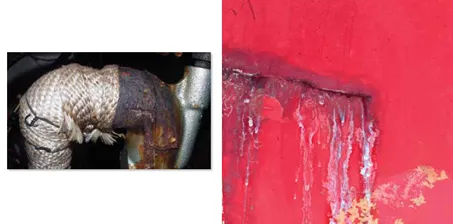
Photos by Frank Lanier
Boat buying is an exciting, maddening exercise that can test the tolerance of even the most patient sailor. Much of the maddening part has to do with trying to ferret out a boats problems before buying (and making them your own). Obviously, you should consult a reputable surveyor prior to purchase, but who can afford to have every promising boat surveyed?
The easiest way to narrow down the list of potential deals is by doing your own pre-survey inspection. Below are some of the major areas of boat inspection any buyer would want to become intimate with, as well as some common problems associated with each.
As the single most expensive piece of gear onboard, the engine deserves particular scrutiny. It is a hard lesson to learn that after purchasing that deal of a lifetime, the boat requires an engine rebuild or replacement.
How an engine looks can offer valuable clues about its overall condition. Thats not to say a shiny, seemingly new engine will be trouble free, but if its a real mess on the outside, chances are the owner hasn’t exactly been a stickler for regularly scheduled maintenance.
Start by looking for obvious problems such as leaks, excessive rust, broken or missing components, and other signs of neglect. For freshwater-cooled systems, check the coolant level and properties. Lack of antifreeze should raise red flags (due to possible leaks) as should coolant with a rusty color or an unusual amount of solids.
A lot can be told by simply pulling the dipstick and checking the oil. A slightly low level might be OK, but higher than normal levels could indicate trouble, particularly if milky or frothy; both are an indication that water, antifreeze, or transmission fluid is present, signs you could be facing anything from a blown gasket to a cracked block.
Rub a little engine oil between your fingers. If it feels abrasive or has a burnt odor, be concerned about bearing wear; however, it could also simply mean the oil hasn’t been changed regularly. Wipe the dipstick on a clean white cloth or napkin. Oil thats thick initially, but then starts to spread out over the cloth is an indication of fuel contamination.
Taking oil samples to a lab for testing is a more scientific way to analyze oil condition, but its normally most useful in tracking issues over the engines lifetime, rather than for spot-checking. Still, a one-shot oil analysis can show unusual wear and the presence of water, antifreeze, or diesel fuel. Think of it as a blood test for the engine-it may not predict a heart attack, but it can indicate the high cholesterol that could lead to engine failure.
As for transmissions and reduction gears, dark and sluggish fluid or oil with a burned smell may indicate drive cone problems and a costly rebuild in the near future. After running the engine in gear a bit, use the dipstick to get a transmission fluid sample. Put this on a piece of paper, and inspect it under a bright light or in direct sunlight for metallic specks-a sign of significant transmission wear. Inserting a long, thin magnet (the kind mechanics use to retrieve dropped bolts) through the dipstick opening and sweeping the bottom of the gearbox may produce interesting results as well.
Note how difficult the engine is to start. Depending on whether its gas or diesel, hard starting could be a sign of weak batteries, faulty plugs, or even a bad fuel pump.
Does it run smoothly at idle and under load, or does it idle unevenly and stall out when placed in gear? Rough running can be caused by anything from clogged fuel filters to compression problems, and engines idling at more than 800 rpm may have been intentionally set to idle high to mask problems.
Verify proper oil pressure and operating temperature while the engine is running. Low oil pressure could be due to anything from faulty oil pumps to cam bearing failure. High water temperatures may be something as simple as a bad impeller, but could also be caused by corroded manifolds or exhaust risers.
Finally, read the smoke signals the engine is sending. A well-maintained engine may smoke when initially cranked or while idling, but not when warmed up or under load. Smoke color can also provide an indication of problems (blue for burning oil, black for incomplete combustion, white for water vapor, etc.).
Bottom line: Remember that hour meters mean nothing (they can easily be swapped out by an unscrupulous seller) and that an owner should eagerly provide invoices if claiming overhauls or major work has been done. Engines are a big-ticket item, so always weigh the cost of repair or replacement versus walking away.
Water intrusion into cored decking likely causes more boat damage every year than sinkings, groundings, and fires combined. Cored construction simply describes an inner and outer skin of fiberglass with some other material sandwiched between them. Most all decks will be cored, typically with end-grain balsa, plywood, or maybe one of the more high-tech foam variations.
The prime directive with cored construction is keeping water out. Wet wood coring can rot, allowing the cored deck to separate, drastically reducing structural integrity. Long-term water exposure causes problems with foam-cored decks as well – core separation, freeze damage (due to expansion and contraction), and even disintegration in some cases.
Moisture intrusion into cored decking is typically caused by a combination of failed caulking and improper installation of deck-mounted hardware (cleats, lifeline stanchions, winches, etc.). Any penetration into a cored panel must be properly sealed to prevent water entry and the damage it can cause.
The first step (literally) in finding deck problems can be as simple as walking on the suspicious spots. Soft spots, oil-canning (flexing), or even water squishing from deck fittings are all indicators of a potentially expensive repair. Drips and brownish stains belowdecks are also common signs of water-soaked decks and rotting core.
Sound out the decks by tapping them with a small, plastic-headed hammer or the end of screwdriver handle. Sharp, crisp sounds while tapping are what you want, while dull thuds can be an indication of delamination. Moisture meters such as those available from JR Overseas ( www.jroverseas.com ) are also a helpful tool for sniffing out soggy decks.
Repair options are based on the cores condition, which is determined by taking a core sample (ideally by drilling a small hole in an inconspicuous place from the inside) and looking for moisture or rot. If the coring is rotten or damaged, it must be replaced. If wet, but not damaged and there is no delamination, attempts to dry out the core can be made. Just keep in mind that it is very difficult to remove all water and that any remaining moisture will likely cause future problems. Core replacement is the only sure cure.
Bottom line: While repair costs will be directly related to the size of the delaminated area, even a minor core replacement is a time-consuming project. If faced with a large amount of deck repair, move on to the next boat or be prepared to expend a significant amount of time, money, and effort to make it right.

except where noted
Standing rigging
Most sailors immediately think wire when they hear the term standing rigging, but thats only one part of the story. Your pre-survey inspection should encompass several different components, from chainplates and turnbuckles to cotter pins and terminal ends. Here are three primary standing rigging components along with possible issues to watch out for.
Wire: Broken yarns or strands (aka fishhooks) are a clear indication that rigging wire is nearing the end of its service life, even if the other strands appear good. You can check for broken strands by wrapping toilet paper around the wire and carefully running it up and down while looking for snags or shredding of the paper.
Nicks and scratches that affect multiple strands or one strand deeply should also be noted as possible cause for replacement, as should kinks, flat spots, proud strands and corrosion, particularly where the wire enters a swage fitting.
Floppy shrouds or stays should also be inspected to determine the cause of the looseness, which can indicate anything from a much needed rig tune-up to a failed mast step.
Terminal fittings: Of the various wire terminal fittings found on sailboats, swage fittings are the most common source of terminal failures.
Each should be checked carefully for signs of fatigue, proud strands (a common indication of broken strands in the swage), cracks, and corrosion. A small, handheld magnifying glass can be very helpful during this inspection. Pay close attention to lower terminals, which are particularly susceptible to corrosion as a result of salt-laden water running down the wire and inside the fitting.
Bent or banana-shaped fittings (the result of improper compression of the fitting onto the wire) are also items of concern that will need to be addressed.
Chainplates: Chainplates should be checked carefully for issues such as movement, rust, cracks, deformation of the clevis pin hole, and improper lead angle. Chainplates that penetrate the deck will often leak (due to movement and/or caulking failure), and the damage this causes, both to the interior of the vessel and the chainplate itself, can be significant.
Where chainplates are bolted to a bulkhead or other interior structure, look for discoloration, delamination, and rot due to water intrusion. Chainplates can also be compromised due to crevice corrosion, even though the metal above and below the deck appears to be in excellent condition. Crevice corrosion occurs when stainless steel is continually exposed to stagnant, anaerobic water, such as that found in a saturated wood or cored deck. This is one reason why chainplates that are glassed in or otherwise inaccessible for routine inspection are undesirable.
Bottom line: While the life expectancy of wire rigging is determined by a myriad of factors (where the vessel is located, type of stainless, amount of use, etc.), the general rule of thumb is that it should be replaced every eight to 10 years, sooner if extenuating circumstances such as offshore passages, extended cruising, racing, etc, are in the mix. While an owner may offer assurances or hazy recollections of rigging replacement, unless these improvements are properly documented, the best policy is to assume the rigging is original and plan your purchase strategy accordingly.
While steel hulls rust and wood hulls rot, blisters are what make a fiberglass boat owners hair stand on end. The Cliffs Notes version of how blisters form is simple: Water-soluble chemicals inside the laminate exert an osmotic pull on water molecules outside the hull, drawing them through the gelcoat. Once inside, the water molecules and soluble chemicals join to create a solution with larger molecules that are unable to pass back though the gelcoat. As water molecules continue to enter, pressure increases to the point that the gelcoat is pushed outward, forming a blister.
Some makes and models seem to be more susceptible to blistering than others (presumably due to factors ranging from resins used to layup schedules), but all fiberglass boats are at some risk. Location also plays a factor in some cases (i.e. relocating a vessel from cool to tropical waters, fresh to salt, etc).
The best time to spot blisters is just after the boat is hauled, preferably after the hull has been power washed and is still wet. Blisters can depressurize in a matter of hours once the vessel is hauled (minutes in some cases), making them all but impossible to spot (something to consider if inspecting a boat thats been hauled for a while).
Blisters will typically appear as circular bumps or dome-like protrusions while sighting along the hull. Sometimes water trapped between the bottom paint and gelcoat forms bumps that can be mistaken for blisters. With the owners permission, try pressing a suspected blister with a rubber gloved finger (wear goggles, as they can be under considerable pressure). If the fluid that comes out has a chemical smell, chances are its a blister.
Although hull blisters are often viewed with much dread, finding one or two blisters on an older vessel is no more serious than the occasional gouge to the hull. In these cases, spot treatment of individual blisters as they occur (grinding out to good material, barrier coating, and filling in and fairing with a suitable epoxy mixture) will normally suffice.
Far worse is the dreaded pimple rash or boat pox, where the entire bottom is covered with hundreds or thousands of blisters. Repairs in this case can involve removal of the entire gelcoat and the outermost skin-out mat to reach good laminate, then adding additional laminate to return the hull to original strength. Its an expensive repair that many yards will gladly perform, but rarely guarantee will prevent future blister formation.
Bottom line: Although rarely structurally significant, blisters may very well have a negative impact on a vessels resale value, depending on the knowledge and perceptions of a potential buyer.
Electrical systems
After years of additions, removals, misguided MacGyver-like installations, and overall abuse, probably no other system harbors greater potential for starting a fire on a used boat than the electrical system. This is just one reason both DC and AC systems deserve a thorough inspection.
Start with the batteries, which should be located in liquid tight / acid-proof containers (to contain electrolyte spills) and secured against movement (no more than one inch in any direction). Be on the lookout for equipment hard-wired without any fuse directly to the battery (a potential fire hazard) as well as crowded post syndrome (more than four wires connected to a single battery post).
Verify AC wiring is multi-strand, marine grade wire, not residential style, solid strand wire (aka ROMEX). Solid wire is not recommended for use onboard, as it is susceptible to breakage due to vibration. Your inspection should also verify that AC outlets located in the galley, head, machinery spaces, and on all weather decks are protected with ground-fault circuit interrupt (GFCI), another important safety requirement.
Check the condition of wire runs for both AC and DC systems. They should be neat, well organized, and labeled. Problems include unsupported wires, dead ends (cut wires no longer in use), corrosion, and lack of chafe protection (especially where wires pass through a bulkhead).
Youll also want to keep an eye out for electrical tape joints and household twist-on type connectors, two sure signs that Jethro has been doing a little weekend electrical work.
Bottom line: If the electrical systems are maxed out or rife with problems, play it safe by getting an estimate to make it right from a competent marine electrician before negotiating with the owner.
The more you know about potential problems and how to spot them, the more comfortable and productive your boat-buying experience will be. While the above inspection list can’t replace the practiced eye of a professional marine surveyor, it can help the average Joe make an informed decision on whether to pass or pursue the purchase of that potential dream boat.
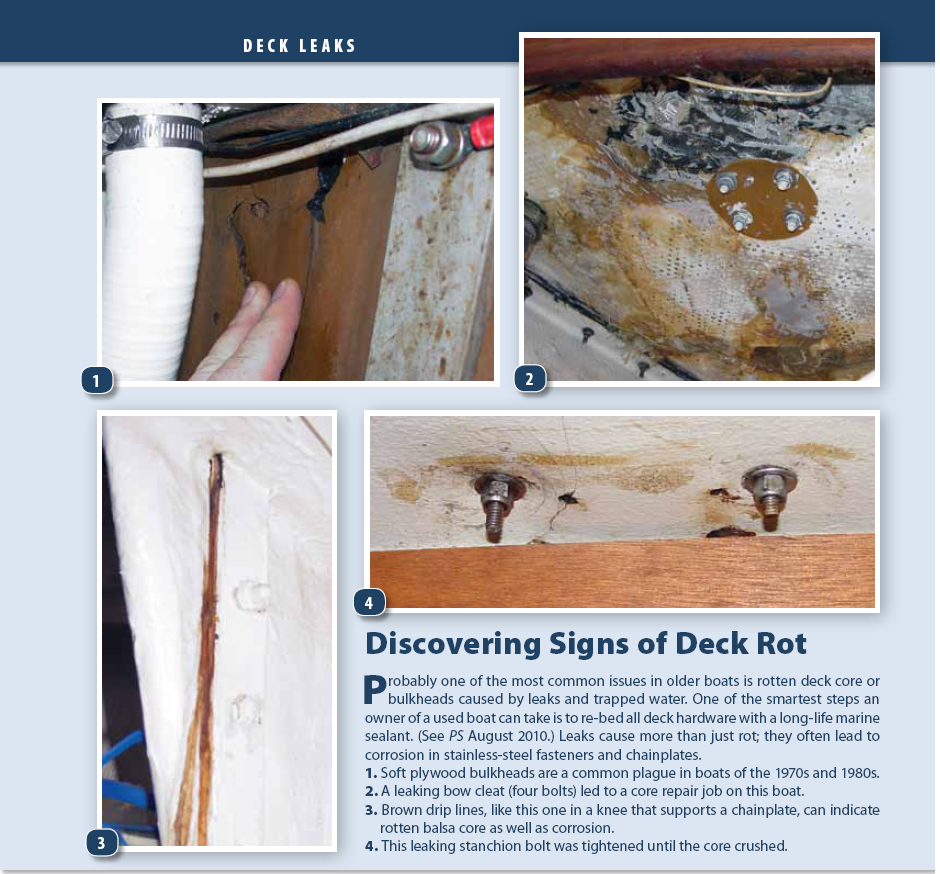
- Society of Accredited Marine Surveyors
- National Association of Marine Surveyors
- “Inspecting the Aging Sailboat,” by Don Casey
RELATED ARTICLES MORE FROM AUTHOR
You made a great point when you said that I should be on the lookout for any boats with some amateurishly fixed wiring. What with how old some used boats can be someone may have thought it better to fix old electrical components themselves rather than hire a professional which could be a potential hazard. I’m buying a boat for our family trips, and since kids will often be on board I wouldn’t want any wiring to stick out and potentially harm them or even worse, start a fire on the boat. Hopefully, I can find a good dealer that will provide me with quality used boats for sale where I won’t have to worry about matters like that.
Thanks for the informative article, Darrell.
LEAVE A REPLY Cancel reply
Log in to leave a comment
Latest Videos

Island Packet 370: What You Should Know | Boat Review

How To Make Starlink Better On Your Boat | Interview

Catalina 380: What You Should Know | Boat Review
- Privacy Policy
- Do Not Sell My Personal Information
- Online Account Activation
- Privacy Manager

So You Want to Buy a Used Sailboat: Inspecting the Boat

Steps to consider when boat shopping, inspecting a used boat, inquiring with a broker and reaching a decision to purchase a used sailboat
In my last article, I discussed the thought process one might use to decide if now is the time to buy a used sailboat . If you have made the decision to buy, then your next step will be boat shopping and inspecting potential sailboats to purchase.
By way of full disclosure, this series of articles is primarily written for the first time buyer. It is in that context that I now write about inspecting a boat you have identified as a potential acquisition.
Whether you have one or more boats under consideration, the basic questions that you confront you are:
- Is this a boat on which I can see myself?
- Is the price of this boat consistent with its condition?
- Lastly, is this THE boat for me?
Before you visit a boat, you should identify your “team”. That is the group of people with a vested interest in any boat you might purchase. That might be your spouse, financial partners, other family, or any friends who might routinely sail with you and/or help you maintain the vessel.
Not all of these people should necessarily accompany you on your first visit. At a minimum, your significant other and financial partners should be present for the first look. Your team should be able to help you answer the first two questions above…perhaps more objectively than yourself. The overall issue on your first visit is whether this is a vessel worthy of consideration.
Preparing to Visit
When you visit boats for the first time, be mindful of your time. Be sure to have enough time for a thorough inspection, particularly if you are investigating more than one boat on a given day. Ideally you will pare down your list or, better yet, conclude to proceed with one boat.
While perhaps not the most comfortable of conditions, arranging to inspect boats on a rainy day can be advantageous is the rain reveals leaks not otherwise detectable. If you have researched boats online, print out and have the data sheets and photos with you to compare the information and photos with the reality you find aboard.
If you have more than one boat under consideration, you should compare them. Keep a mental or even a physical score sheet to rate the boats in real time. The suggestions below apply whether you are seeing one or more boats.
In general, you should be reviewing everything on the boat with these thoughts in mind:
- Does this work?
- Has it been (well) maintained?
- What are the chances this will need some kind of major work in the near future?
You might say that his kind of review is what your marine surveyor would do but by the time he or she conducts a purchase survey, the window to change your mind on the purchase contract will have closed. There will be more on this in the next article on the administrative process of buying a boat. However, you may want to interview surveyors before you go shopping. If you do, you might get ideas on other things to check from those conversations.
What to Look for Walking Up to the Boat
Your visit begins as you approach the boat…or boats…from a distance. Look at the mast and rigging. Is the mast rake proper? Is there any indication of loose rigging? As you get closer, take a look at the hull, especially from abeam. Is she on her lines or is there evidence of hogging (sagging at the bow and/or stern). Does the hull-deck joint look uniform or irregular? Is the fiberglass shiny and gleaming or dull and chalky?
The latter answers could imply a vessel that has been poorly maintained or badly serviced. In either case, do not ignore the warning signs.
Inspecting the Boat On Deck
As you step aboard, what do you see? Visible corrosion on metal deck fittings suggest water leaks or compromised fittings and fasteners. While it may be normal to see very thing spider cracks in fiberglass, gaping voids or cracks packed with dirt and salt crystals warn of potential integrity problems.
Does the canvas look well maintained? Is it clean? Are the seams tightly stitched? Does water bead up on it? Are there broken threads and tears? What of the dock lines? Are soft and supple or hard and inflexible? Are the bitter ends neatly finished or unraveling? Are they of an appropriate diameter, length, and material? (Nylon or similar material stretches and absorbs shock loads making it good for dock lines. Polyester has less stretch and is better suited for running rigging.)
If the lines show evidence of wear or melting in the core, they may be old, have been overloaded, or are just old. In any case, they will need to be replaced. Signs of wear or melting could also indicate that they are undersized for their use.
Check the ground tackle. A cluttered, jumbled anchor locker speaks to the current owner’s methods and seamanship which suggest other issues are lurking. Is that anchor of an appropriate size and type for your target cruising area? Check whether the shackles are moused and if the bitter end is securely attached to the boat. What is the overall condition of the anchor rode? Is there enough chain of the right gauge?
Storage on a boat is a big issue. Be sure to inspect all of the lazarettes. They should only hold necessary gear and supplies. They should be clean and dry. Rusty gear and leaking containers are a warning sign to the buyer.
Spin the steering wheel. It should not be loose, overly stiff, or clunky. Find out it is a direct drive or a cable on quadrant configuration.
Below Deck Inspections
Now it is time to head below. As you enter, assess the companionway for ease of access and security of footing. Are there any issues if the cockpit is swamped by a wave from astern?
Now look at the space(s) before you. Does the area appear to have been well maintained? If the woodwork is in good shape, if the cushions look good, things are stored neatly, and the area is clean, there is a good chance that she is a vessel that received good care. Make similar assessments in all of the spaces below including the heads and galley. Also take note of the fit and ease of movement of the doors, drawers, and sole plates.
Inspect the Boat Systems
The most complex and expensive things on a boat are her systems. This includes propulsion, electrical systems, potable, gray, and black water plumbing, and the standing rigging. Presumably you checked the standing rigging while you were on deck. If not, do so before you leave.
Inspect the engine and transmission visually. Look at the condition of the paint. See if there are is any unusual wear or hot spot evident. Does is appear any major work might have been done (paint on nuts and bolts disturbed or mismatched color paint)? Squeeze the hoses to see if they are past their prime. Are the hose clamps in good shape and doubled up on critical connection like the thru-hull fittings? Check the belt tension and condition. The surfaces that contact the pulleys should not be hard and glazed. Check the condition of the engine mounts. Look for any oil or coolant leaks in the engine pan.
Are the bilges clean? They should be clear of debris and without oily water. The limber holes should all be clear as well. Check if the bilge pump works. There should be a switch to allow you to bypass the float switch. If the float switch is accessible, lift it to see if the bilge pump runs and cuts off as a function of the position of the float.
Is there heat or air conditioning on the boat? Is it operable? What is the overall condition of the unit? Is the intake air filter clean? Is the intake water filter clean?
Making the Decision
So…after your review and inspection, let’s assume the vessel is still of interest to you. Now is the time to engage with the yacht broker. However, it is well to remember that the broker works for the seller and not the buyer. First of all, conducting such a detailed inspection should signal your level of interest.
It is now time to ask some pertinent questions of the broker:
- Why is the boat on the market?
- How did the current owner use the boat?
- Was the boat in charter? (If yes, implies more wear and tear than normal recreational use.)
- How long has she been on the market?
- What has been the history of the list price and any bids made to date?
- Are any maintenance and repair records available?
- Is there anything else I should know?
Beware of dodgy answers or avoidance. Simple, straight answers are best but again, keep in mind that the broker works for the seller.
If after you receive acceptable answers to all of your questions, it is time to take a step back to consider your decision. If you still want to proceed, I personally recommend gathering the friends and family who will sail with you and help you maintain your boat. Keep it to 2 or 3 people at most.
Make another visit to the boat to go over it with your team. However, this time and if you have not already done so, go with flashlight, tape measures, inspection mirrors, and a notebook. Got through EVERY space, EVERY compartment, EVERY locker and EVERY accessible void on the boat. Inventory all of the equipment you find. Look for any evidence of leaks, spills, issues of structural integrity, and outright damage. If they do not dissuade you, they should at least factor into your purchase offer. If your bid falls significantly below the asking price, you may be able to use your findings as justification.
Drop the Other Shoe…
If the owner accepts your offer or if you accept the owner’s counteroffer, it will be time to get your hustle on! Remember that you generally have 3 days to change your mind once you sign a purchase contract.
In this article, I have suggested how one might make an inspection of a sailboat that being considered for purchase. I have suggested people to involve in that process. Throughout this series I use the experience of buying my own boat as reference material. In the next and final installment, I will discuss the practical and administrative aspects of completing a vessel purchase. This will include price negotiations, loan considerations, documentation, and ways of offsetting expenses.
Here are some good resources to help you with your decision making process for buying a used sailboat:

“Here’s a book for first-time sailboat buyers that offers practical information they can really use to ease the transition to boat ownership. The buying guide to 84 of the more popular used sailboats will be particularly helpful when making the rounds at the boatyard.” — Cruising World

Sailboat Buying Guide – Things To Consider When Buying A Sailboat Without Sinking Your Finances! Here in this exciting narrative, we outline for you exactly what you need in order to be a successful buyer and sailor of a sailboat.

Step by step, the author of the bestselling This Old Boat shows you how to evaluate the condition of an older fiberglass sailboat – the one you own or the one you’d like to purchase.
Love the boat life? Check out these picks for your boating lifestyle:
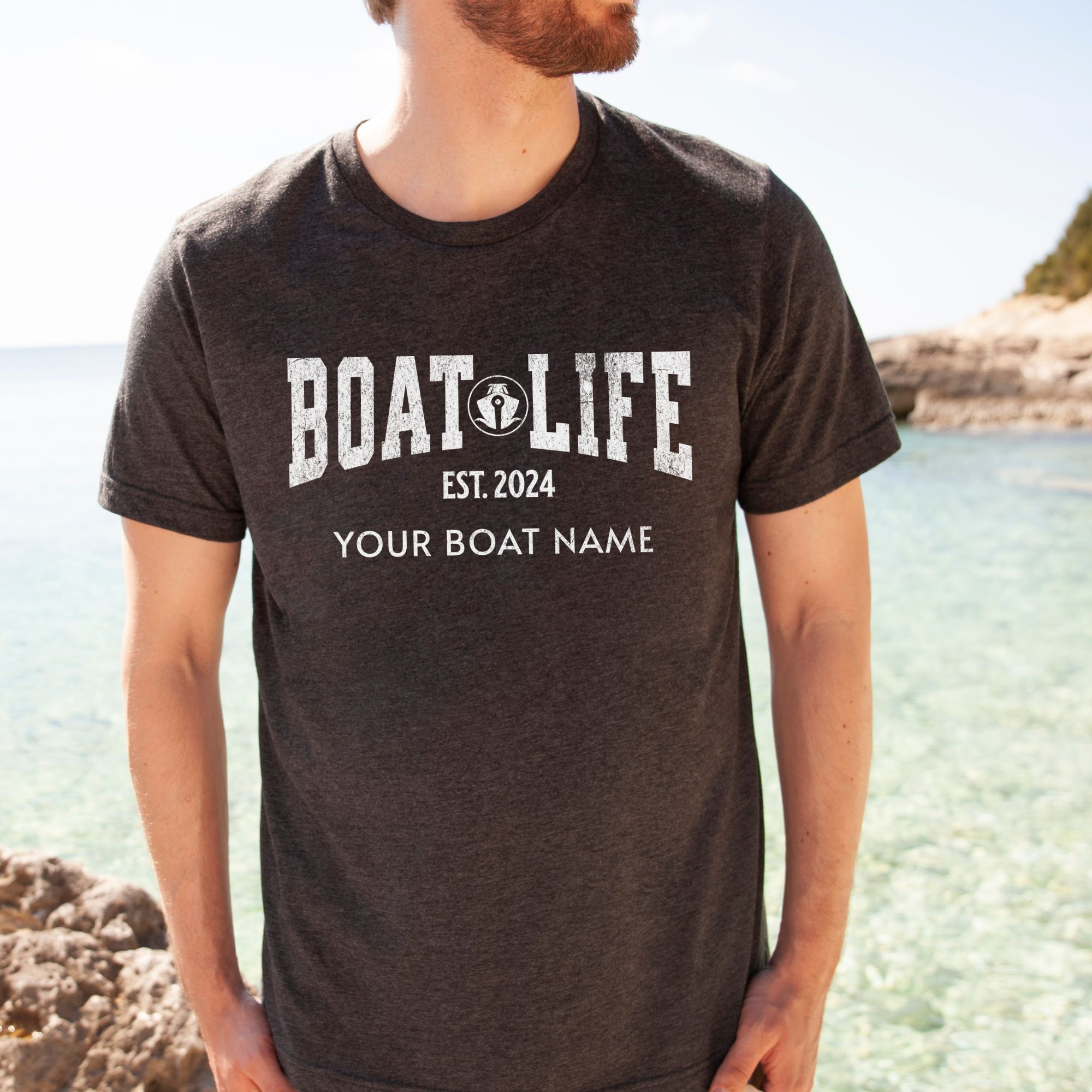
Boat Life Custom Boat Name & Est Year T-Shirt
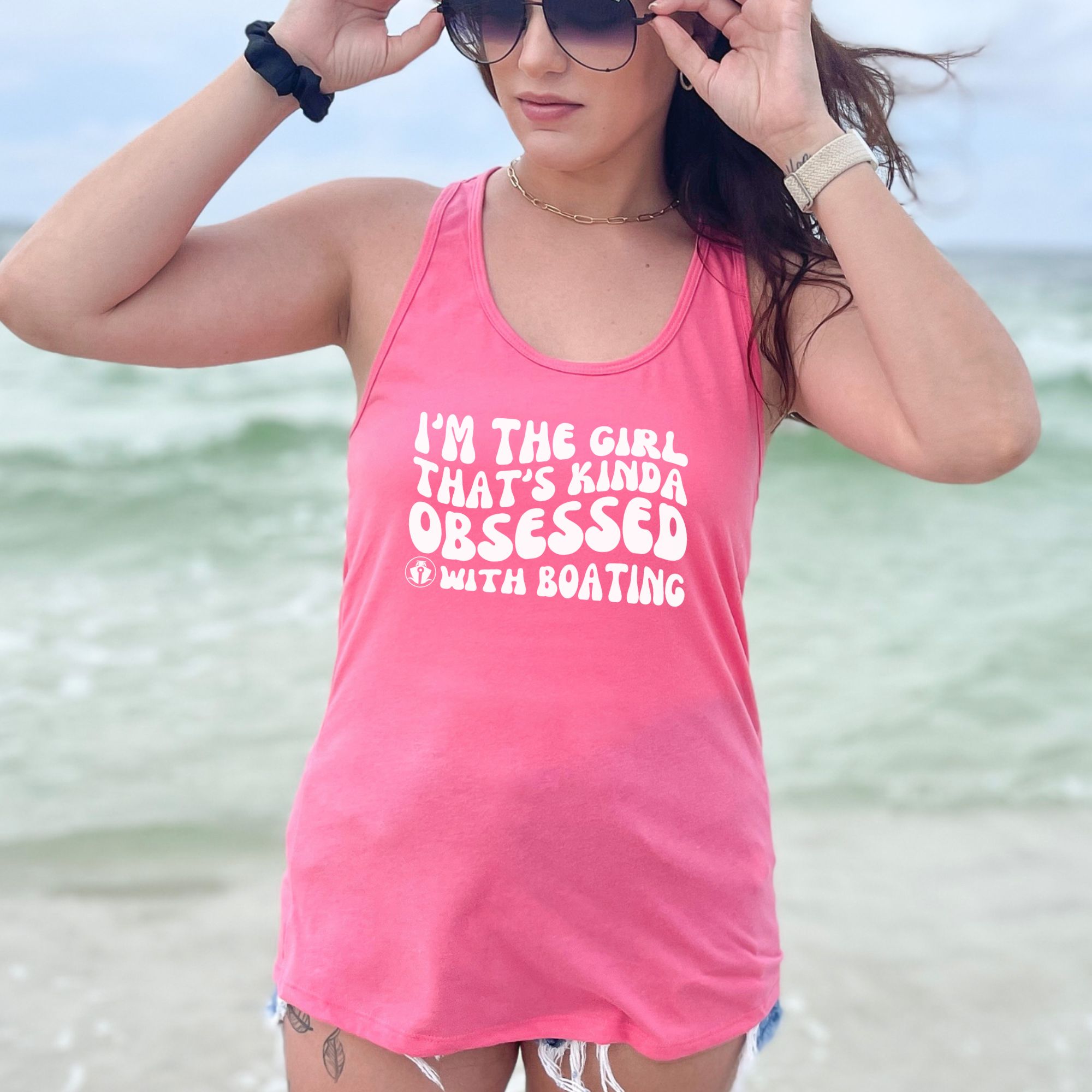
Girl Obsessed with Boating Women’s Tank Top
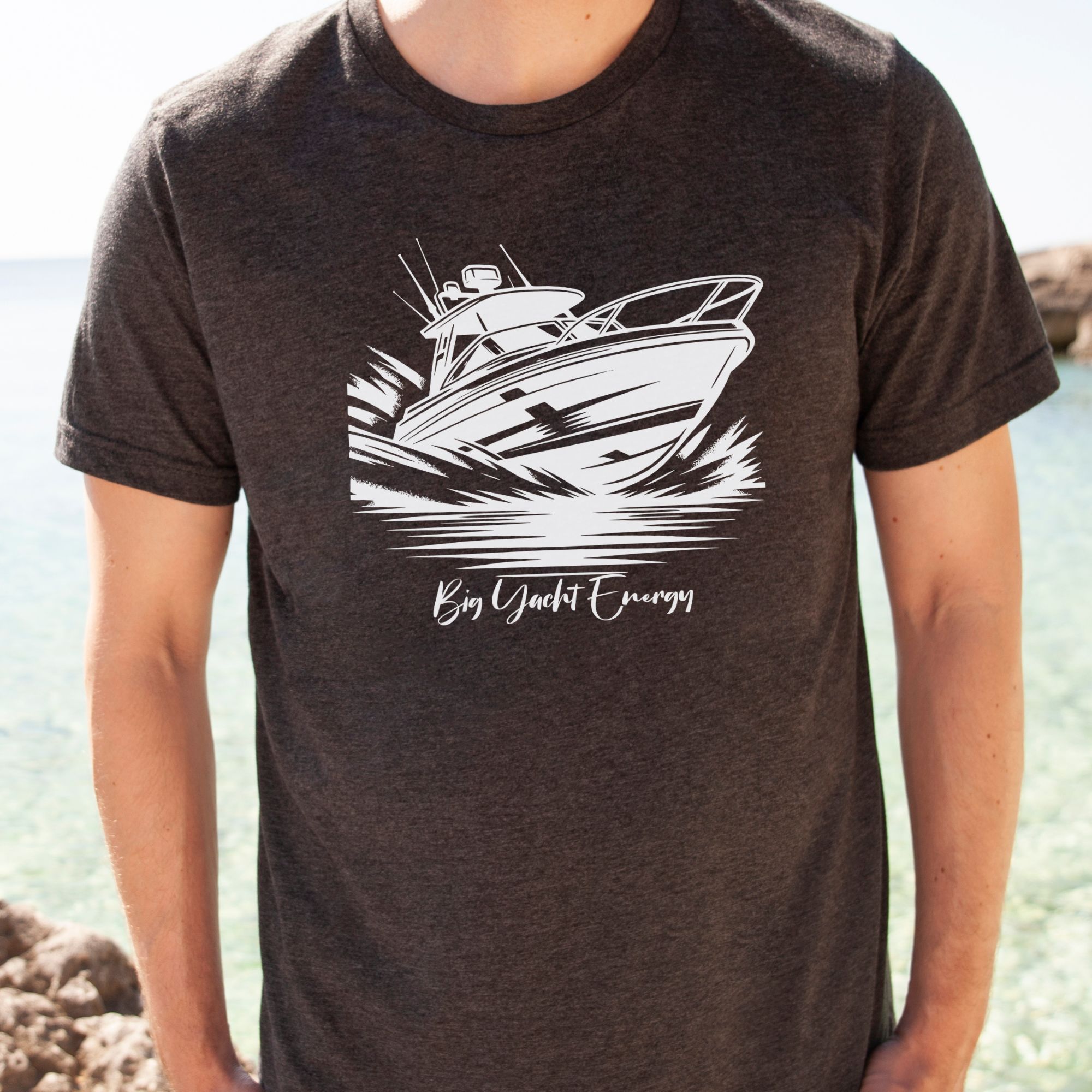
Big Yacht Energy Boat Shirt
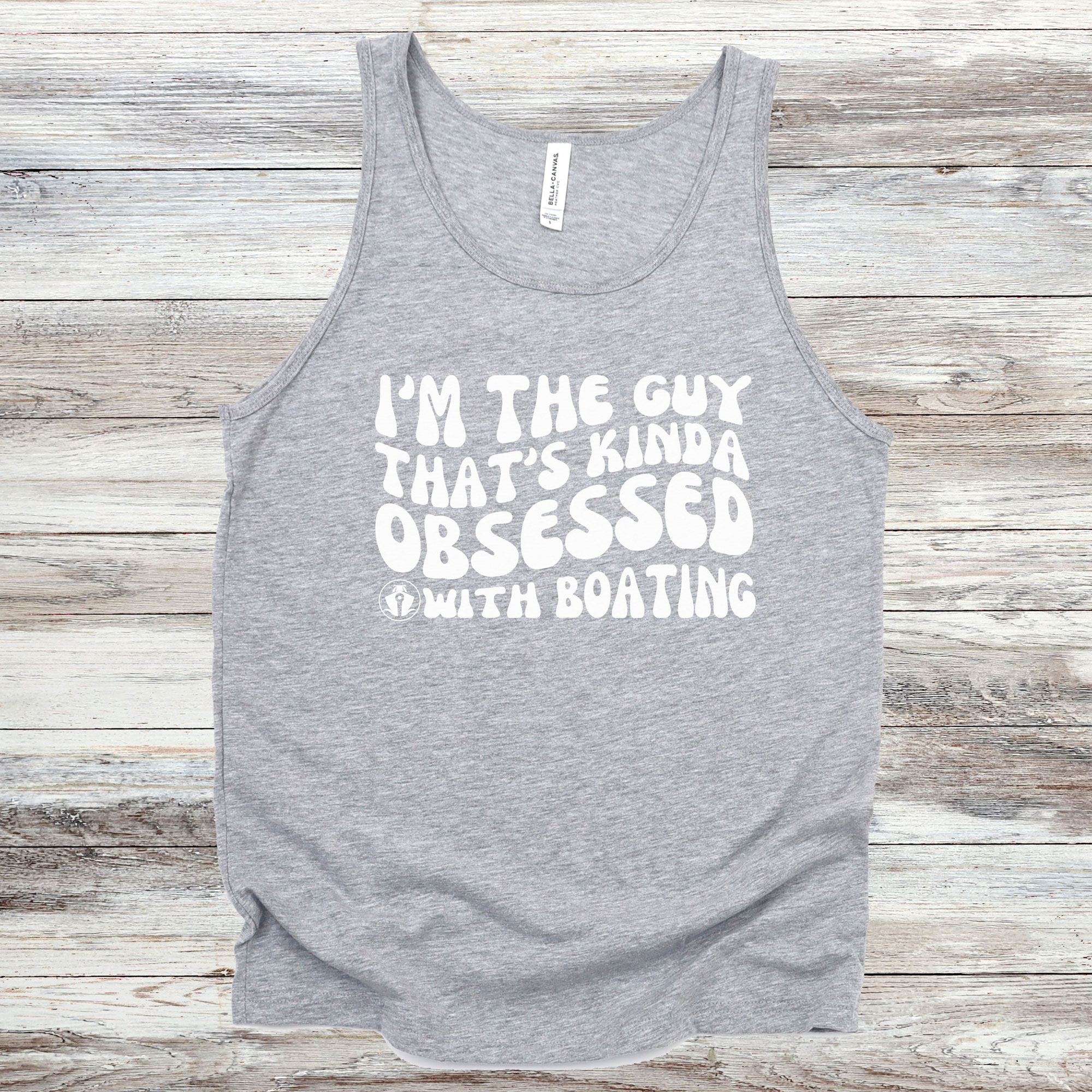
Guy Obsessed with Boating Men’s Tank Top

Capt. Rob Chichester
Related posts.
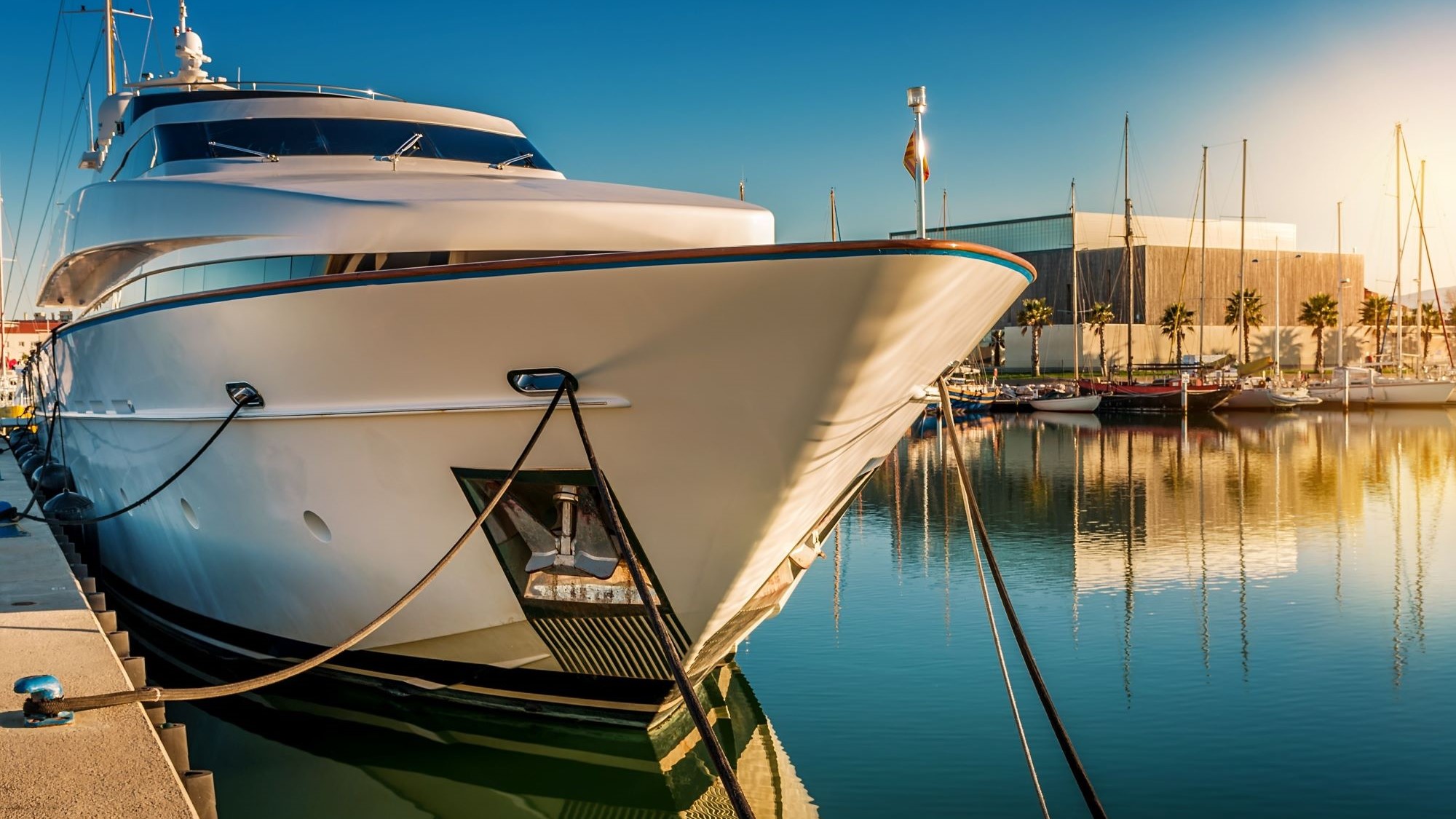
How To Transport A Yacht Safely
April 7, 2023
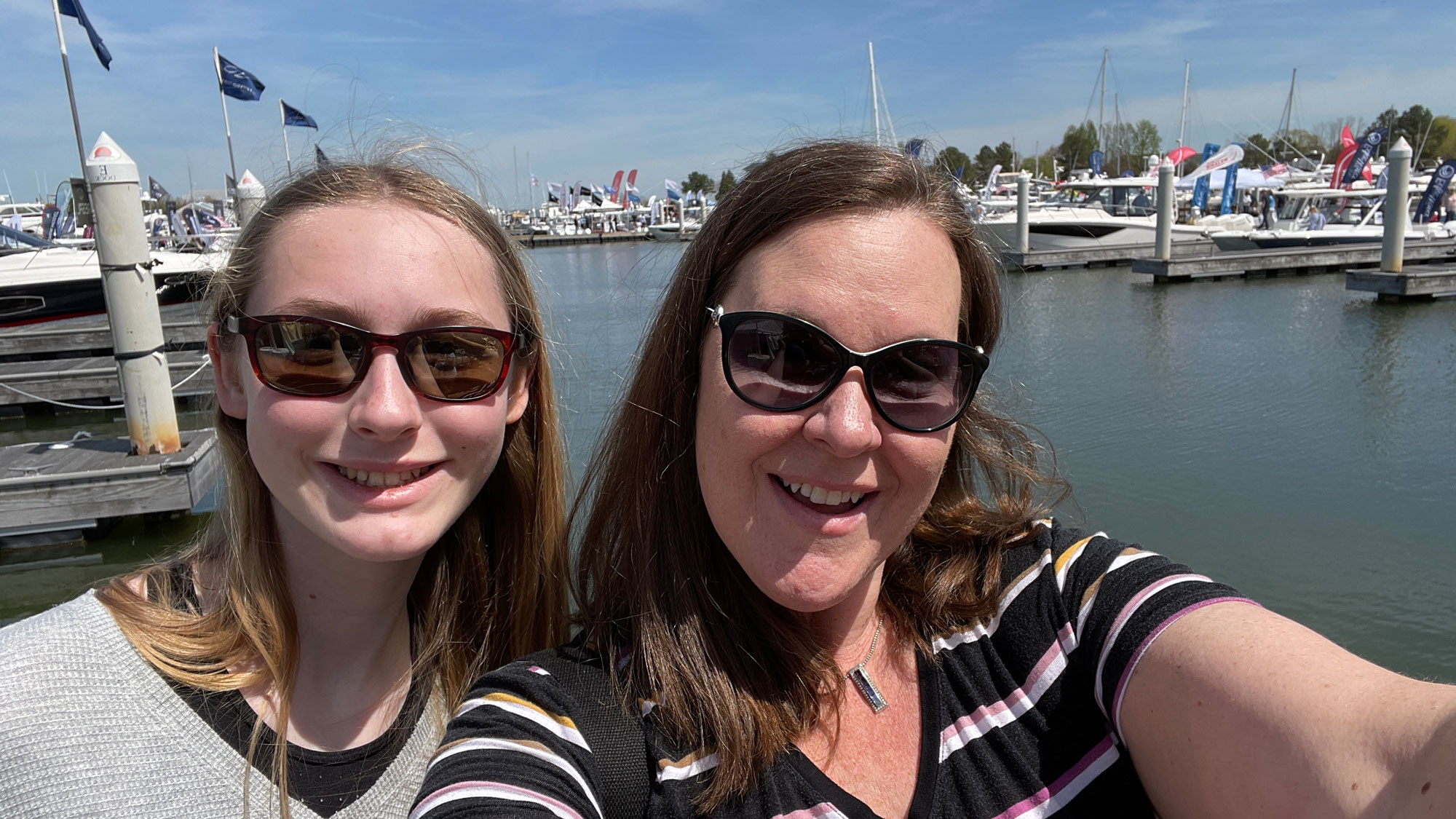
Our Daughter’s First Boat Show Experience at 2022 Bay Bridge Boat Show on the Chesapeake Bay
April 25, 2022

New Yachts vs Used Yachts: The Pros and Cons of Each
February 14, 2022
Used Boat Buying Guide (Checklist Included)
When buying a used boat, it is important to ensure the vessel is in great condition and there are no issues.
Whether buying a pre-owned boat from a private seller or a boat dealership, a boat buyer should know what to look for and be able to inspect the vessel thoroughly.
To buy a used boat:
- Find a pre-owned boat for sale
- Inspect the used boat with a checklist
- Perform a sea trial
- Check the boat title and lien history
- Negotiate the price
- Organize a payment method with the seller
- Draft a bill of sale
These instructions apply to a boat buyer purchasing any type of used vessel from sailboats to yachts and pontoons.
1. Find A Pre-Owned Boat For Sale
The first step of the used boat buying guide is to find a used boat for sale.
To find pre-owned boats for sale:
- Browse Facebook marketplaces : Local Facebook marketplaces will have used boats for sale. Browsing Facebook marketplaces to find used boats is free to do
- Check boat classified websites : There are 3 main boat classified websites to find used boats which are boats.com, boattrader.com, and youboat.com. These are free boat classified websites to find used boats
- Contact local marinas : Contact local marinas and ask them for information on used boats for sale. Most likely, they will have information regarding all pre-owned boats for sale in your local area. This is free to do
- Check boat magazines : The 2 main magazines to find used boats for sale are Boat Trader magazine which is published monthly and costs $12.99 per issue and Classic Boat magazine which is published monthly and costs $9.99 per issue
- Visit a boat dealership : Visit a local boat dealership and check out their pre-owned boats. Boat dealerships will typically have the best quality pre-owned boats for sale
- Attend boat auctions : Attend boat auctions to find pre-owned boats for sale. Buyers can potentially find large savings at boat auctions
Choosing the right type of used boat will vary from one buyer to the next. Some buyers will prefer a pontoon whereas others may like a sailboat. It is a matter of preference.
Ensure that the pre-owned boat picked to buy is NMMA certified and within your budget, location, and capabilities.
An NMMA-certified boat is a boat that is built to certain higher standards set by the American Boats & Yacht Council (ABYC). A buyer can find an NMMA-certified sticker on the capacity plate of a boat.
If a boat has this NMMA-certified sticker attached to the boat, it means the vessel is certified. If it does not have this NMMA-certified sticker, it means the vessel is not NMMA certified.
Used boats for sale can be found in under 1 minute on boat classified websites and the Facebook marketplace. Used boats for sale can be found within 2 weeks if ordering a boat classified magazine online.
Boat classified websites, local marinas, boat magazines, boat auctions and marketplaces will offer used sailboats, yachts, pontoons, motorboats, catamarans, dinghies, speed boats, houseboats, etc. for sale for all budgets from $1,000 to over $1 million.
The most popular methods of finding a pre-owned boat to buy are browsing the Facebook marketplace and browsing boat classified websites.
The least popular method of finding a pre-owned boat to buy is contacting your local marina for information on used boats for sale as this is slower and it doesn't usually offer many boat options.
The best method for finding a pre-owned boat is by browsing boat classified websites like boattrader.com or boats.com as there are multiple boat makes and models for sale on these websites and plenty of choices for boat buyers.
2. Inspect The Used Boat Thoroughly
The second step of the used boat buying guide is to inspect the used boat thoroughly.
There are two methods of inspecting a pre-owned boat which is to hire a professional marine surveyor or manually inspect the vessel using a marine inspection checklist to follow.
Hiring a professional marine surveyor costs between $15 and $25 per foot. Manually inspecting the boat with a checklist is free to do.
The benefits of hiring a marine surveyor are they are professionals with plenty of experience in evaluating a boat's condition and they will spot potential problems with a used boat faster than someone with no experience.
The benefit of following a marine inspection checklist is that it will help potential buyers to make a preliminary evaluation of the boat's condition for free.
The most popular method of inspecting a used boat before buying it is by using an inspection checklist and manually checking the boat yourself.
To inspect a boat manually, follow a used boat inspection checklist.
Used Boat Inspection Checklist
Below is a used boat inspection checklist to follow.
Get a printable boat inspection checklist pdf below.
Get A Free Used Boat Buying Checklist
Use this inspection checklist when assessing the condition of the used boat.
Some items on the inspection checklist can be ignored when they do not apply to the specific used boat being viewed.
The entire boat should be inspected before buying it including the stern, starboard, port and bow exterior and interior. The safety equipment, electronics, and legal documents should be inspected too.
3. Perform A Sea Trial
The third step of the used boat buying guide is to perform a sea trial.
A sea trial is taking the boat out on the water to test out its capabilities and ensure it is functioning properly with no issues. It is an important part of the boat-buying process.
To perform a sea trial:
- Run the engine at idle to assess whether there are any stuttering or engine issues. Running an engine at idle is achieved usually at 600 - 800 rpm
- Bring the boat to cruising speed, usually 5 knots, and steer the boat both port and starboard to ensure the steering system is operating properly
- Check the cockpit for any electronic warnings or alerts
- If it's a sailboat, check how the rigging system operates under sail
- Test the chart plotter/GPS electronics as you travel through the water to ensure it is functioning properly
- Increase the boat to full throttle where it is safe and assess how the engine reacts. A boat at full throttle is approximately 4,600 to 6,000 rpm. At full throttle, the boat motor should not be smoking heavily or making unusual noises
- Press the boat horn to ensure it works properly
- Listen carefully for any unusual sounds or noises onboard for the entire sea trial
Performing a sea trial on a boat will take approximately 25 minutes to complete. However, this timeframe can vary based on the size of the used boat.
The benefits of performing a sea trial are it lets a potential buyer test the speed, maneuverability, comfort, steering, and sounds, it will highlight potential issues that may have been missed in the initial inspection and it will allow a boat buyer the ability to assess the boat's seaworthiness.
One risk with performing a sea trial is the potential buyer may not be familiar with the operation of the boat they are interested in purchasing so they will not get the full benefits of the sea trial. To mitigate this risk, bring the current boat owner on the sea trial.
A buyer should note that if the boat seller does not want to do the sea trial, this is a major red flag and should signal to the buyer to avoid buying the specific boat.
Performing a sea trial is free to do.
4. Check The Boat Title & Lien History
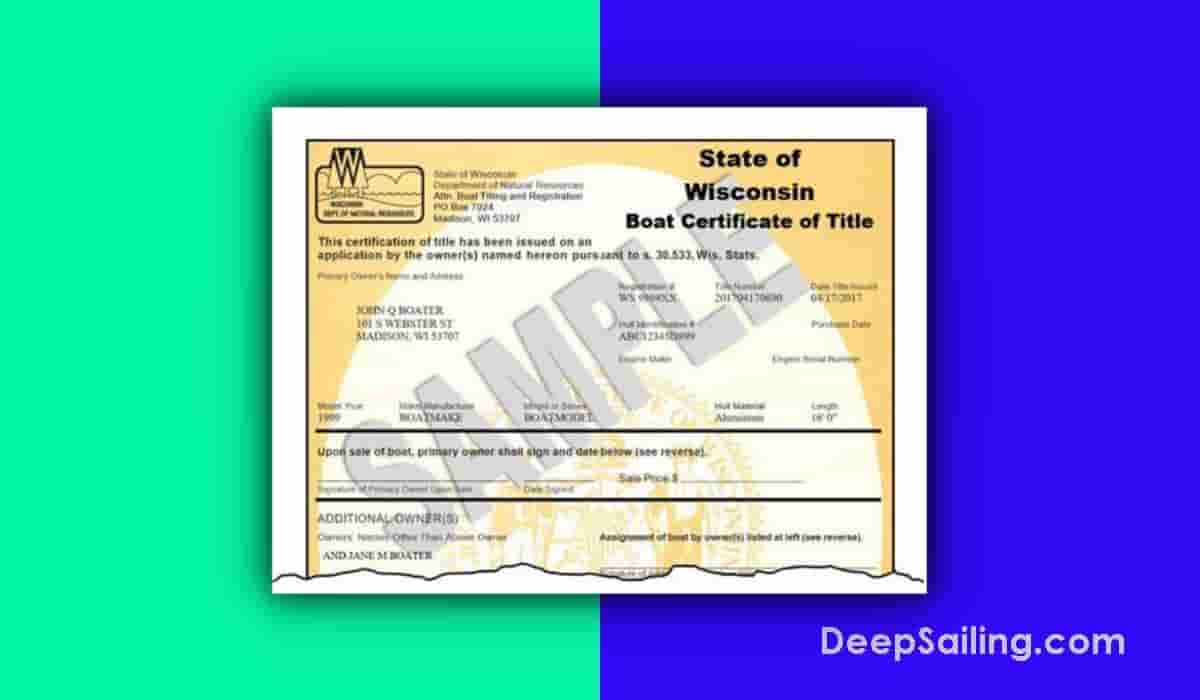
The fourth step of the used boat buying guide is to check the boat title and lien history.
The boat's title is a legal document that proves ownership of a boat. It is necessary for the transfer of ownership from one person to another. The boat title includes information such as the make and model of the boat, the manufacturer, the Hull Identification Number (H.I.N.), the name and address of the owner, and any liens or encumbrances on the boat.
A boat title must be transferred whenever the boat is sold from the seller to the buyer.
A boat lien is a legal claim on a boat as security for a debt. It means that the boat cannot be sold or transferred without first paying off the debt.
To check the boat title of a used boat, simply ask the current owner for the boat title to assess it or get one posted to you from the U.S. Coast Guard.
To check the lien history of a used boat:
- Obtain an abstract of title : The US Coast Guard Abstracts of Title offers a comprehensive overview of a vessel's lien information including a detailed history of ownership and all current and resolved liens/debts. Obtaining a vessel's abstract of title through the U.S. Coast Guard can be done here . It costs $75 and takes 3 business days to complete
- Check the boat lien claims registry : Buyers can search the boat lien claims database from marinetitle to see if there are outstanding liens on a boat. This is free to do
- Check state vessel records : A used boat buyer can check the states vessel records of the state where the boat is registered to see if there are any outstanding liens on the boat. This costs $50 and takes up to 5 business days to complete
The benefits of checking the boat title and lien history are it will provide the buyer with legal proof of who owns the boat and it will ensure there are no outstanding debts on the boat that a new buyer may be liable for.
The most popular methods of checking a boat's lien history are to check the boat title for lien information and check the state vessel records for lien information.
5. Negotiate The Price
The fifth step of the used boat buying guide is to negotiate the price.
To negotiate the price of a used boat:
- Perform market research : A buyer should compare the price of the used boat they are interested in with similar vessels for sale on the market. This can enable them to get a lower price for the vessel when comparing it to other similar vessels on the market
- Point out defects or issues : If the boat has any defects or issues such as worn-out equipment, outdated electronics or damage to the hull, you can use these as leverage to negotiate a lower price. This can result in up to a 10% reduction in the price
- Be willing to walk away : A buyer should not be afraid to walk away if the seller is not willing to negotiate or if the price is too high. Showing that you are willing to walk away can sometimes encourage the seller to be more flexible with the price
- Be prepared to compromise on the price : Negotiation is a two-way street so be prepared to compromise on certain aspects of the sale such as the closing date, delivery options, or the inclusion of certain equipment or accessories
- Offer to pay fast (within a day) : Offering to pay for the boat fast can sometimes sway a seller to offer a lower price for the boat. If you can pay quickly, make this clear in the negotiations as the seller may be more willing to sell at a cheaper price
The benefit of negotiating the price is a buyer may be able to save money, sometimes 10% and 20% of the original price of the boat.
Negotiating the price of a used boat can take anywhere from 10 minutes to a 3-5 days for more stubborn sellers.
6. Organize A Payment Method With The Seller
The sixth step of the used boat buying guide is to organize a payment method with the boat seller.
The three main payment methods when purchasing a used boat are:
- Paying with cash : Cash is used to pay for boats. However, this method should be avoided as it is riskier with less payment protection should an issue arise. Paying with cash has no fees
- Paying by bank transfer : Paying for a boat by transferring money from the buyer's bank to the seller's bank account is a common method of paying for the used boat. This is a safer option as it offers some buyer protection should an issue arise. Paying by bank transfer may have fees depending on the bank but it is typically under $5 in most cases
- Paying by bank draft : Paying by bank draft is the most common and popular method of buying a pre-owned boat. This payment method offers some protection for the buyer should a problem arise. Paying by bank draft will typically have fees of $2 to $5 but this will depend on the bank
Paying for a used boat with cash is instant whereas paying by bank transfer or a bank draft can take up to 5 business days to complete.
The benefit of paying for a used boat by bank transfer or bank draft is it leaves a receipt and proof of payment which can offer the buyer payment protection.
Paying with cash does not offer the buyer any payment protection or proof of purchase if something goes wrong.
The most popular payment method when paying for a pre-owned boat is paying by bank draft.
The payment methods that should be avoided when paying for a used boat are paying with cash or cryptocurrency as there is less protection for the buyer if a problem arises using these payment methods.
7. Draft A Bill Of Sale
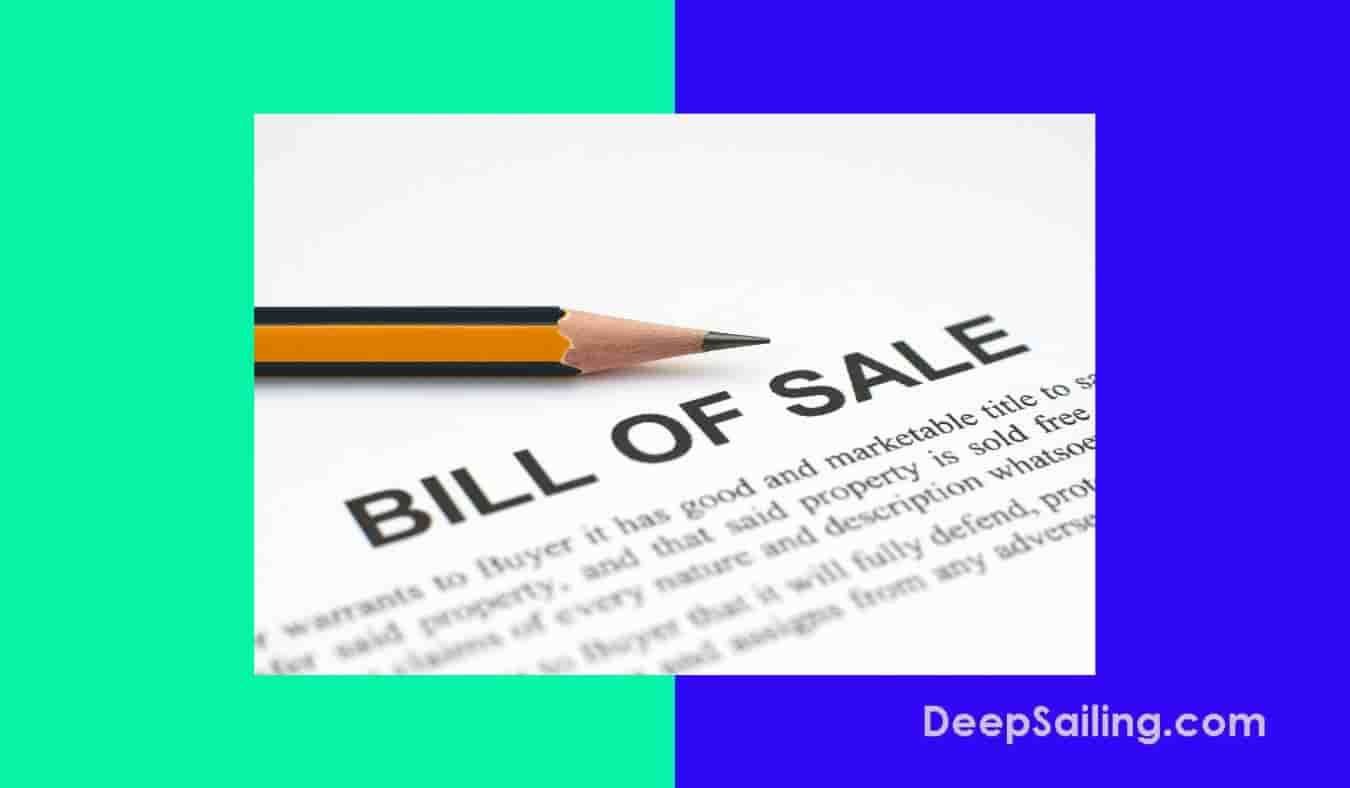
The seventh step of the used boat buying guide is to draft a bill of sale.
A boat bill of sale is a legal document that records the change of ownership of a watercraft from the seller to the buyer. The boat bill of sale includes buyer, seller, boat and sale information with signatures from the buyer, seller, and a witness.
There are two ways of drafting a boat bill of sale which are filling in a bill of sale template or having a lawyer draft the bill of sale.
The most popular method of drafting a bill of sale is to have a lawyer draft the bill of sale for you.
The average cost to have a boat bill of sale drafted by a lawyer is $350. A bill of sale legal template to follow is free to use.
A benefits of a boat bill of sale are:
- Proof of ownership : A bill of sale provides written evidence of the transfer of ownership from the seller to the buyer, which is important when establishing legal ownership and registering the boat.
- Protection : The bill of sale can help protect both the buyer and the seller in case of disputes or legal issues that may arise after the sale.
- Clarifies transaction details : The bill of sale can clarify important transaction details, such as the purchase price, payment method, and any warranties or guarantees that may have been provided.
- Compliance : A bill of sale may be required by law in some states or countries, making it necessary to have one to complete the transaction and comply with legal requirements.
- Peace of mind : Having a written agreement in place can provide peace of mind for both the buyer and the seller, knowing that all the necessary details of the transaction have been documented and agreed upon
Below is a sample bill of sale.
Bill Of Sale Example
Date: [insert date of sale]
Seller Information:
Name: [insert seller's name]
Address: [insert seller's address]
Phone: [insert seller's phone number]
Email: [insert seller's email address]
Buyer Information :
Name: [insert buyer's name]
Address: [insert buyer's address]
Phone: [insert buyer's phone number]
Email: [insert buyer's email address]
Boat Information :
Make: [insert boat make]
Model: [insert boat model]
Year: [insert boat year]
Hull I.D. number: [insert hull ID number]
Registration number: [insert boat registration number]
Sale Details :
Purchase price: [insert purchase price]
Payment method: [insert payment]
Payment terms: [insert payment terms]
Warranties/guarantees: [insert any warranties or guarantees provided]
I, the undersigned, seller, certify that the above information is true and accurate to the best of my knowledge. I further certify that I am the legal owner of the boat described above and have the authority to sell it.
I, the undersigned, buyer, acknowledge that I have carefully inspected the boat and accept it in its current condition. I further acknowledge that I understand and accept the terms of the sale as described above.
Seller's Signature: [insert seller's signature]
Buyer's Signature: [insert buyer's signature]
Witness Signature: [insert witness signature]
Note: This is just a sample bill of sale and may need to be modified to meet your specific needs or legal requirements. It's always recommended to consult with a lawyer or legal expert when drafting important legal documents like a bill of sale. This sample bill of sale should be used as a guide and not a legally binding document.
Frequently Asked Questions About Buying A Used Boat
Below are the most commonly asked questions about buying a used boat.
How Do You Protect Against Fraud Or Scams When Buying A Used Boat?
To protect against fraud or scams when buying a used boat, ensure the seller has a valid boat title when assessing the boat, insist on performing a sea trial, check the boat lien history, thoroughly inspect the boat using a boat inspection checklist or by hiring a marine surveyor and only pay for the boat using a proof of payment method like a bank draft.
What Are Tips For Buying A Used Boat?
Tips for buying a used boat are:
- Always perform a sea trial to fully test the vessel
- Understand the maintenance requirements of the boat before purchasing it
- Check the lien & boat title
- Check the hull i.d.
- Check the boat motor serial number and compare it with details provided by the boat engine manufacturer
- Use a boat inspection checklist to thoroughly assess the boat prior to purchase
- Ensure there is a towing trailer capable of towing the boat available before making the purchase
- Do not pay with cash
- Only purchase a boat you are capable of operating
- Check similar boats for sale to compare prices and understand what is the true retail value of the used boat
- Understand where the boat will be stored before buying it and ensure there is sufficient storage space
What Are The Benefits Of Buying A Used Boat?
The benefits of buying a used boat are:
- Cost savings : Buyers can find much cheaper used boats compared to new ones which will help them to save money. Savings can range from 20% to 60% compared to a brand-new price
- Large depreciation avoided : New boats typically experience a significant drop in value in the first few years of ownership. Buying a used boat can help you avoid this initial period of rapid depreciation
- Established resale value : Used boats often have an established resale value which makes it easier to determine the value of your boat if you decide to sell it in the future
What Are The Risks Of Buying A Used Boat?
The risks of buying a used boat are:
- Getting scammed : Buyers have a risk of being scammed. While there are ways to reduce the risk of getting scammed, certain sellers may still try to scam the buyer. Buyers should be aware of this and prepare to mitigate the risk by following the instructions in this article
- Paying too much for a boat : New buyers may not understand the true retail value of a pre-owned boat. Due to this, new buyers may overpay for the boat
- Buying a damaged boat : New buyers may not find damage when performing the initial inspection and end up with a used boat with lots of damage. If a buyer is not confident in their inspection abilities, it is recommended to hire a professional marine surveyor to help mitigate this risk
- Buying a boat you are not capable of operating : Some buyers are very enthusiastic to get a new boat. They may purchase a boat they are not capable of operating due to a lack of boating skills. To mitigate this risk, perform a sea trial prior to purchasing to see how good you are at operating it
What Should Be Avoided When Buying A Used Boat?
When buying a used boat, avoid:
- Paying with cash : Buyers should avoid paying the seller with cash as there is little protection for the buyer with this payment method
- Buying a boat without a sea trial : Buyers should avoid buying a used boat without doing a sea trial. A sea trial can identify potential issues that may be missed from visual inspections
- Buying the boat without the boat title : A boat buyer should avoid paying for the boat without seeing and having the boat title transferred to them. The boat title is a legal document that confirms the buyer to be the legal owner of the vessel
- Buying a boat in poor condition : A boat buyer should avoid buying a used boat in poor condition as it can cost a substantial amount of money to repair the boat
- Buying a boat without knowing where to store it : A boat buyer should avoid buying a boat before knowing exactly where to store it
- Paying without seeing the boat in person : A boat buyer should avoid paying for a boat without seeing it in person as the pictures and the boat listing can be fake
What Questions Should A Buyer Ask The Seller When Buying A Used Boat?
The questions a buyer should ask the boat seller are:
- What are the costs of repairing the boat?
- What ongoing maintenance and upkeep will the boat require?
- What is the cost of filling the boat with fuel?
- How long have you owned the boat?
- What is your preferred payment method?
- How many hours are on the engine?
- Has there been any major damage on the boat in the past?
- Has the boat been involved in any accidents in the past?
- Are there any liens on the boat?
- Can I see the boat title?
- What's the boat's overall condition?
- What equipment and accessories are included with the boat?
- What is the boat's maximum speed and cruising speed?
- Is the boat still under warranty, and if so, what is covered?
- What is the boat's fuel consumption rate and tank capacity?
- How many hours has the boat been used and how was it typically used?
- What type of maintenance and repairs have been done on the boat and when were they done?
- Can I see the repair receipts?
- What is the storage/mooring cost of this boat?
- Are there any reoccurring problems that arise with this boat?
Is It Safe To Buy A Used Boat From A Private Seller?
It is safe to purchase a used boat from a private seller provided the buyer thoroughly inspects the vessel, checks the boat title and lien history, has a proper bill of sale, and uses a safe payment method like bank transfers or bank drafts.
How Do You Pay For A Used Boat Safely?
To pay for a used boat safely, pay through a bank transfer or bank draft. Paying by bank transfer or bank drafts leaves a record of the payment which can be used if a problem arises in the future.
How Long Does It Take To Buy A Used Boat?
Buying a used boat takes from 1 week to 1 month to complete for most boat purchases. However, this timeframe will vary based on the availability of the money needed to make the purchase, the payment method used, and the location of the boat.
What Are The Costs Associated With Buying A Used Boat?
The costs associated with buying a pre-owned boat include the cost to the boat itself, the fees for hiring a marine surveyor (where applicable) which is approximately $15 to $25 per foot, banking fees for transferring money from the buyer to the seller bank account which is typically 0.5% to 1% of the purchase price and potential legal fees for drafting a bill of sale and transferring the boat title which is approximately $350.
If the boat is purchased through a boat broker, there will also be boat broker fees which can range from 5% to 10% of the boat's selling price.
What Are The Legal Considerations To Be Aware Of When Buying A Used Boat?
The legal considerations to be aware of when buying a used boat are the bill of sale document which acts as a legally binding document of proof of transfer from the seller to the buyer, the boat title document which highlights the current legal owner information, and boat tax obligations when owning a boat which will vary from state to state.
What Are Scams To Be Aware Of When Buying A Used Boat?
Common scams to be aware of when buying a pre-owned boat are:
- Online sales scams : Be cautious when purchasing a boat online. Scammers can create fake listings using pictures and information of a legitimate boat and offer it at an attractive price. They may request payment through untraceable methods or ask for a down payment before disappearing with the money. Never buy a boat without seeing it in person
- Boat title scams : Some sellers may offer a boat with no title or a fake or forged title. Without a valid title, it can be difficult to prove ownership, register the boat, or get marine insurance. Check the boat title with the U.S. Coast Guard to ensure it is legitimate
- Stolen boat scams : It's possible that the boat being sold is stolen. The seller may not have legitimate proof of ownership or may be trying to sell a boat that has been reported stolen
- Damaged boat scams : Scammers may try to hide the damage of a boat or misrepresent its condition in order to sell it for a higher price. They may conceal defects, provide false information about the boat's history or maintenance records or mislead buyers in other ways
What Are The Most Popular Type Of Used Boats To Buy?
The most popular type of used boats to buy are sailboats, pontoons, and motorboats.
What Are The Least Popular Tpye Of Used Boats To Buy?
The least popular type of used boats to buy are barges and houseboats.
- Articles and Guides
Boat Inspection Checklist: How to Inspect a Boat Before Buying
6th dec 2023 by samantha wilson.

Buying a boat, whether it’s new or used, big or small, is a major decision both financially and personally, and here at Rightboat we know that as well as anyone else. We’re here to walk you through every step of the process, and recommend you begin with our in-depth and comprehensive article How to Buy a Boat: The Ultimate Guide as well as learning what others got wrong by checking out the 9 Mistakes to Avoid when Buying a Boat .
There are differences when it comes to buying new and used boats; conducting inspections and knowing what to look for when buying a used boat are vital. Fresh out of the factory, boats won’t require this and will come with warranties to ensure everything is as it should be. When it comes to used boats, however (whether you’re buying a used boat from a private party or a broker), inspections are vital to make sure you’re buying a sound boat and spending your money wisely. There are many steps to buying a used boat , and viewing a boat you’re interested in is the very first one. It will give you that all-important first impression of the condition of the boat, at which point you decide to forge ahead or walk away. We highly recommend getting a complete marine survey done on any boat you’re considering buying, as experienced surveyors will know the problems to look for and where to find them.
But before you get to the stage of paying for a marine survey, have a read through our 7 Hidden Problems to Check for When Buying a Used Boat and use this checklist as a guide to make a thorough boat inspection before purchase.

Conducting inspections and knowing what to look for when buying a used boat are vital.
Pre-Inspection Checklist
- Ask to see servicing and maintenance records. Knowing a boat has had regular servicing and maintenance is a very good start and learning about past repairs may give you the chance to ask worthwhile questions. Ideally, the boat will have been serviced annually.
- Find out how the boat has been used. You can learn a lot with this question to give you insight into how well it has been maintained, where it has been used ( saltwater versus freshwater ), where it was stored, any damage that might have occurred, etc. Use it as a conversation starter and ask follow-up questions.
- Where has the boat been stored? In general, boats stored outside in the water are likely to have suffered more wear and tear than those stored in dry, covered conditions. The effects of close proximity to salt water, freezing water, and inclement weather can cause corrosion and damp. That doesn’t mean you shouldn’t ever buy a boat stored in the water—indeed one could argue that it may have been kept there because it was used more and therefore better maintained.
- Ask about any damage. While minor damage that has been repaired or is not visible might not be declared, it is still worth asking as it may raise previous issues you can mention later to a marine surveyor.
- How many hours does the engine have logged? Ask how many hours the engine has on it and when it was last serviced, as well its regular service program.
- Know what is included in the price. Make sure you ask the seller or broker to list exactly what is included at the asking price. This may include safety gear, electronics, or fishing equipment, for example. You’ll then want to ensure that the equipment is in good working order; otherwise you might be paying extra for what you could buy cheaper yourself.
- Is the boat still under warranty and is it transferable? Depending on the age of the boat, it might still be within its warranty, which is a valuable document to have in your possession. Ask whether the boat still has a warranty, how much time is left on the warranty, what the warranty covers, and whether the warranty is transferable to you.
Visual Boat Inspection Checklist
Start with a visual inspection of the exterior of the boat and get a feel not only for its condition but also its space and layout. Remember you want a sound boat, but you also want to choose the right boat for you , your family, and your specific needs.
- Check for damage or repairs. While cleanliness isn’t necessarily a sign of poor condition, it can raise flags as to how well the boat has been cared for. Check for cracks in the fiberglass, signs of repairs to the bodywork, scratches, or discolored areas where damage may have been repaired. If the boat is out of the water (which it should be at some point when viewed it), check for bubbles in the fiberglass indicating osmosis (these are difficult and costly to fix), and that there are no gouges or scraping on the bottom of the hull or keel that might become problematic down the line.
- Inspect the transom, decks, bilge, and fuel tank. The transom is where an outboard engine would usually be mounted. You want to be looking for any signs of waterlogged wood which could signal a major problem. While this is a less common problem in modern boats, older wooden boats are particularly susceptible to rot. Likewise, check the decks for signs of warping, rotting or softness from water intrusion. You’ll also want to check the bilge area for any signs of oil leaking from the engine, and the fuel tank for signs of corrosion.
- Ensure the stringers are well-connected. Stringers should be well connected to the hull, otherwise, the vessel is structurally at risk. While it isn’t always easy to see them, and you may need to venture into the bilge with a good light, it is a must. Any separation or damage should be treated with extreme wariness. If you’re not keen on getting down into the bilge, then mark this as something you want your surveyor to do.
- Rigging. On a sailing yacht, you’ll want to check the rigging and sails as these are expensive items to replace. On a regular cruising yacht, these typically should be replaced every 10 years, so ask when the current sails were purchased and if you can spread them out, you can inspect for damage or wear; the softer or more wrinkles you find in the Dacron material, the shorter the sail’s remaining lifespan.

If the boat is out of the water, check for bubbles in the fiberglass indicating osmosis, and that there are no gouges or scraping on the bottom of the hull or keel that might become problematic down the line,
Engine and Electrics
The engine is the most important part of any power boat, and you’ll want a professional to give it a thorough going-over before committing to a purchase.
- Check the oil. Ensure the oil doesn’t have a milky residue as this could signal water ingress. You can do this by pulling out the dipstick.
- Look for rust. Rust around the engine might indicate that the boat has been submerged in water for a long period of time, and its presence should set alarm bells ringing.
- Inspect the hoses, belts, and electrical connections. Have a close look at the hoses, belts, and electrical connections such as spark plugs to make sure they’re not cracked or worn.
- Check the propeller. Cracks in a propeller can be fixed, so aren’t always a red flag, but if you notice cracks or repairs, be sure to ask about them.
- Listen. Listen to the sound of the engine as it’s turned on and while running. You can do this during a sea trial, which is highly recommended, but also at the dock. Listen for excessive noise or vibrations, or unusual or rough sounds. Remember, boats don’t have odometers like cars, so it’s not easy to know how many hours a boat engine has run.
- Inspect the electrics. Rewiring is an expensive job on a boat, so spend time looking at as much of the electrical systems as you can. Start by switching on and off every single electrical item on board, before looking at the fuse box. A mixture of fuses might imply replacement, which in a newer vessel should raise some questions. Look at the wiring itself and get an idea of the condition.
The interior of a boat can give you a good idea of the care a boat has received and also highlight issues with the hull itself.
- Mold and mildew. Your first sign of interior mold and mildew is a strong, musty smell. Do a visual inspection too, looking for signs of rot on the floors or seating areas. Any warping is also a red flag.
- Leaks. Leaks in the hull may have been repaired and well hidden, so they may not be instantly visible. A good idea is to spray a hose at the hull, hatches, port holes, and seams and see if any moisture makes its way into the interior cabins.
- Check the doors, hatches, and windshield. As part of your visual boat inspection of the interior, be sure to open and close doors, portholes, and hatches to make sure they are watertight. The windshield should be secure with no cracks.
- Get a feel for the boat. As with the exterior, get familiar with the layout, style, and the décor. You may want to put your own stamp on the boat and design your own dazzling boat interior , but if not then consider the cost, if the soft furnishings are not up to par.
Get a Pre-Purchase Survey and Sea Trial
An inspection is highly recommended and will give you a better understanding of the condition of the boat before spending money on a pre-purchase survey (see our article Do I Need a Boat Survey When Buying a Used Boat? for more information). When it comes to pre-purchase surveys and sea trials , we almost always recommend having them conducted (unless the boat is very small or very inexpensive). An experienced marine surveyor will be able to do a thorough and in-depth report on the condition of the boat before you sign on the dotted line and provide you with the information to make a truly informed decision. You might want to run for the hills, or it might reassure you. You can always use the survey to negotiate the best price for a boat .
Rightboat.com lists thousands of used boats all over the world and is the best place to search for the perfect boat for you. We are here to help you every step of the way and have a huge resource centre filled with useful articles on buying a used or new boat . Please don’t hesitate to get in touch with our sellers, brokers, or the Rightboat.com team for more guidance.
This article was published in March 2021 and updated in December 2023.
Written By: Samantha Wilson
Samantha Wilson has spent her entire life on and around boats, from tiny sailing dinghies all the way up to superyachts. She writes for many boating and yachting publications, top charter agencies, and some of the largest travel businesses in the industry, combining her knowledge and passion of boating, travel and writing to create topical, useful and engaging content.

More from: Samantha Wilson
Related Articles and Guides

28th Nov 2023
Sea Trial: Costs, Checklist and More
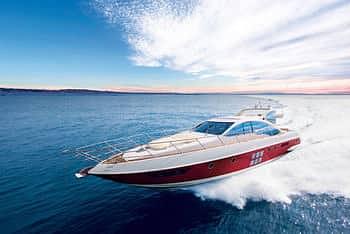
1st Nov 2023
Types of Marine Surveys: Pre-Purchase, Condition and Damage Survey
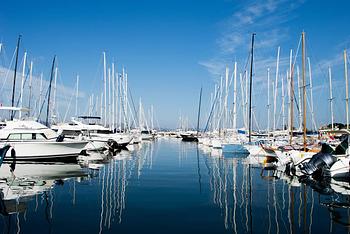
27th Oct 2023
The Top 15 Questions You Should Ask When Buying a New or Used Boat
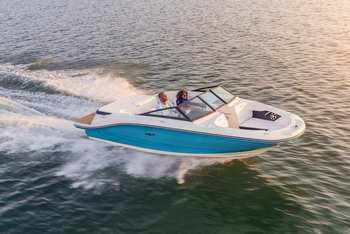
25th Sep 2023
Best Small Motor Boat Brands: Fishing Boats, Wakeboard Boats, Bowriders and more
- Explore Rightboat
- Boats for Sale
- Boating Articles
- Buyers Guide
- About RightBoat
- Sell Your Boat
- Boat Selling Advice
Enter your email to keep up to date with the latest news
Join for free
Sign up now for free and discover how easy it is to keep up to date with THE latest boats for sale. Find your right boat, and tailor your voyage to finding your next boat.
Benefits of becoming a member:
- Set up tailored alerts
- Personalise your experience
- Download full specifications and broker details
- Keep tabs on your favourite boats
Are you a broker? Join as a Broker
Rightboat - join for free.
Do you have an account already? Login
Save this search
Save your search and receive new boats in your email..
You can unsubscribe from your alerts whenever you like. By pressing the button you accept the Legal Terms and conditions

Service Locator
- Angler Endorsement
- Boat Towing Coverage
- Mechanical Breakdown
- Insurance Requirements in Mexico
- Agreed Hull Value
- Actual Cash Value
- Liability Only
- Insurance Payment Options
- Claims Information
- Towing Service Agreement
- Membership Plans
- Boat Show Tickets
- BoatUS Boats For Sale
- Membership Payment Options
- Consumer Affairs
- Boat Documentation Requirements
- Installation Instructions
- Shipping & Handling Information
- Contact Boat Lettering
- End User Agreement
- Frequently Asked Questions
- Vessel Documentation
- BoatUS Foundation
- Government Affairs
- Powercruisers
- Buying & Selling Advice
- Maintenance
- Tow Vehicles
- Make & Create
- Makeovers & Refitting
- Accessories
- Electronics
- Skills, Tips, Tools
- Spring Preparation
- Winterization
- Boaters’ Rights
- Environment & Clean Water
- Boat Safety
- Navigational Hazards
- Personal Safety
- Batteries & Onboard Power
- Motors, Engines, Propulsion
- Best Day on the Water
- Books & Movies
- Communication & Etiquette
- Contests & Sweepstakes
- Colleges & Tech Schools
- Food, Drink, Entertainment
- New To Boating
- Travel & Destinations
- Watersports
- Anchors & Anchoring
- Boat Handling
Inspecting Older Sailboats
Advertisement
Looking out for these problem areas can save you time and money.

— Published: July 2013
In this article we examine problems specific to older sailboats. Because many of these issues involve rot, corrosion, or manufacturers' defects and are therefore not covered by insurance, finding them early can avoid expensive headaches later.
Rig and Mast
The 28-foot sailboat was sailing along in a fresh breeze, when the skipper heard a faint "pung." The skipper glanced up — and then watched helplessly as the top of the mast started tilting awkwardly to leeward. A mere second or two later, it crashed over the side (Claim 98372712).
To a neophyte's eye, a sailboat's mast and rigging looks like a delicate web of cables and aluminum (or wood), hardly up to the task of propelling the boat to hull speed. A sailboat's rig, however, is carefully engineered to withstand all the various forces on it. A single failure can bring the whole thing tumbling down. In this case, the cause of the dismasting turned out to be a chainplate that had broken below deck level. The top was still clean and shiny but the rest of it, the part that had been hidden from sight, was a black, corroded mess.
Chainplates tie the rig into the structure of the hull. On most boats, they are made of stainless steel, which is susceptible to crevice corrosion when exposed to saltwater in the absence of oxygen. On an older sailboat, corrosion often begins where the chainplate passes through the deck or down below where it ties into the deck structure. Inspect chainplates for corrosion and cracks, above and belowdecks — you may have to remove a liner and some trim to get to it.
Moving to the rig, inspect turnbuckles for cracks and make sure there's at least 3/4-inch of thread visible inside. Make sure all turnbuckles are locked in place with cotter pins or, better yet, 316 stainless steel welding rod. Welding rod can be removed quickly and easily in the event of a dismasting and doesn't snag sheets or passing legs. Carefully check terminal fittings (use a magnifying glass), especially those near deck level, which are more likely to stay wet and corrode. Stays should be inspected for "fishhooks" by wrapping some tissue paper around the wire and carefully running it up as far as you can reach — shredded paper indicates a broken strand. Inspect rivets on the mast and boom. If you spot any that are loose or broken, all of them in the area will need to be replaced. Bubbles on a painted mast are an indication that corrosion is at work, as is white powder on bare aluminum, especially where stainless steel is in contact with it. After repairing the corroded area, the barrel of stainless steel fasteners should be coated with a lubricant/anticorrosive like Tef-Gel, and the head isolated from aluminum with plastic spacers available at marine stores.
Most people have a natural aversion to hanging from a rope at the top of a swaying mast, but unless the mast is off, there's no other way to inspect it. Only go up the mast if you have some experienced hands below to help, you're confident of the halyards and shackles that will haul you up, and you can rig a second safety halyard. You can hire a rigger to take a look, but learning how to go up yourself could serve you well in an emergency.
Run the tissue paper up each shroud to find fishhooks. Check the spreaders for damage where they meet the mast and at the ends, and make sure each spreader bisects its shroud. Inspect the tangs used to attach the stays to the mast, looking for cracks and corrosion. Make sure no cotter pins are missing or damaged. At the top (breathe, and don't look down), inspect the sheaves for cracks or excessive wear. Spin each sheave and make sure it moves freely (you'll need to switch your weight from one halyard to another).
Check the tangs for corrosion or cracks and look for missing or broken cotter pins or rings. On the way back down, check the rivets or screws used to secure the mast track. When you're back on deck — and less wobbly — inspect the mast step if the mast is deck-stepped. If it appears to be sunken, the deck support may be corroded or have shifted. Keel-stepped masts are prone to corrosion around their bases because water usually finds its way into the bilge. Look for pooling water or white powder and cracks at the base of the mast.
Look for cracks around where the goosenecks for the boom and vang attach to the mast and around the fitting where the vang attaches to the boom. These may need to be replaced or reinforced on older boats.
If the boat has a bowsprit, don't forget that the bobstay is part of the rigging. Inspect it and its attachment points for any signs of damage or stress. A bobstay that has been rammed into docks repeatedly will fail sooner or later, and if a headsail is flying at the time, the whole mast could come down.
Fiberglass Issues
Nearly all sailboats built in the 1980s or later have a deck comprised of a core made from balsa or some sort of composite material sandwiched between two fiberglass skins with a layer of gelcoat on the outside to make the hull shiny and fair. Problems frequently arise with the core and with the gelcoat.

Water that leaks into the core can eventually cause rot.
The deck doesn't take its strength from the fiberglass, but from the stiff inner core. Over time, water can leak into the core through deck fittings, such as cleats, chainplates, and stanchions, which causes rot that can eventually turn the core into mush. A mushy core compromises the deck's structural integrity, and if large sections of the core are rotted, it can be all but impossible — and very expensive — to fix. Professionals use the handle of a screwdriver or small plastic hammer to tap on the deck, listening for signs of softness, something you can do as well. Pay careful attention to the area around fittings that penetrate the deck; a dull thud often signals a soft spot while a solid "thunk" usually means a healthy core.
A spongy feel as you walk the deck may be a sign of larger rotten areas. If you suspect a problem, contact a professional. Extensive core repairs are generally above the skill level of do-it-yourselfers.
Chainplates are all but impossible to make watertight, so pay special attention there. Not only can a leaking chainplate destroy deck coring, it can rot the structural bulkheads to which they attach below. A rotten bulkhead can give way, releasing the chainplate and bringing the whole rig down. In the case of the 26-foot sailboat above, a leak caused the chainplate to corrode, which made it fail under load. After you finish your deck inspection, go below and look for stains or other evidence of leaks through the deck, keeping an eye out for water-damaged bulkheads.
BoatUS receives the most complaints about gelcoat problems including crazing, cracking, and blisters. Gelcoat is a thin coating over fiberglass and easily cracks. Gelcoat crazing is common on some makes of sailboats like Islander and Ericson from the 1970s when gelcoat was applied in a much thicker layer than today. It looks like spiderwebs embedded in the gelcoat that don't penetrate the surface. Though unsightly, these are not structural, and it is not worth the cost of repair.
The thinner gelcoat on newer boats is less likely to craze but more likely to crack. Though rarely structurally serious, cracking can indicate excessive flexing and often occurs on unsupported decks or cabin roofs, around stanchion bases or cleats, or where the boat structure makes a sharp angle — at cockpit corners, for example. Gelcoat cracks around deck winches, cleats, genoa tracks, or a windlass mean the area should be further inspected. The fitting may need a backing plate to spread the load, or the area may need to be structurally reinforced.
Fiberglass hulls blister when water passes through the gelcoat layer and combines with materials in the resin to create an acidic mixture that expands, pushing the gelcoat into a dome. Though unsightly, blisters on older boats are rarely a structural issue and can be dealt with relatively easily. A new boat with a "pox" of blisters, however, should be avoided as this could indicate problems with the quality of the fiberglass layup.
Hull Fittings
BoatUS has received complaints about underwater fittings on some sailboats. Brass fittings contain zinc, which can leach out of the fitting over time, causing it to become brittle and porous and eventually break. Head discharge fittings tend to be particularly susceptible. Look for fittings that have a pinkish color or patches of white fuzz. Plastic fittings are also not suitable for underwater use and while few manufacturers would install them, a previous owner may have. Bronze and Marelon (a type of glass-reinforced composite) are the most durable materials for underwater fittings.
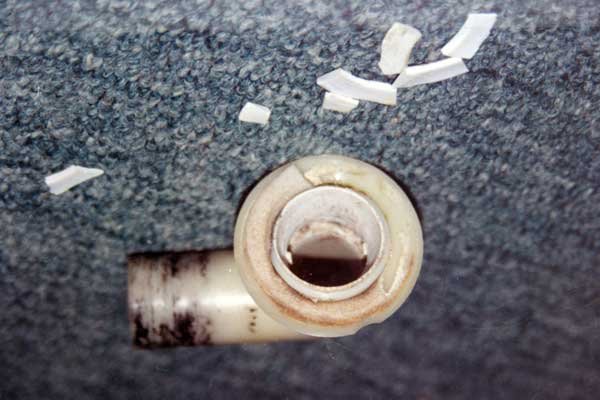
A plastic fitting will eventually turn brittle and crack in the sun; if the boat is overloaded, it could sink.
Also check fittings that are above the waterline when at rest, but which may be underwater when the boat heels. These fittings are sometimes plastic and will degrade in the sun. A cracked fitting close to the waterline can leak when the boat takes on extra weight (snow, gear, extra passengers, and so on) and can sink the boat.
Keels and Centerboards
Keels tend to take a lot of abuse in shallow waters. Damage on the leading edge and the bottom indicates some pretty hard groundings. Often the interface between the hull and keel has some filler in it that is easily cracked, but unless the crack is substantial, it's usually not a problem.
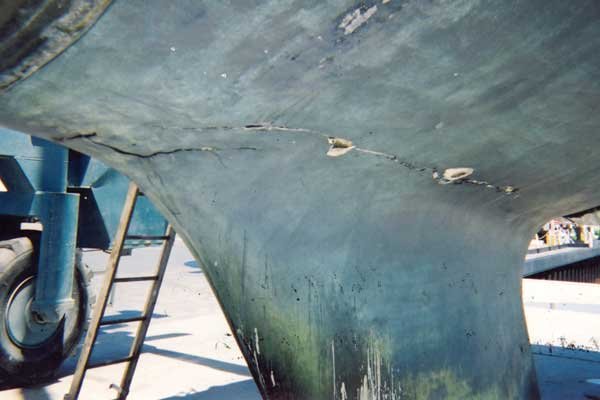
A large crack, like this, means a hard grounding, which may have caused structural damage.
Centerboards are subjected to heavy loads, and the cable, pins, sheaves, and fittings that support them spend much of their time underwater. The serviceable life of the wire and fittings is affected by many factors: whether the boat is being used in salt- or freshwater; the number and severity of groundings; the compatibility of the metals used; and the weight/configuration of the keel/centerboard.
A cable that fails suddenly can be much more than an inconvenience; the centerboard can bash a hole in the hull and sink the boat. Swing keels and centerboards should be lowered completely (usually this is only possible while a boat is in the slings and positioned over a pit) so that the wire can be inspected for broken strands. Centerboard trunks should be opened and inspected when the boat is out of the water. Fittings at either end of the wire should be replaced if you see rust, cracks, or distortion.
If you're buying a boat, doing your own inspection can save you the cost of a survey by ruling out boats with common faults. But a self-inspection, no matter how thorough is no substitute for a marine survey, so hire a professional after you've done your own checkout.
Related Articles
The truth about ceramic coatings for boats.
Our editor investigates the marketing claims of consumer-grade ceramic coatings.
Fine-Tune Your Side Scan Fishfinder
Take your side-scanning fishfinder off auto mode, and you’ll be spotting your prey from afar in no time
DIY Boat Foam Decking
Closed-cell foam flooring helps make boating more comfortable. Here’s how to install it on your vessel
Click to explore related articles
Charles Fort
Contributing Editor, BoatUS Magazine
Charles Fort is BoatUS Magazine's West Coast Editor. He often writes local news items for BoatUS Magazine's Waypoints column and contributes to Reports, in-depth tech features in every issue written to help readers avoid accidental damage to their boats. He is a member of the National Association of Marine Surveyors, he's on ABYC tech committees, and has a 100-ton U.S. Coast Guard license. He lives in California.
BoatUS Magazine Is A Benefit Of BoatUS Membership
Membership Benefits Include:
Subscription to the print version of BoatUS Magazine
4% back on purchases from West Marine stores or online at WestMarine.com
Discounts on fuel, transient slips, repairs and more at over 1,200 businesses
Deals on cruises, charters, car rentals, hotel stays and more…
All for only $25/year!
We use cookies to enhance your visit to our website and to improve your experience. By continuing to use our website, you’re agreeing to our cookie policy.

Ultimate Guide: How to Buy a Used Sail Boat – Expert Tips & Advice
Alex Morgan

Buying a used sailboat can be an exciting and fulfilling endeavor for sailing enthusiasts. Whether you’re a seasoned sailor or a novice, purchasing a pre-owned sailboat offers unique advantages. It’s crucial to approach the process with careful research, planning, and inspection to ensure you make a wise investment. This comprehensive guide will walk you through the steps involved in buying a used sailboat, helping you navigate the process smoothly.
When it comes to buying a used sailboat, there are several essential factors to consider. In this section, we’ll discuss the research and planning phase, inspecting the sailboat to assess its condition, surveying and documentation, as well as negotiating and closing the deal. We’ll cover the necessary steps to prepare for ownership.
Before diving into the used sailboat market, it’s crucial to determine your sailing needs and preferences. Consider the type of sailing you plan to do and the specific features you require in a sailboat. Setting a budget is another essential step, as it helps you narrow down your options and avoid overspending. Researching sailboat types and models will further enhance your understanding of what’s available in the market. Finding reputable listings and sellers is essential to ensure a smooth and reliable buying experience.
Once you’ve identified a sailboat of interest, it’s crucial to conduct a thorough inspection. Visual inspection is essential to assess the overall condition of the boat. Checking the hull and deck for any signs of damage or wear is vital to ensure its structural integrity. The rigging and sails should also be examined to evaluate their condition. inspecting the engine and mechanical systems, as well as the electrical and plumbing systems, will help identify any potential issues.
To obtain a comprehensive evaluation of the sailboat’s condition, hiring a professional marine surveyor is highly recommended. The survey report will provide valuable insights into any existing or potential problems. Verifying the boat’s documentation and history is crucial to ensure that everything is in order. Checking for outstanding debts or liens will help avoid any legal complications in the future.
Negotiating the price is a standard part of the sailboat buying process. Consider any additional expenses, such as repairs, upgrades, or storage, when determining your final offer. It is important to draft a written agreement to ensure that all parties understand their responsibilities. Once the terms are agreed upon, completing the necessary paperwork will finalize the transaction.
Once the deal is closed, there are several steps to take in preparation for ownership. Arranging for boat transportation or delivery to your desired location is essential. It is also crucial to secure insurance coverage to protect your investment. Registering and documenting the boat in your name is necessary to establish legal ownership. obtaining any necessary permits and licenses will ensure you comply with local regulations and can enjoy your new sailboat without any issues.
By following these steps and carefully considering each aspect of the buying process, you can confidently purchase a used sailboat that suits your needs, allowing you to embark on incredible sailing adventures.
Key takeaway:
- Researching and Planning are crucial: Determine your sailing needs and preferences, set your budget, research sailboat types, and find reputable listings and sellers to make an informed decision.
- Inspecting the Sailboat is essential: Perform a visual inspection, check the hull and deck, examine the rigging and sails, inspect the engine and mechanical systems, and assess the electrical and plumbing systems to ensure the sailboat’s condition.
- Surveying and Documentation are important steps: Hire a professional marine surveyor, review the survey report, verify the boat’s documentation and history, and check for outstanding debts or liens to avoid any legal or financial complications.
- Negotiating and Closing the Deal requires attention: Negotiate the price, consider additional expenses, draft a written agreement, and complete the necessary paperwork to finalize the purchase smoothly.
- Preparing for Ownership is necessary: Arrange for boat transportation or delivery, secure insurance coverage, register and document the boat in your name, and obtain necessary permits and licenses to be ready for sailboat ownership.
Researching and Planning
When it comes to buying a used sailboat, the key lies in thorough researching and planning . In this section, we’ll uncover the secrets of successful boat hunting . From determining your specific sailing needs and preferences, setting a budget, to researching different sailboat types and finding reputable listings and sellers, we’ll equip you with all the necessary tools to make a well-informed purchase. Get ready to set sail on the waters of knowledge !
Determine your sailing needs and preferences
- Assess whether you are a beginner , intermediate , or experienced sailor. This will help you choose a sailboat that matches your skill level.
- Decide on the purpose of the sailboat: Determine if you will use the sailboat for leisurely cruising , racing , day sailing , or long-distance voyages . This will influence factors such as the size and design of the sailboat.
- Evaluate the number of passengers: Determine how many people you regularly plan to have on board. This will help you select a sailboat with the appropriate number of berths and seating capacity.
- Assess your storage needs: Consider the amount of storage space you need for equipment, supplies, and personal belongings. This will guide you towards sailboats with ample storage compartments.
- Contemplate your preferred sailing conditions: Decide whether you will primarily sail in coastal areas, lakes , or open ocean . This will impact the sailboat’s stability, hull design, and other features necessary for specific sailing conditions.
- Think about maintenance and upkeep: Consider the time and effort you are willing to dedicate to maintenance tasks. Some sailboats require more regular upkeep than others, depending on the materials and systems on board.
Set your budget
To set your budget when buying a used sailboat, follow these steps:
1. Assess your finances and determine your sailboat spending limit.
2. Consider additional costs like mooring fees, maintenance, insurance, and repairs.
3. Research average prices of used sailboats in your desired size and condition range.
4. Take into account any financing or loans you may need.
5. Consult experienced sailors, boat dealers, or online forums to understand sailboat expenses.
6. Based on your research and finances, set a specific budget range for your purchase.
By following these steps and setting a clear budget, you will understand the financial aspects of buying a used sailboat. This will help you make an informed decision and ensure that you can afford the initial purchase and ongoing costs of owning and maintaining your sailboat.
Research sailboat types
When researching sailboat types, it is important to consider specific needs and preferences. Keep in mind the following factors:
- Sailing purpose: Determine whether the sailboat is intended for racing, cruising, or day sailing.
- Sailboat size: Consider the size of the sailboat based on the number of people and sailing activities.
- Sailboat design: Explore different designs such as sloop, ketch, catamaran, or trimaran to match your preferences and goals.
- Sail type: Discover sail options such as mainsails, genoas, jibs, and spinnakers to suit your sailing style.
- Construction material: Assess the durability, maintenance, and performance of sailboats made of fiberglass, aluminum, steel, or wood.
- Keel type: Research various designs such as fin keel, full keel, or wing keel to understand stability, maneuverability, and draft depth.
Thorough research is essential in order to make an informed decision that aligns with your sailing preferences and needs.
Remember to consider factors such as sailing purpose, sailboat size, design, sail type, construction material, and keel type. By doing so, you will ensure that you choose a sailboat that meets your requirements and enhances your sailing experience.
Find reputable listings and sellers
When looking for reputable listings and sellers for buying a used sailboat, consider the following:
1. Online marketplaces: Websites like Boat Trader , YachtWorld , and Sailboat Listings provide sailboat listings from sellers and brokers.
2. Boat shows: Attend boat shows in your area to see multiple sailboats for sale and meet reputable sellers.
3. Yacht clubs and marinas: Check bulletin boards and inquire at local yacht clubs and marinas for listings from boat owners looking to sell.
4. Boat brokers: Work with reputable boat brokers specializing in used sailboats. They have access to a network of boat owners and can help you find the right sailboat.
5. Boatyards and storage facilities: Some sailboats for sale may be stored at boatyards or storage facilities. Inquire with these places for available listings.
Do your due diligence when researching listings and sellers. Read reviews, ask for references, and communicate with sellers to gather more information about the condition and history of the sailboat.
In 2019, Chris was in the market for a used sailboat. He wanted a reputable seller who could provide him with a well-maintained sailboat at a fair price. After extensive research and visits to local boat shows, Chris came across a listing on a reputable online marketplace. The listing was from a boat broker known for their expertise in sailboats. Chris contacted the broker and scheduled a meeting to view the sailboat. Impressed by the condition and the seller’s knowledge, Chris decided to proceed with the purchase. The broker facilitated the negotiation process and ensured all necessary paperwork was completed smoothly. Thanks to finding a reputable listing and seller, Chris is now the proud owner of a used sailboat that perfectly suits his sailing needs.
Inspecting the Sailboat
When it comes to buying a used sailboat, a thorough inspection is absolutely crucial . In this section, we’ll dive into the process of inspecting the sailboat, ensuring that you have all the necessary information to make an informed decision. From a visual examination to checking the hull, deck, rigging, sails, engine, and even the electrical and plumbing systems, we’ll leave no stone unturned in ensuring that your sailboat purchase meets all your expectations. So let’s get started and uncover the secrets of a comprehensive sailboat inspection!
Visual inspection
Visual inspection is crucial when buying a used sailboat. It allows you to assess the overall condition and identify any visible issues. Here are important aspects to consider:
1. Hull and deck: Visually examine the hull for cracks, blisters, or signs of damage. Check the deck for soft spots or signs of water intrusion.
2. Rigging and sails: Inspect the rigging for signs of wear, such as frayed wires or rusted fittings. Evaluate the condition of the sails, looking for tears, stains, or other indications of damage.
3. Engine and mechanical systems: Check the engine compartment for leaks, corrosion, or signs of poor maintenance. Assess the condition of the engine, including fluid levels and belts.
4. Electrical and plumbing systems: Inspect the electrical wiring, ensuring there are no loose connections or exposed wires. Check the plumbing system for leaks or signs of water damage.
5. Interior and exterior surfaces: Examine the interior spaces for water damage, mold, or mildew. Assess the cleanliness and condition of the boat’s surfaces, including the cabin, cockpit, and storage areas.
6. Additional features: Take note of any navigation systems, safety equipment, or on-board amenities. Ensure that these features are in good working order.
By conducting a thorough visual inspection, you can gather valuable information about the sailboat’s condition and make an informed decision during the buying process.
Check the hull and deck
Inspect the hull and deck for visible signs of damage or wear, such as cracks, dents, or soft spots in the fiberglass or other structural materials. Check the hull for delamination , which is the separation of layers within the fiberglass. Use a small hammer to tap along the hull and listen for hollow or dull sounds, indicating delamination. Look for signs of water intrusion, such as water stains or discoloration on the deck or hull, which could indicate potential leaks or structural issues.
Examine the keel and rudder for damage or corrosion , ensuring they are securely attached to the hull. Inspect the deck fittings, including cleats, winches, and stanchions, to ensure they are in good working condition and properly attached. Check the condition of the non-skid surfaces on the deck to ensure sufficient traction . Inspect the lifelines and rigging attachments to ensure they are secure and in good condition.
Look for signs of osmosis , such as blistering or bubbling of the hull caused by water absorption , which can indicate potential structural issues. If possible, use a moisture meter to measure the moisture content of the hull and deck, as excessive moisture levels could indicate water damage.
In 1986, a diver discovered the original bow sprit of a 19th-century racing schooner during a routine hull inspection of a used sailboat. The bow sprit had been hidden beneath layers of marine growth and paint, unbeknownst to the sailboat’s previous owner. Maritime historians authenticated the artifact and recognized its historical significance. Eventually, the bow sprit was donated to a maritime museum and is now on display. This discovery serves as a reminder that when checking the hull and deck of a used sailboat, there may be hidden treasures or fascinating stories waiting to be discovered.
Examine the rigging and sails
When examining the rigging and sails of a used sailboat, follow these steps:
- Inspect the rigging for signs of wear or damage. Look for frayed or corroded wires, loose connections, and rust on metal fittings.
- Check the sails for tears, holes, or significant wear. Look for areas of discoloration or weak spots in the fabric.
- Examine the stitching on the sails. Ensure it is intact and strong, without loose threads or unraveling seams.
- Check the condition of the sail tracks and mast fittings. Look for cracks, deformations, or signs of excessive wear.
- Inspect the sail control systems, including the halyards, sheets, and furling mechanisms. Make sure they function properly and are not excessively worn or damaged.
When examining the rigging and sails, assess the overall condition and functionality. Consider necessary repairs or replacements to ensure safe and efficient sailing.
Suggestions:
- If significant issues are noticed with the rigging or sails, factor in the cost of repairs or replacements when negotiating the price of the sailboat.
- Consider consulting a professional sailmaker or rigger to evaluate the condition of the rigging and provide expert advice.
- Regular maintenance and inspections of the rigging and sails are important to prolong their lifespan and ensure safe sailing.
Inspect the engine and mechanical systems
Inspecting the engine and mechanical systems is crucial when considering the purchase of a used sailboat. It is important to follow these steps in order to make an informed decision:
1. Begin by visually examining the engine compartment to detect any leaks, rust, or damages.
2. Check the oil level and condition , ensuring that it is clean and suitable.
3. Thoroughly inspect the engine belts, hoses, and connections to identify signs of wear and tear.
4. Start the engine and pay close attention to any unusual noises or vibrations.
5. Carefully examine the exhaust system to ensure that there are no leaks.
6. Check the fuel system for any traces of corrosion or damages.
7. Verify that the cooling system is functioning properly.
8. Test the throttle and gears to ensure that they operate smoothly.
9. Inspect the electrical system for any signs of damage or corrosion.
10. It is also important to test other mechanical systems , such as the steering and navigation instruments.
By conducting a comprehensive inspection of the engine and mechanical systems, you will be able to make an informed decision before finalizing your purchase of the sailboat.
Assess the electrical and plumbing systems
Assess the electrical and plumbing systems of a used sailboat to ensure functionality and safety.
1. Check the electrical system: Inspect wiring for damage or wear. Test lights, navigation equipment, and battery chargers to ensure proper functioning . Look for loose connections or corrosion that could affect performance.
2. Evaluate the plumbing system: Examine water tanks, pipes, and faucets for leaks or damage. Test water pressure and ensure the water pump is working correctly. Check the toilet and sewage system for blockages or malfunctions.
3. Verify battery condition: Assess the age and performance of the boat’s batteries. Check for corrosion on the terminals and ensure secure connections. Consider battery capacity, type, and availability of charging options on the water.
4. Assess safety features: Check for proper grounding and protection against electrical shock. Look for circuit breakers or fuses to prevent overload. Examine the bilge pump system to ensure it is in good condition .
5. Seek professional assistance if unsure: Hire a professional marine electrician or plumber for a thorough inspection if you are unsure about the condition of the systems. They have the expertise to identify potential issues or deficiencies.
Remember, the integrity of the electrical and plumbing systems is crucial for the sailboat’s overall functionality and safety. Assessing these systems before purchasing a used boat will help avoid costly repairs or safety hazards in the future.
Surveying and Documentation
Surveying and Documentation is a critical aspect when it comes to purchasing a used sail boat . You want to ensure that your dream boat is in good condition and has a clean history. In this section, we’ll explore the necessary steps to make an informed decision. From hiring a professional marine surveyor to reviewing the survey report, verifying the boat’s documentation and history, and checking for outstanding debts or liens, we’ll equip you with the knowledge to navigate the process smoothly.
Hire a professional marine surveyor
When purchasing a used sailboat, it is vital to hire a professional marine surveyor . By hiring a professional marine surveyor, you can have peace of mind knowing that an experienced and knowledgeable individual has thoroughly inspected the boat. They will assess the boat’s condition and provide valuable insights. A marine surveyor possesses expertise in inspecting sailboats to ensure they meet safety standards and identify any potential issues. They will examine the hull, deck, rigging, sails, engine, mechanical systems, electrical systems, and plumbing systems.
The professional marine surveyor will provide a detailed survey report, highlighting any areas requiring attention or repairs. This report can help you negotiate the price and determine if the sailboat is worth investing in. Carefully reviewing the survey report and considering it when making your decision is crucial. It is essential to verify the boat’s documentation and history to ensure there are no outstanding debts or liens. Hiring a reputable professional marine surveyor allows you to make an informed decision and minimize the risk of purchasing a sailboat with hidden problems.
To ensure a smooth buying process, it is advisable to hire a reputable professional marine surveyor . Their expertise and thorough assessment will help you make an informed decision when buying a used sailboat.
Review the survey report
When buying a used sailboat, thoroughly review the survey report before making a decision. The survey report provides detailed information about the sailboat’s condition, identifying existing issues or potential problems. By reviewing the survey report , you can make an informed decision about the sailboat’s suitability.
During the review process, pay close attention to any structural or mechanical issues mentioned. Look for signs of damage or wear and consider the cost and effort required for repairs or maintenance. Check if all necessary systems on the sailboat are functioning properly , including the electrical and plumbing systems .
If major concerns are identified in the survey report, evaluate their impact on the sailboat’s performance , safety , and value . Consider if these issues can be addressed and if the cost of repairs or modifications fits your budget .
Ultimately, the survey report is a crucial document that provides valuable insights into the condition of the used sailboat. Thoroughly reviewing it helps you make an informed decision about the purchase or negotiate further with the seller.
Verify the boat’s documentation and history
Verify the boat’s documentation and history to ensure a smooth ownership experience.
– Request the boat’s ownership documents, including the title or registration certificate , to confirm legal ownership.
– Check the boat’s hull identification number (HIN) and compare it against the ownership documents to ensure they match.
– Research the boat’s history by obtaining a detailed record of previous owners, maintenance records, and any major repairs or incidents .
– Verify if there are any outstanding debts or liens on the boat by conducting a lien search with the appropriate authorities.
– Examine the boat’s warranty information , if applicable, to determine if any coverage is transferable to the new owner.
– Review any additional documentation such as insurance policies, survey reports, or previous inspection certificates .
– Consider hiring a professional marine surveyor to provide an independent assessment of the boat’s condition and validate its documentation.
Thoroughly verify the boat’s documentation and history to ensure a clear ownership record and reliable background when purchasing a used sailboat.
Check for outstanding debts or liens
When purchasing a pre-owned sailboat, it is essential to thoroughly investigate and confirming there are no outstanding debts or liens on the vessel. To achieve this, follow the steps below:
- Connect with the appropriate government authority to gather information regarding any outstanding debts or liens.
- Obtain duplicates of the boat’s title and registration documents to authenticate ownership and scrutinize for any liens.
- Seek advice from a marine surveyor or maritime attorney to perform a comprehensive search for undisclosed debts or liens.
- Carefully review the survey report and the seller’s documentation to confirm the absence of any outstanding debts or liens.
- In the event that there are indications of debts or liens, engage in negotiations with the seller to resolve these matters prior to finalizing the purchase.
- Consider enlisting the assistance of a legal professional to handle the required paperwork and safeguard your interests effectively.
It is of utmost importance to conduct a thorough investigation for any outstanding debts or liens before purchasing a used sailboat to avoid encountering legal and financial complications. By following these steps diligently, you can ensure a seamless and secure transfer of ownership.
Negotiating and Closing the Deal
When it comes to buying a used sailboat, the negotiating and closing the deal is a crucial stage. In this section, we’ll dive into the art of negotiation, uncovering ways to potentially lower the price. We’ll also explore additional expenses to consider and how to draft a solid written agreement. Plus , we’ll guide you through the necessary paperwork, ensuring a smooth and successful transaction. So, tighten your sails and get ready to navigate the world of sailboat negotiations!
Negotiate the price
When negotiating the price for a used sailboat, follow these steps:
– Do market research: Research similar sailboats on the market to understand their average price range.
– Assess the condition: Evaluate the sailboat’s overall condition, including the hull, rigging, sails, engine, and other systems. Note any necessary repairs or upgrades.
– Consider the age: Take into account the sailboat’s age compared to others on the market. Newer sailboats may have a higher price, while older ones may require more maintenance.
– Factor in location: Location can influence the price. Consider the cost of transporting the boat and any additional expenses associated with the area.
– Make a reasonable offer: Based on your research, make a fair offer within your budget. Consider the repairs or upgrades you may need to make.
– Be prepared to negotiate: Be open to negotiation with the seller. You may need to go back and forth to reach a mutually satisfactory price.
– Consider additional expenses: Remember to factor in insurance, storage, docking fees, and necessary permits or licenses.
– Get it in writing: Once a price has been agreed upon, draft a written agreement that outlines the terms of the sale, including price, included items, and any conditions.
– Complete the necessary paperwork: Ensure all necessary paperwork, such as ownership transfer forms, is completed correctly and submitted.
By following these steps, you can negotiate a fair price for a used sailboat that fits your budget and needs.
Consider additional expenses
When purchasing a pre-owned sailboat, it is important to take into account the potential additional costs. These expenses may vary depending on the sailboat’s condition and your personal requirements. Here are a few factors to keep in mind:
1. Repairs and upgrades: Allocate a budget for addressing any structural issues, replacing outdated equipment, or improving the boat’s performance.
2. Maintenance and storage: Regularly clean, paint, and service the engine to ensure its proper functioning. Include the cost of storage such as mooring fees or a marina berth in your budget.
3. Insurance: It is essential to have insurance coverage to protect against potential damages or unforeseen events. Take into consideration the cost of insurance premiums.
4. Registration and licensing: Research the necessary requirements and associated fees for registering and licensing the sailboat.
5. Transportation: If the sailboat is located far from your desired sailing area, factor in the expenses of transporting it to its new location.
6. Additional equipment and accessories: Consider investing in safety gear, navigation systems, or new sails to enhance your sailing experience.
By taking into account these potential expenses, you can effectively plan your budget and ensure a smoother purchasing process for your pre-owned sailboat.
Draft a written agreement
To buy a used sailboat, it is essential to draft a written agreement. This ensures a clear understanding of the terms and conditions between the buyer and seller. Follow these steps when drafting the agreement:
- Identify the parties: Clearly state the names and contact information of the buyer and seller .
- Describe the sailboat: Include details such as make, model, year, and any unique features .
- Specify the purchase price: Clearly state the agreed-upon price .
- Outline payment terms: Specify how and when the payment will be made, including deposit amount , payment schedule , and applicable payment methods.
- Include contingencies: If conditions or contingencies need to be met before finalizing the sale (e.g., satisfactory survey or sea trial ), include them in the agreement.
- Address warranties or representations: Specify any warranties or representations made regarding the sailboat’s condition or history.
- Include a dispute resolution clause: Specify how disputes will be resolved (e.g., mediation or arbitration ).
- Sign and date the agreement: Both the buyer and seller should sign and date the agreement to indicate acceptance and agreement to the terms.
When I bought a used sailboat, I drafted a written agreement with the seller. It included all necessary details like the sailboat’s description, purchase price, and payment terms. We also included a contingency for a full inspection and sea trial to ensure the sailboat’s condition matched the representation. The agreement protected both parties and provided peace of mind during the transaction.
Complete the necessary paperwork
Complete the necessary paperwork when buying a used sailboat. Here is a list of steps to follow:
1. Obtain a bill of sale form or create one.
2. Fill in the details of the sale, including the buyer’s and seller’s names, contact information, and the agreed-upon price.
3. Include information about the sailboat, such as the make , model , year , and hull identification number (HIN) .
4. Indicate any additional equipment or accessories included in the sale.
5. Both the buyer and seller should sign and date the bill of sale.
6. Depending on local regulations, you may need to have the bill of sale notarized or witnessed .
7. Check with the appropriate authorities to determine if any additional paperwork is required, such as a registration or documentation application .
8. Fill out the necessary registration or documentation forms , providing all requested information about the sailboat and yourself as the new owner.
9. Attach a copy of the bill of sale to the registration or documentation forms.
10. Submit the completed paperwork and any required fees to the relevant agency or department.
By following these steps and completing the necessary paperwork, you can ensure a smooth and legal transition of ownership when buying a used sailboat.
Preparing for Ownership
When it comes to buying a used sailboat, there’s more to it than just the transaction. In the section on preparing for ownership, we’ll delve into the essential steps you need to take before setting sail. From arranging transportation or delivery to securing insurance coverage, registering the boat in your name, and obtaining the necessary permits and licenses, we’ve got you covered . Get ready to embark on your sailing adventure with confidence and peace of mind .
Arrange for boat transportation or delivery
Arranging for boat transportation or delivery is an essential step when purchasing a used sailboat. Here are the recommended steps to ensure a smooth process:
1. Begin by researching various boat transport companies and compare their prices, reputation, and customer reviews. This will help you find the most reliable option.
2. Once you have selected a boat transport company , reach out to them and request a quote. Make sure to provide them with the pickup and delivery locations, boat dimensions, and any special requirements you may have.
3. Take the time to carefully review the quote and ensure that it fits within your budget. Consider the insurance coverage provided by the transport company.
4. If you decide to transport the boat yourself , ensure that you have obtained all the necessary permits and licenses for towing if they are required.
5. Coordinate with the seller or broker to determine the most convenient pickup time and location. Before the transportation, ensure that you have prepared the boat by removing any loose items and securing hatches.
6. Once everything is in order, finalize the pickup date and time with the boat transport company. Make arrangements for access to the boat location.
7. On the day of the pickup, thoroughly inspect the boat for any pre-existing damages. Take photos or videos to document them and avoid any disputes later on.
8. Throughout the transportation process, stay in contact with the transport company to receive updates on the progress and estimated delivery time.
9. Upon delivery, carefully inspect the boat again to ensure that no damages occurred during transportation. In case any issues arise, immediately communicate with the transport company and document the damages.
When arranging for boat transportation or delivery , it is important to select a reliable company and remain involved throughout the entire process. By planning ahead and maintaining good communication, you can ensure that the boat arrives safely and in good condition.
tags intact, if found.
Secure insurance coverage
Secure insurance coverage is crucial when buying a used sailboat. It provides financial protection in case of accidents, damages, or liability issues. Follow these steps to secure insurance coverage:
- Research insurance providers: Look for reputable companies specializing in sailboat coverage. Compare policies and prices to find the best option.
- Assess sailboat value: Determine the sailboat’s value considering factors like age, condition, and market value.
- Choose the right coverage: Select insurance that suits your requirements, including hull and equipment coverage, liability coverage, and personal property coverage.
- Gather necessary documentation: Provide required documentation such as registration, survey report, and maintenance records to determine the sailboat’s condition and value.
- Request a quote: Contact the insurance company for an accurate quote by providing accurate information.
- Review policy details: Carefully read the policy’s terms and conditions, including coverage limits, deductibles, and exclusions, to understand what is covered and what is not.
- Purchase the insurance: Complete necessary paperwork and payment to secure the insurance coverage once satisfied with the coverage and policy details.
By following these steps, you can secure insurance coverage for your used sailboat and have peace of mind while enjoying your sailing adventures.
Register and document the boat in your name
To successfully register and document the boat in your name, it is important to follow these steps:
- Contact the local maritime authority or department responsible for boat registration.
- Fill out the necessary registration forms with accurate information, ensuring that you include all the details required to register and document the boat in your name.
- Provide documentation that proves your ownership of the boat, such as the bill of sale or transfer of ownership documentation. This is crucial for the registration process.
- Submit the completed forms along with the supporting documents to the maritime authority, ensuring that you provide everything necessary to demonstrate your ownership.
- It is also important to pay any applicable registration fees or taxes required for boat ownership. This is a crucial step in the process.
- Once you have completed the above steps, it is important to wait for the registration process to be completed. This may involve verification and approval from the maritime authority.
- Once your registration is approved , you will receive the official registration certificate or documentation indicating that the boat is now registered in your name. It is important to keep this documentation onboard the boat at all times.
- It is crucial to keep the registration documentation accessible on the boat as it may be required for verification purposes by authorities or during inspections.
By meticulously following these steps, you will be able to successfully register and document the boat in your name. This will establish your legal ownership and enable you to enjoy your new sailboat with peace of mind.
Obtain necessary permits and licenses
To acquire the necessary permits and licenses for a used sailboat, you can follow these steps:
- Conduct thorough research: Take the time to familiarize yourself with the specific regulations governing the ownership and operation of a sailboat in your local area.
- Reach out to the appropriate authorities: Contact government agencies or maritime authorities relevant to your location to inquire about the permits and licenses required for your sailboat.
- Gather the required documentation: Be sure to prepare all the necessary documents, such as proof of ownership, boat registration, and identification, as these will be needed during the permitting process.
- Submit your application for permits: Once you have gathered all the required paperwork, submit your application to the authorities and pay any applicable fees.
- Fulfill mandatory training or inspections: In order to comply with local regulations, you may need to undergo safety training or have your sailboat inspected. Ensure you complete these requirements.
- Stay in touch and fulfill additional requests: Keep track of the progress of your application and promptly respond to any additional requirements or requests from the authorities.
- Acquire the permits and licenses: Once your application is approved, obtain the necessary documents and ensure they are kept accessible on your sailboat.
- Remember to renew your permits and licenses: Stay informed about expiration dates and make sure to renew your permits and licenses as required to continue operating your sailboat in compliance with regulations.
By following these steps, you will be able to obtain all the necessary permits and licenses for your used sailboat, allowing you to fully enjoy your sailing adventures in a legal manner.

Some Facts About How To Buy A Used Sail Boat:
- ✅ Shopping for a used sailboat can be daunting, as there are many options with varying conditions and price tags.
- ✅ It is important to be objective and curb your enthusiasm when making a decision.
- ✅ Consider the ongoing costs of owning a sailboat, such as insurance, fuel, fees, and maintenance.
- ✅ The condition of the fiberglass hull and interior is not a major concern, as it can be easily reconditioned.
- ✅ Soft or sagging deck areas indicate water damage and should be avoided.
Frequently Asked Questions
Faq 1: what factors should i consider when buying a used sailboat.
When buying a used sailboat, it’s important to consider various factors to make a well-informed decision. Some key factors include the condition of the fiberglass hull and interior, signs of water damage such as soft or sagging deck areas, leaks inside the boat that can lead to mold and mildew, the condition of the bottom paint indicating underlying damage, the performance of the keel, the state of cabin cushions, the thorough inspection of the outboard motor, and the condition of the sails and standing rigging.
FAQ 2: Should I be concerned about the fiberglass hull and interior condition of a used sailboat?
No, the condition of the fiberglass hull and interior is not a major concern when buying a used sailboat. These areas can be easily reconditioned to restore their appearance and functionality.
FAQ 3: What should I look for in terms of water damage when inspecting a used sailboat?
When inspecting a used sailboat, it’s crucial to avoid soft or sagging deck areas as they indicate water damage. Water damage can lead to expensive repairs, mold, mildew, and corrosion, so it’s important to carefully check for signs of leaks inside the boat.
FAQ 4: How important is the condition of the bottom paint when buying a used sailboat?
The condition of the bottom paint is important when buying a used sailboat as it can indicate underlying damage. Poorly maintained or damaged bottom paint can result in hull damage, affecting the overall performance and longevity of the sailboat.
FAQ 5: What should I consider regarding the keel in a used sailboat?
The keel plays a critical role in the performance of a sailboat. When buying a used sailboat, pay attention to the condition and integrity of the keel. Any damage or corrosion should be thoroughly inspected and evaluated before making a purchase.
FAQ 6: What should I inspect when it comes to the sails and standing rigging of a used sailboat?
When evaluating the sails and standing rigging on a used sailboat, look for any signs of damage, wear, or corrosion. Sails are rarely new on used sailboats, so it’s important to carefully assess their condition. If repairs are required, you can negotiate a price reduction with the seller. Consider the need for any additional gear such as a mast crutch or gin pole.
About the author
Leave a Reply Cancel reply
Your email address will not be published. Required fields are marked *
Save my name, email, and website in this browser for the next time I comment.
Latest posts

The history of sailing – from ancient times to modern adventures
History of Sailing Sailing is a time-honored tradition that has evolved over millennia, from its humble beginnings as a means of transportation to a beloved modern-day recreational activity. The history of sailing is a fascinating journey that spans cultures and centuries, rich in innovation and adventure. In this article, we’ll explore the remarkable evolution of…

Sailing Solo: Adventures and Challenges of Single-Handed Sailing
Solo Sailing Sailing has always been a pursuit of freedom, adventure, and self-discovery. While sailing with a crew is a fantastic experience, there’s a unique allure to sailing solo – just you, the wind, and the open sea. Single-handed sailing, as it’s often called, is a journey of self-reliance, resilience, and the ultimate test of…

Sustainable Sailing: Eco-Friendly Practices on the boat
Eco Friendly Sailing Sailing is an exhilarating and timeless way to explore the beauty of the open water, but it’s important to remember that our oceans and environment need our protection. Sustainable sailing, which involves eco-friendly practices and mindful decision-making, allows sailors to enjoy their adventures while minimizing their impact on the environment. In this…

- Water Sports
- Accessories
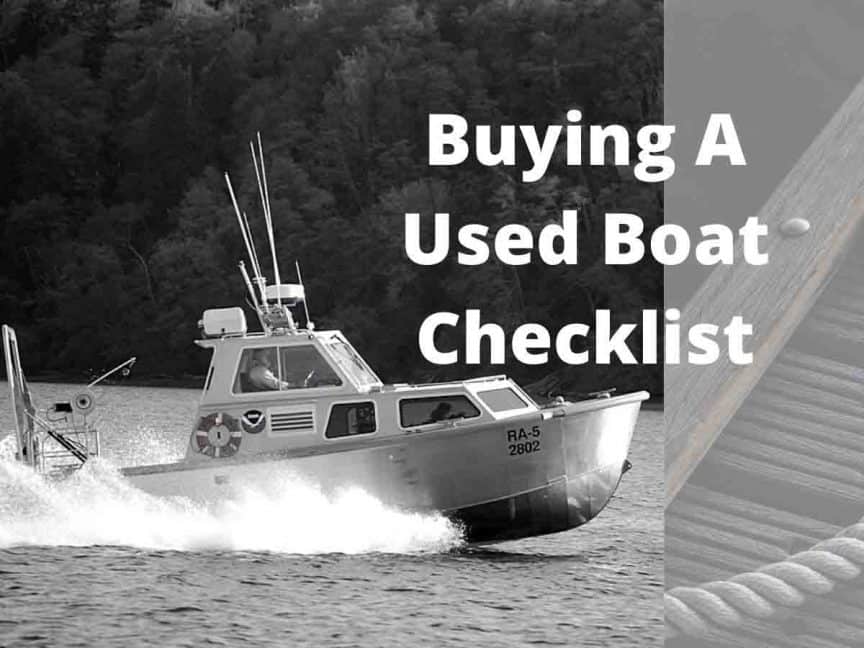
Buying a Used Boat Checklist For Avoiding Surprises
Buying a used boat is one of the easiest ways to achieve your sailing dreams, mostly if you have a little boating experience or a limited budget. Purchasing a used boat may be challenging and daunting, however, below are some of the things you should look into while buying a used boat.

Buying A Used Boat Checklist
Our Buying a Used Boat Checklist
When buying a used boat, one of the significant signs you should check out is the overall maintenance. The clues of the kind of love the boat had been portrayed eve in its fenders, lifejackets, and lines. Below are some of the things you should be keen on. You may also need to consult a pro when in doubt.
Think about your needs and use
Why do you need a boat? Do you use them for fishing or for having fun? How many people will be with you on the boat? Before going to get your boat you must think about these types of basic needs.
Another important point to think about is the type of boat you want. Think before you go for your one.
Don’t Forget to Check the Boat Documents
After selecting the type of boat, we need to confirm if the boat has registered documents. The documents will provide you with important information about the boat and the boat owner.
Check all the documents to understand the boat. You will be able to know when the boat has undergone services and revisions. If any part is changed recently, or if any of them needs to be changed, real conditions of the boat parts and many more things will come out through the papers.
Damage signs checkup
Moisture, flexing, mold, and cracking in the fiberglass and timbered areas such as transom, hull, and floor are indicators of decay, plywood delamination, fiberglass break down and decay in the stringers. These kinds of signs are indicators that the boat is not properly maintained.

Used Boat Inspection
If you find some problems in external inspection, try to estimate how much it may cost to repair the damages. Have a rough calculation to add to the expenditure list. For example, painting a boat will cost you time, energy, and money.
Oil testing
Be keen to identify engine wear and tear, which can be felt by the gritty feeling of oil between your finger. You should abandon the boat if the mechanic confirms it. The presence of milky oil in the lower unit or the engine means there is some water getting in.
A prop shaft that is bent can be uncoiled and worn out seal replaced. But that kind of impact might have caused some stress to the gears, and the bad news could be if the water is sipping in because the gears could get destroyed.
Examining fiberglass cracks below and above the waterline
Tiny cracks in localized parts are mainly cosmetic. They mostly appear around the screws that are not fixed correctly around the wind-shields, handles, and gunwales.
It is not much of a trouble, but it can get worse if not set. Cracks that exceed two inches indicate huge problems underneath. It would help if you asked whether the boat has ever been in a collision and also inspect for indicators that translate to massive repairs such as a gel coat. An expert is also very essential for the inspection.
Loose seat inspection
The loose seat could be as a result of the rotten floor or as a result of stripped bolts. The bolts get strained when one sits on the bench back while driving. The latter can get fixed quickly.
Mildew checkup
You should check whether the top of the boat, the seats, or the carpet has mildew or any other damage. Inspect the storage lockers also.
The covers and the upholstery can be replaced or cleaned, but lots of molds in the seats is not a good sign. Because fungi spread quickly, the areas with the spores may be an indicator of their presence in the wooden parts. A ski locker or a carpet, which is moldy, can also be a sign of more problems underneath.
Start the engine
Checking the engine is also crucial when buying a used boat. Check whether the engine start is a slip or rough, smoke, vibrate, or with a lot of noise. Plenty of oil or old gas in the first tune-up is easily fixed.
These symptoms are, however, indicators of more significant problems like low compression at the cylinders leading to the want of an expensive engine repair.
Inspect the electronics
When it comes to bilge pumps and burned-out bulbs, there are cheap solutions.
The presence of multiple devices failing to work could de due to a faulty battery or wiring is not a big problem. But when it comes to peeling up labels in the engine or melting of the insulation wires, there is trouble because that indicates that the driver is overheating.
Inspect the belts
Worn, thin, or cracked power-steering or alternator is a hint that the boat was not adequately maintained. The belts are supposed to be changed every 100 hours. When belts are damaged, laxity gets noted though you can cover it in your first service.
Survey the Boat if necessary
If you have selected a boat roughly but you don’t have sufficient knowledge to finalize the boat, you may take the help of a registered surveyor. It will definitely impact the cost of owning a boat .
This type of service is not very costly today. It may cost something like 20 to 50 dollars only. But you will get great professional support to confirm your boat.
The boat surveyors may be particulars, from the insurance or from an agency.
Surveying a small boat may take around 20 minutes.
Advantages of Buying a Used Boat

Buying a second-hand boat
Buying a used boat has its benefits; that’s why some buyers would prefer going a used one to a new one. Some of these advantages are:
One of the best advantages of buying a used boat is that you will buy the same boat at a lower price. The cost of a used boat is less compared to a new boat; therefore, if you happen to be on a tight budget, you can save a lot of money, if a good dealer with a quality boat can come along, one can be able to save a lot of money. But all the same, it’s good to check if every part of it is in excellent condition.
Purpose of the boat
The plan you have for the boat also matters. If your project is to use it for recreation purposes, the used boat is perfect for that use because it will not get used regularly. Most of the boats sold by the dealers are of good quality, but in case you are not satisfied with its looks, you can tailor it to your preference.
Additional items negotiation
When purchasing a brand new boat, you will spend quite a large amount of money on it and also on the additional requirements which are necessary as well. For example, you will require safety equipment and other things of that kind.
But when it comes to buying a used boat, you can acquire the additional materials by negotiating with the owner for a reasonable price. It will help you save a lot of money.
Record of maintenance
By checking the boat’s maintenance record, you will be able to identify the parts of the boat have been replaced. It ensures you are fully aware of the condition of the boat, and in case of any new items to be acquired, you may negotiate.
You can also give the boat a new look by painting it and mastering the parts that need more observation with the help of the maintenance record.
Disadvantages of Buying a Used Boat
Buying a used boat has its disadvantages. Here are some of the difficulties that come with buying a used boat.
No warranty
Most of the used boats are usually out of warranty for the engine, appliances, and equipment inside. This means if you decide to buy it, you will have to take it as it is, and in any complication that arises later, it’s all in your hands.
Hose clamp and rubber hose failure
A new boat rarely has the broken hose clamp or spitting hose failure. But when it comes to used boats, this is a common problem. A boat with a rotten hose causes the overheating of the engine and can as far as making the boat to sink.
Oxidized or faded gel coat
Worn out coat is a common problem in used boats. Reviving the gel coat’s luster is very hard unless the outboard had vigorous maintenance by baffling and compounding several times in a year.
Old styling
When someone is not familiar with boats, a used boat may look okay and great, but there are high chances that the styling is outdated. Like in the automobile world, boat designs change and advance after a minimum of four years and a maximum of seven.
Calloused-riding hull
Though most builders never talk about it, the fact is that most old boats have rocky –riding hulls. The reason for this mostly varies from brand to brand.
Poor electrical wiring
One of the most problematic systems in a used boat is the condition of the electrical wiring. Until the previous decade, the connected wires used to be exposed in the air and therefore corroded.
Wires go through the partitions which were not getting adequate protection from wearing. Tracing the wires when something has gone wrong and replacing junction blocks can end up being expensive.
Wrong perception
The status and pride of owning a boat make many people purchase one. However, buying an old boat is an indication that they can’t afford a new one; this ends up being more problematic to them.
Poor engines
Engine makers keep improving the engine’s efficiency over the years. It leads to more efficient engines in both inboards and outboards engines, which are more reliable.
Structures made of encapsulated wood
Many builders were using wood in the decks, transom, and stringers in the making of fiberglass boats. It would make the wood to end up soaking the water mostly because of the drilled holes into the transom. The wood would end up soft and dense, and to some point, it would even rot. So if one is not keen on buying a used boat, it may be problematic for them.
Buying a used boat can help you achieve tour sailing dreams and, at the same time, turn out to be a nightmare for you if you fail to do a thorough inspection before buying. Weigh your options wisely and make a decision that will assure you of value for your money.
Leave a Comment Cancel reply

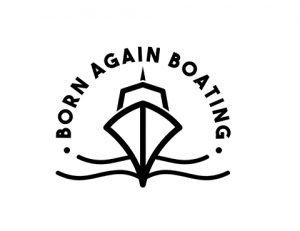
How To Inspect A Boat Before Buying & Avoid Buying Someone’s Problem!
Purchasing a boat can be a huge investment. It can be a great experience that lasts for many years. Or it could turn into a nightmare that leaves you disgusted to even see the boat. There are some ways to make sure you don’t get stuck with the nightmare option!
How To Inspect A Boat Before Buying: You need to inspect three major parts of a boat before buying it. You need to inspect the engine, the boat’s hull, and the components that are in the boat.
Here is a step by step guide to walk you through inspecting a boat and it’s components before purchasing it to make sure you don’t buy a dud!
Inspecting The Boat’s Hull
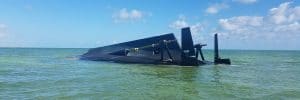
Doing the inspection in this order is important because it will save us time.
If the hull isn’t any good, then there’s no need in looking at the engine. Then if the engine is no good, then do we really need to spend the time looking over the boat’s components?
Now, as long as we aren’t talking about a project boat. Which is a little different because when looking at a project boat. We are expecting to see multiple issues with different things on the boat.
The inspection process is very similar, with the exception that we are weighing how much it will cost us to restore the boat. Verses how much we are going to pay.
We have another article dedicated to the Most Important Things That You Need To Know Before Buying A Project Boat. If you are interested in project boats, you’ll want to read that.
For a normal inspection though, we need to consider a few things.
Considering The Age Of The Boat
The age of the boat is going to play a big part in the boat inspection. Older boats will often have different issues with them.
You could be looking at having rotten major structural parts of the hull, but we’ll talk about that in a minute.
The older a boat is, the more damage you are going to find. So when inspecting, it’s important to keep this in mind because you don’t want to be looking at a 30-year-old boat.
While thinking about a five-year-old boat. They won’t look the same and we shouldn’t expect them to.
The stainless steel will rust a little, the aluminum components will start to pit. T-Top aluminum will get pitted, the canvas will get thinner, and if these things haven’t been cleaned for awhile. Then you will see that.
We want to look for broken components more than just dirty items. Since it’s a boat, there’s almost nothing that can’t be cleaned up or have new canvas put on it. As long as it’s not broken!
Here is a video of ours demonstrating how easy it is to clean and restring a T-Top with new canvas:
Checking The Outer Hull For Damage
We also need to run around the outside of the hull to look for damage.
We are looking for marks in the front and on the keel of the boat. To see if there is any location where the boat had an obvious hard grounding event.
If you have spent enough time on the water, then you will have eventually hit the ground. At least once or twice, maybe even more than that! It happens, it’s not that big of a deal.
As long as it wasn’t too hard and on a hard rocky surface. That can cause significant amounts of damage, then it’s no big deal.
Here’s an article that we have written about What To Do When You Run Aground In A Boat! You will find that super helpful if you haven’t already run aground and found out the hard way yet!
We will also be looking at the transom of the boat. Making sure that the transom isn’t rotten. We can check that by just tapping around on it in different locations. Listening for a hollow sound.
If it sounds hollow. Then the transom is rotten in those locations and will be questionable, depending on how bad it is.
We need to go around the entire hull listening for these hollow sounds. As well as inspecting for damages to the fiberglass.
This will show us the condition of the exterior hull.
Making Sure The Hull’s Stringers Are Solid
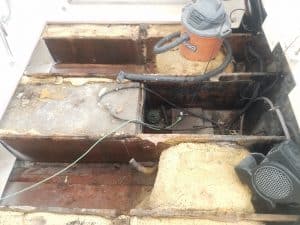
Again, depending on the age of the boat is going to determine how important this is. Most boats from the past 20 years are not made from solid wood.
Therefore, they don’t have the same likeliness of having a rotting transom or stringers.
The boat’s stringers are pretty easy to check. These are the part of the boat that gives the hull it’s structural strength.
They generally run from the bow of the boat, all the way through to the back of the transom. We can simply take a hammer and knock on them in order to listen for that hollow sound again.
With a solid thud, we can have confidence in the stringers and move onto other parts of the boat.
Inspecting The Boat’s Inside & Compartments
Knowing that the boat has a solid hull and solid stringers. We can look through all of the compartments of the boat.
Opening up every hatch and looking down into all of these compartments. What we are looking for is just the general condition of the compartments.
Are they clean? How is the wiring inside of them if they have wiring in them? Is anything coming with the boat?
These are all questions that we can answer as we look through this part of the boat. Think about the hinges, the latches, and the way they close. How is water going to flow around the access?
Does it look like water will run around or away from the compartment? Or is it apparent that water runs directly into the compartments, leaving you with no dry areas on the boat!
As long as you are pleased and everything checks out. We can move onto checking out the integrity of the engine!
Inspecting The Engine
Performing a visual inspection of the engine.
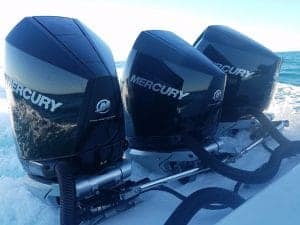
With all of the advancements in technology, they are getting more reliable though. More fuel-efficient, and smoother running with less shaking and oil smoke.
Which makes for a more desirable experience while on the water. In order to know what the condition of the engine is. We will want to do a visual inspection of it, just like we did with the boat.
We will want to take the cowling off and look around the engine. Looking for massive amount of salt build-up, water markings, rust, and other visual aspects of the engine.
Look at the propeller and see if it has any dings or markings. What does the lower unit look like? Is the paint all marked off and it looks like it was drug across the ground?
This will get us started with the engine inspection.
Making Sure The Engine Has Spark & Compression
After the visual. We want to check the integrity of the engine. This is done by way of performing a spark and compression check of the engine.
We will need to remove the spark plugs for this test. Which will let us know about how old they are, just by looking at the plugs.
Then the spark test is going to let us know that the ignition system of the engine, is basically operating properly. Telling us that all of the cylinders are sparking.
The compression test is the life of the engine though. Without compression, the engine is worthless!
Then, on the other hand, though, low compression will let us know that the engine is actually. Possibly on its way out the door.
If you are unsure of performing a spark and compression test. You will want to read this article that we wrote. It will teach you Everything You Need To Know About Outboard Compression Tests!
Now as long as everything checks out with the compression test. We can move onto another expensive portion of the engine. Being the lower unit or gearcase!
Checking The Engines Lower Unit
The engine’s gearcase can get up over $5,000 to replace it if it blows up! So knowing that it is in great condition is something we want to know about.
We can do this by simply pulling the prop off and checking to see what the lower unit prop shaft seals look like. These seals are replaceable and we have a video, as well as an article to teach you The Easiest Way To Change Outboard Prop Shaft Seals.
Depending on how these seals look, it will tell us a little more about the condition of the lower unit.
If they are all burned and have fishing line stuck in them, they are probably a candidate for being replaced!
The next thing we will do is we will inspect the lower unit’s gear lube condition.
This is simply done by slowly unscrewing the drain seal. Then barely opening it so that a little bit of gear lube comes out of gearcase.
The color of the lube is going to tell us a lot about the condition of the unit. We won’t break down all of the different colors here.
For a more in-depth description of the different colors and what they mean. Read our article that teaches you all about The Different Colors Of Outboard Lower Unit Oil & What They Mean.
Looking At The Engines History & Codes
The last thing that we will look at on the engine. Is the engine’s run history and fault codes.
Most engines that have been manufactured in the last 20 years. Will have the ability to show you these two things.
The engine will store the run history and all fault codes, with some interesting information to go along with it!
It’s pretty amazing, the run history is actually broken down into RPM ranges as well. That means that you can see how many hours the engine was run for and at what RPMs.
For example. Usually, this is broken down into something like:
- 0-1,000 RPMs: 850 hours
- 1,000-2,000 RPMs: 300 hours
- 2,000-3,000 RPMs: 400 hours
- 3,000-4,000 RPMs: 500 hours
- 4,000-5,000 RPMs: 75 hours
- 5,000-6,000 RPMs: 60 hours
- 6,000+ RPMs: 2 hours
- Total Hours: 2,187 hours!
This is actually really useful and will tell us a lot about how the engine was run and taken care of.
Giving us a good overall understanding of what condition this engine is in.
Now, you can get a lot more hours out of an outboard then only 2,000 depending on how it is taken care of. Here is an article that we wrote that will show you How To Get More Hours From Your Outboard!
Inspecting The Boat’s Components & Systems
Inspecting a boats fuel tank.
With a good hull, great engine, and almost a full inspection done. We want to take a look at a couple of things before we sign on the dotted line.
One of them being the boat’s fuel tank. You never want to have to get on the boat and smell fuel! That’s a terrible feeling, and in case you ever run into that situation. Here is the information for What You Should Do If Your Boat Smells Like Fuel!
We are going to look into the fuel tank access port and see what the top of the fuel tank looks like.
You want to see a clean, nice, good looking tank. You don’t want to see a bunch of sludge, slime, dirt, and corrosion build up on the tank.
That could mean that it is getting close to the point where the tank will need to be pressure tested. And then possibly removed and replaced!
Which can be a super expensive task and something that you want to know about before it happens to you!
Looking Over A Boat’s Wiring
One of the last couple of things that we need to consider in the inspection. Is the condition and situation that is going on with the boat’s wiring.
If you see a bunch of home electrical connectors. Un heat shrank connectors, and just wires laying everywhere in a rats nest.
Just remember that someone is going to have to mess with that when things start to stop working.
You want to make sure that you know what you are doing before you just up and say that it is ok. This is a huge problem area and can turn into a nightmare.
If you are comfortable with DC wiring, then it isn’t as big of a deal. But if you don’t know anything about it. Just be aware that this is eventually going to be an expense, and do you want to be paying for it?
Thinking Ahead About The Electronics
The same thing goes for electronics. These can get super expensive and depending on the age and condition.
Is this an expense that you are looking forward to? If the electronics screens are illegible, then are you going to replace them at the cost of new electronics.
Or could you use someone like Gaugesaver.com to help you? They can change the screens and fix the LCDs to make them legible.
But are they so outdated that it isn’t worth it?
Just be aware of this and have a plan for this expense in case it is fitting for the boat that you are inspecting!
You can also check out our video on this entire process here:
Check Us Out!
Now that you know how to inspect a boat! Here are a couple more articles from us that you will find super helpful!
How To Tie Up A Boat! Don’t Wake Up With it Underwater!
Can boats be stored outside in the winter yes or no.
We’d also like to invite you to check out Our YouTube Channel! We create all kinds of How-To and DIY videos to help you learn more and more about your boat and how it works!
Aaron Hilligoss
Aaron has been working in the Marine Industry for over a decade and holds certifications for Yamaha and Mercury Marine. It is not uncommon for him to own and be working on at least three different boats at any given point in time!
Recent Content
Accidentally Put Boat In Reverse While Driving?
When running a boat. Things can pop up in the water in the way at any moment! And our first reaction is to pull out of gear. But. If You Accidentally Go Too Far And Put Boat In Reverse While...
Can I Run My Outboard Without A Poppet Valve?
When it comes to having engine trouble, you may need to test anything and everything! Even a poppet valve! Can You Run An Outboard Without A Poppet Valve? Yes, you can run the engine for...
There was a problem reporting this post.
Block Member?
Please confirm you want to block this member.
You will no longer be able to:
- See blocked member's posts
- Mention this member in posts
- Invite this member to groups
- Message this member
- Add this member as a connection
Please note: This action will also remove this member from your connections and send a report to the site admin. Please allow a few minutes for this process to complete.

Boating Basics Online is reader-supported. When you buy via our links, we may earn a commission at no cost to you. Learn more
What to Look for When Buying a Used Boat? (Checklist)
Written by J. Harvey / Fact checked by S. Numbers
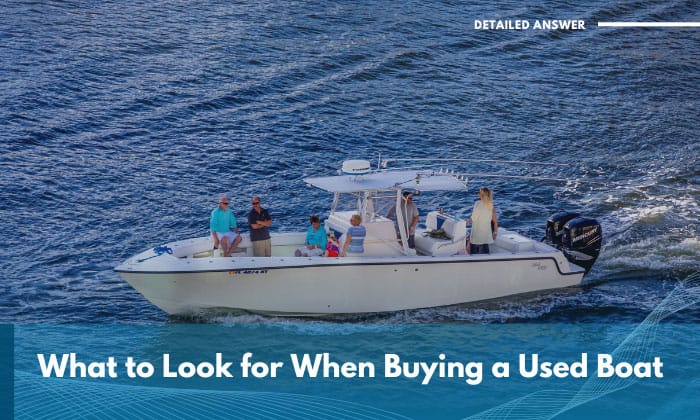
Has the sea and boating life started calling you lately? Even if you’re a sailor at heart, it’s understandable that you can get a little lost when selecting your first vessel.
Naturally, one of the questions that pop up is “What to look for when buying a used boat?” In short, keep these things in mind:
Start by inspecting the important parts such as the engine, battery, and hull. Any issue like leaks, holes and other damages is a red flag.
From there, examine the rest of the vessel. Finally, check the title for any hitches like outstanding loans.
Table of Contents
1. Type of Boat and Budget
2. engine and hull, 3. the deck, cabin, and electronics, 4. title and registration, don’t hesitate to let the pros handle the inspection for you, frequently asked questions, your used boat checklist.
As far as things to look for when buying a used boat, you have to approach it similarly to how a meticulous detective analyzes a crime scene. No less than a thorough inspection of the prospective vessel will suffice if you want to get the most bang for your buck.
While I did say that it doesn’t hurt to examine the entire boat and all its parts, there are vital components you need to prioritize.
Should these have any issues, I’ll just say that you won’t have an enjoyable experience. Chances are, you might not even be able to launch your boat!
So, never overlook the following:

Before buying a boat or any other vehicle for that matter, you need to be sure of what type to buy. Pinpointing the one you want determines the budget range you’ll need to prepare.
Do you like a more practical sailboat or center console or a snazzy yacht or catamaran to host and entertain your friends in?
How’s your current boating and sailing skills – as much as possible, they should be matched with the type of pre-owned boat you’re planning to buy.
Moreover, when buying a used yacht, you shouldn’t be solely concerned about upfront costs. Always anticipate that you’ll be shelling out quite a sum of money to keep it in great condition over the years.
In any case, you’ll have to set aside around 10 to 20% of the total boat cost for maintenance.
That said, used yachts do have a rather seesawing price range of a couple of thousands to millions, so it’s best to stick to what you can afford . I can say the same when buying a used sailboat.
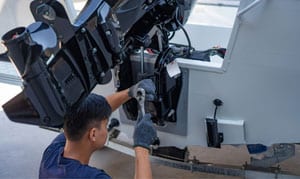
Do these two still look good, if not great or close to flawless? Make no mistake, you can’t compromise on either one.
Why? Having any issues like fuel leaks in the engine and cracks and holes in the hull means you can’t launch your boat in the first place!
When it comes to used boats to avoid, I steer clear of those with broken diesel engines, as replacing these can add thousands of dollars to the purchase. Unless you have a limited budget (around 20 grand), find a functional boat that only needs basic repairs.
- Is the engine still running smoothly (any smoke, noise, corrosion)? Does the starter motor work well with it?
- Boats with outboard motor also need to be checked for potential fuel leakages and how smoothly the starting system works. It shouldn’t be running with low flow and the impeller should be in working condition, especially if it’s been used mostly in saltwater.
- Are there spots in the hull where water may freely enter? Well-made genuine fiberglass boats shouldn’t have durability issues – if at all.
Take Note: Having stress cracks and signs of oxidation damage may mean that the vessel wasn’t well-maintained. Both issues are highly preventable, after all.
- What is the maintenance history of both the engine and hull? (Clue: check the service records!)
- Are there any evident and subtle structural problems on the two?
These are but some of the fundamental questions to ask when it comes to these two important parts.

On the deck, you want to be looking at largely the same problems you may encounter on the hull. Things to check include water damage due to leaks, plus cracks and scratches, which tend to plague most decks.
Obviously, it’s where you and your passengers will likely be spending most of your time, so be on the lookout for signs of wear and tear on the current paint job.
The same rings true for loose railings, cleats, winches, and other essential safety and anchoring components.
The deck extends to the cabin, which houses most of the boat’s electronics as well. Naturally, you can’t be traveling without a properly functioning GPS, radar, throttles, lights, and radios.
While you’re at it, have the electrical system of each gadget inspected or ask for an updated comprehensive report from the current owner. Any glaring damage on the wires warrants double-checking.

When boat buying experts say, “Inspect a boat before buying,” they also mean looking at the papers. The hitches I mentioned above often involve liens and loans still tied to the vessel.
It’s up to you to ultimately discuss any outstanding financing that you may have to shoulder. I’ll be blunt in saying that you’re more at risk when buying from a private seller because there’s often no warranty thrown in.
Also, he or she may not readily disclose that they’re still financing the boat until the deal has been sealed. I can’t stress the importance of dealing only with sellers who are transparent about everything.
Be 100% sure whether the boat is titled or not, as every state has different requirements when it comes to registration. For example, in California, all motorized vessels and sailboats that are 8+ feet need to be registered.
You’ll also be asked for a bill of sale if you bought from a private seller. The seller should be able to provide both the transferable title and bill of sale for you.

At the end of the day, my tips for buying a used boat can only go so far. If you want to have complete peace of mind, I suggest you go ahead and have it professionally inspected.
Still, it doesn’t hurt to know which factors you should be paying close attention to. Also, by reading this guide, I hope that I’ve convinced you that you can’t ever skimp on maintaining your boat if you want to preserve its value and assure its longevity.

What questions should I ask when buying a used boat?
The used boat buying guide above already outlines a couple of important questions . Be sure to remember them.
You can take things further by asking these as well:
- Does the boat come complete with necessary (by law) safety equipment such as personal flotation devices (PFDs) and fire extinguishers?
- Could you tell me of any past issues you’re aware of?
- Has the craft been used mainly on freshwater or saltwater?
- What’s the ideal way to store the boat?
- How did you arrive at the current asking price?
How many hours on a used boat is good?
The lower, the better. 1000 hours are the ceiling for inboard and outboard motors.
Still, I subscribe to the philosophy that age is also just a number for boats. As long as it’s well taken care of, it can give you a pleasurable experience every time.
I have my own 50-year-old boat as proof of that.
Is it a good idea to buy a used boat?
Certainly. Not only will you be able to buy the boat of your dreams for far less money, but you may just end up with a vessel that still functions as good as new.
Of course, the opposite applies to those who don’t know how to buy a used boat.
On the whole, purchasing a used boat can lead to either of the following scenarios: you end up with a darling you just can’t drive enough or a problem child that will only leave you with a headache after headache.
Now that you have a solid grasp on what to look for when buying a used boat, you should be able to spare yourself from the hassles of needless repairs. I can definitely attest that age isn’t a big factor when it comes to boats, and you can even get superb ones out there for cheap prices.
You just have to be able to pinpoint which ones are well-maintained and which ones aren’t.

“My intention from the first day establishing Boating Basics Online is to provide as much help as possible for boaters who want to experience a first safe and convenient trip. So feel free to join us and share your beautiful journeys to the sea!”
- 2024 BOAT BUYERS GUIDE
- Email Newsletters
- Boat of the Year
- 2024 Freshwater Boat and Gear Buyers Guide
- 2024 Boat Buyers Guide
- 2024 Water Sports Boat Buyers Guide
- 2023 Pontoon Boat Buyers Guide
- Cruising Boats
- Pontoon Boats
- Fishing Boats
- Personal Watercraft
- Water Sports
- Boat Walkthroughs
- What To Look For
- Best Marine Electronics & Technology
- Watersports Favorites Spring 2022
- Boating Lab
- Boating Safety

Used-Boat Buying Secrets
- By Jim Hendricks
- Updated: August 19, 2021
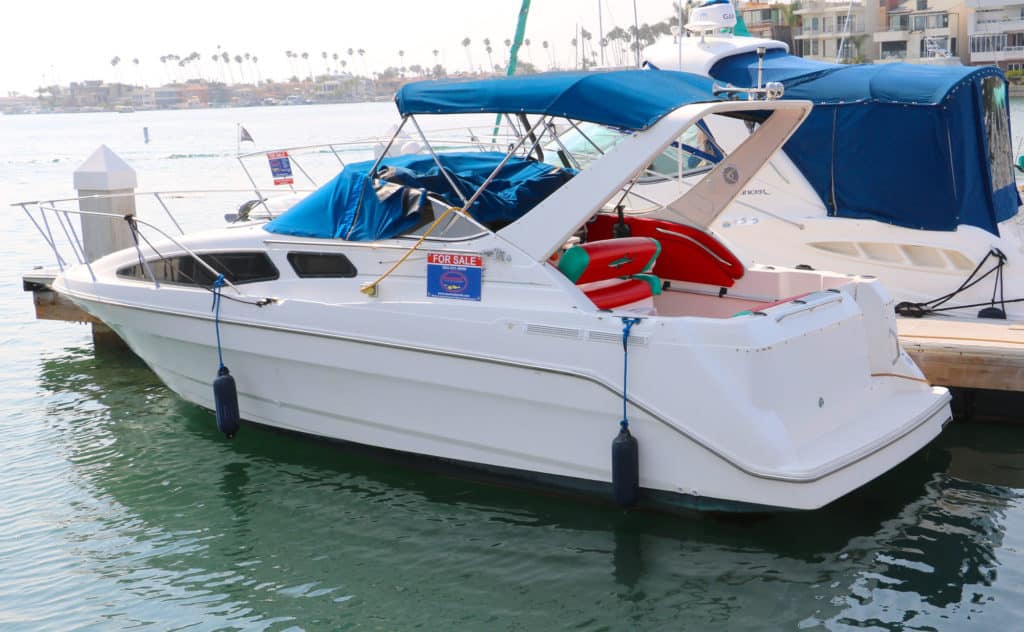
As the market for new boats booms and bargains evaporate, buying a used boat represents an alternate approach to achieving ownership. Though the same factors spurring the boom market have increased demand for used boats, these vessels already exist, so you don’t have to wait for delivery.
The key is finding the right used boat, says Kim Slocum, who also buys—then refurbishes and sells—previously owned boats from private parties. Slocum focuses mainly on boats from Rinker, a brand he knows inside and out from his 47 years with the company, where he ascended to president and part owner.
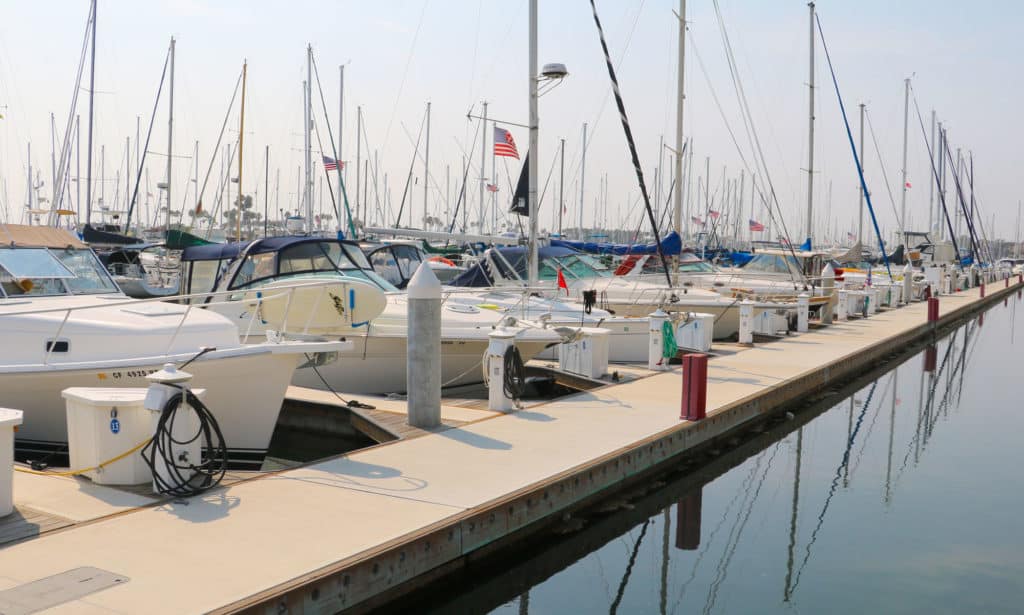
Slocum emphasizes due diligence when shopping on the used-boat market. His first step is to call the seller and pose a series of questions. If he hears what he likes, he personally inspects the boat. “If you’re not familiar with the brand, take along a friend or mechanic who is,” Slocum advises.
He has developed a list of key questions and an inspection routine that helps weed out the clunkers and leads him to good private-party used boats. Slocum shared his insight with us.
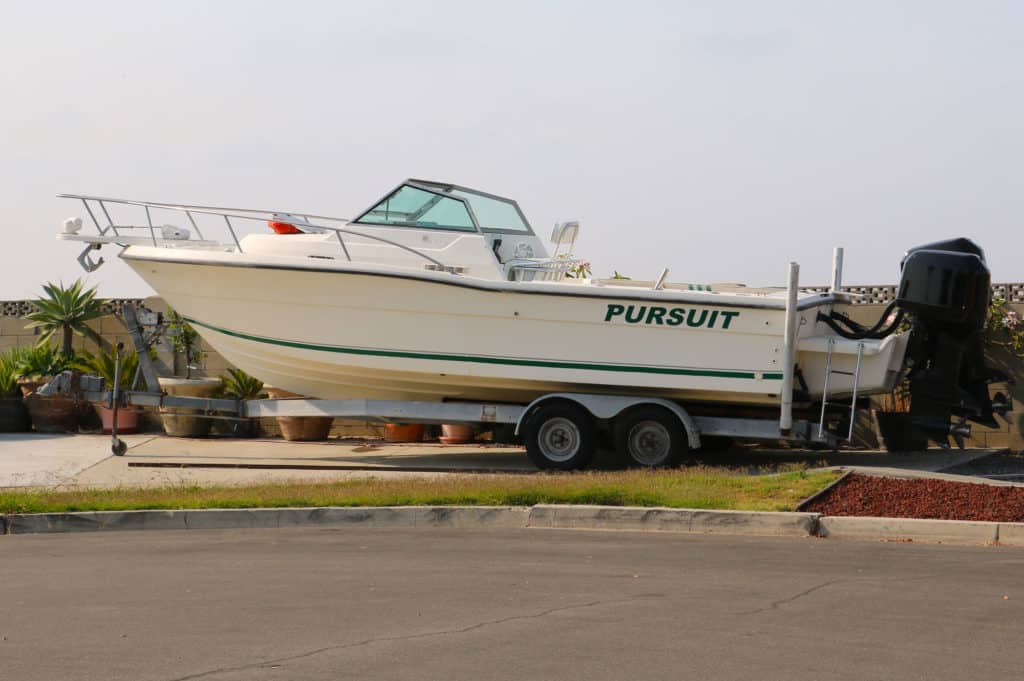
Key Questions
1. What year is the boat?
The more recently built, the better, Slocum says. Avoid boats more than 20 years old.
2. Where was the boat used?
Exclusive use in fresh water enhances the value of a used boat because this helps minimize any corrosion issues versus use in salt water. However, boats used in marine environments can still be solid candidates. In coastal regions, these might be the only used boats available.
3. What are the engine hours?
This tells you how tired the engine and drivetrain might be.
4. Is the seller the original owner?
An original owner tends to take better care of a boat, so this is a definite plus when looking at used boats, Slocum says.
5. What does not work?
Asking the seller to reveal issues can save you time, and it might give you something to bargain with if you choose to buy the boat.
6. Does the seller have the title in hand?
This allows you to take delivery immediately. It is a big bonus, Slocum says. Otherwise, prepare to spend time meeting with the lien holder and seller to clear the title.
7. Are the boat and motor still under warranty?
If so, find out if these warranties are transferrable and how you can arrange to move them into your name.
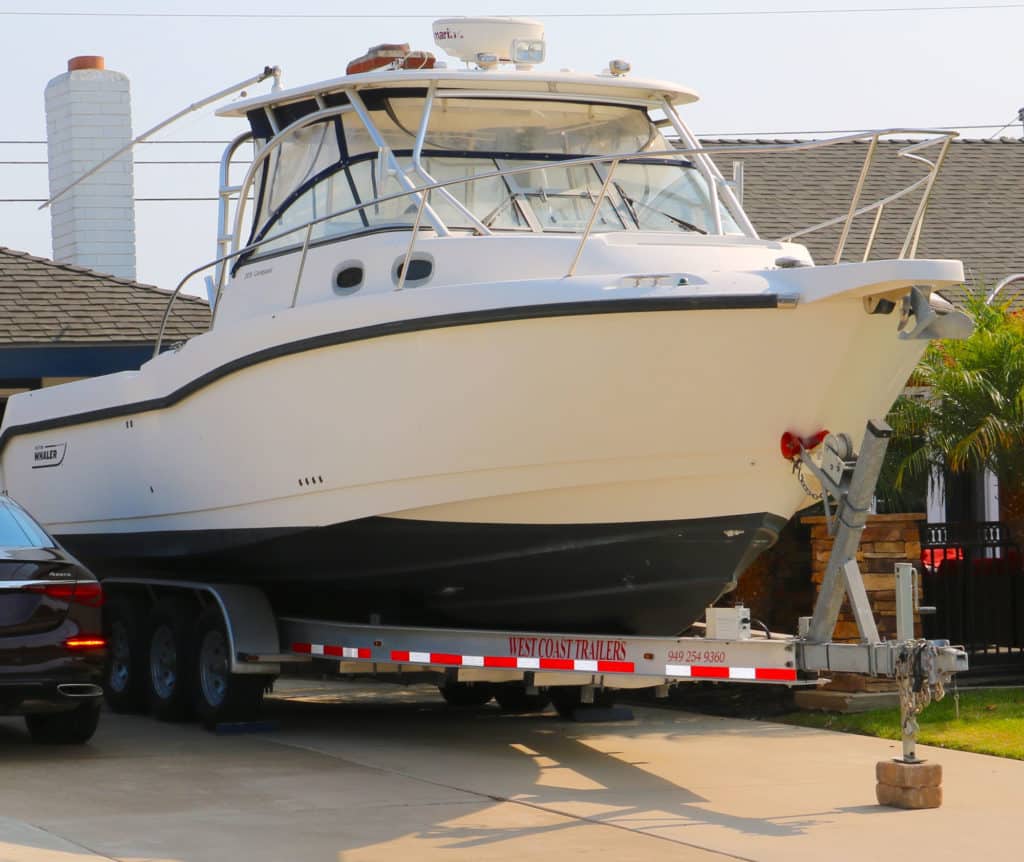
Key Inspection Points
1. Inspect the engine bay.
If the boat is a sterndrive or inboard, the condition of the engine bay will tell you a lot about how well the boat is maintained. Is it clean and dry? Is rigging neat and well-supported? Is it free of rust and corrosion?
2. Look for rips in the upholstery or deck carpet.
Reupholstery and carpet work are expensive, so keep that in mind as you inspect the interior.
3. Start up everything.
Fire up the electronics, generator, air conditioning, all pumps, lights, stereo, trim tabs, drive trim, etc., as well as the engine(s). Make sure everything is in good working order, and make note of any issues.
4. Double-check the engine hours.
Don’t trust engine-hour meters, Slocum says. Consider paying a boat mechanic to hook the engine up to scan tool to confirm the hours and look for possible issues, he advises.
5. Conduct a sea trial.
By any and all means, don’t buy until you conduct a sea trial to determine how the boat performs in real-world conditions, and determine any issues. While on the water, look in the bilge for leaks. For more tips on how to sea-trial a boat, visit boatingmag.com/how-to-sea-trial-boat .
6. Have the boat hauled.
If the boat is not on a trailer, arrange to have it hauled to inspect the bottom for obvious defects such as hull blisters, damaged running gear, excessive fouling, broken trim tabs, etc.
7. Look for decay or rot.
This is a tough one because transom or stringer rot might not be obvious. One trick is to push up and down on the drive or outboards. If the transom deflects or feels mushy during this process, it is an indication of rot. If in doubt, spend the money for a survey. The larger the boat, the more important a survey becomes, Slocum says.
8. Inspect the trailer, tires and bearings.
If the boat is on trailer, you need to know if it is road-worthy. Make sure the frame, axle and springs are free of excessive rust and cracks, and the bunks and rollers are in good condition. Check the tires for proper air pressure, and look for obvious signs of age such as cracked sidewalls. Ask the seller when the last time the bearings were serviced. For more trailer inspection tips, visit boatingmag.com/how-to/check-your-trailer-towing-your-boat-vacation .
9. Be prepared to walk away.
While this is not an inspection point, it is an important mindset when shopping for used boats. “Don’t get too excited or fall in love with a boat you’re inspecting,” Slocum says. “You need to be able to walk away if something’s not right or the price is well outside the number you had budgeted.” For more used-boat inspection tips, visit boatingmag.com/boats/boat-inspection-checklist .
- More: how to buy a boat , How-To , Used Boats
More How To

I Learned About Boating From This: Capsize, Rescue and Lessons Learned

Should You Abandon Ship During a Boat Fire?

38 Top Make-Ready Tips for the Spring Boating Season

On Board With: Andrew Robbins
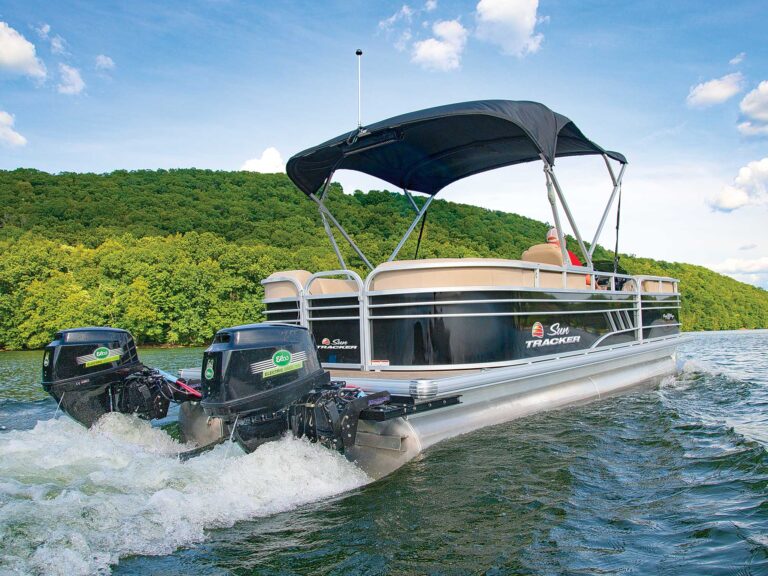
Using Hydrofoils to Improve Boat Performance
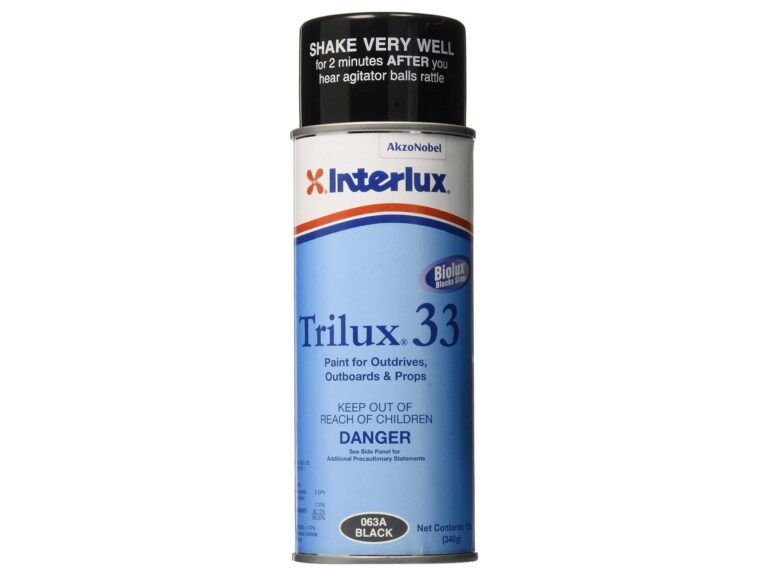
We Test Interlux Trilux 33 Aerosol Antifouling Paint

Boating Shoes for Spring and Summer

MasterCraft Celebrates International Women’s Day With Fourth Annual ‘Let Her Rip’ Campaign

- Digital Edition
- Customer Service
- Privacy Policy
- Cruising World
- Sailing World
- Salt Water Sportsman
- Sport Fishing
- Wakeboarding
Many products featured on this site were editorially chosen. Boating may receive financial compensation for products purchased through this site.
Copyright © 2024 Boating Firecrown . All rights reserved. Reproduction in whole or in part without permission is prohibited.
JavaScript seems to be disabled in your browser. For the best experience on our site, be sure to turn on Javascript in your browser.
- Compare Products
ALL THE SUPPLIES YOU NEED TO GET YOUR BOAT BACK IN THE WATER ARE 10% OFF NOW! DISCOUNT APPLIED AT CHECKOUT

781-246-7401
Product Search
Proceed to checkout.

10 Essential Tips for Inspecting Used Boats Before Purchase

- Back to Blog

Purchasing a used boat can be an exciting and cost-effective way to enter the world of boating. However, it's crucial to thoroughly inspect a pre-owned boat before finalizing the transaction to ensure that you're making a wise investment. This comprehensive guide offers tips for inspecting used boats, helping you identify potential problems and make an informed decision.
- Research the make and model
Before you start inspecting a used boat, take the time to research the make and model. Look for information on common issues, typical maintenance requirements, and the boat's overall reputation in the industry. This background knowledge will help you identify potential red flags during your inspection.
- Check the hull and exterior
The boat's hull is an essential component, so pay close attention to its condition. Look for signs of damage, such as cracks, blisters, or dents. Inspect the gelcoat for fading, chalking, or discoloration, which may indicate sun damage or inadequate maintenance. Check the keel, rudder, and propeller for any signs of corrosion or damage.
- Examine the deck and hardware
Inspect the deck for soft spots, which could suggest water intrusion or rot. Pay attention to hardware, such as cleats, railings, and winches, ensuring they're secure and in good working order. If the boat has a mast and rigging, check for corrosion, wear, and proper tension.
- Assess the interior
Check the boat's interior for signs of water damage, such as mold, mildew, or rotting wood. Inspect the upholstery for wear and tear, and ensure that all appliances and fixtures are functional. Look for any signs of leaks or moisture around windows, hatches, and through-hull fittings.
- Inspect the engine and mechanical systems
A boat's engine is a critical component, so take the time to inspect it carefully. Check for signs of oil leaks, corrosion, or excessive wear. Ask for maintenance records and ensure that the engine has received regular servicing. Test the boat's electrical systems, including lights, switches, and gauges, to ensure proper functionality.
- Test the plumbing and sanitation systems
Inspect the boat's plumbing and sanitation systems, including freshwater and wastewater tanks, pumps, and hoses. Look for any signs of leaks, corrosion, or blockages. If possible, test the water pressure and ensure that the toilet and holding tank are in good working order.
- Verify the electronics and navigation equipment
Ensure that all electronic and navigation equipment is functional and up-to-date. Test the VHF radio, GPS, depth finder, and any other relevant devices. Keep in mind that outdated equipment may need to be replaced, which can add to your overall cost.
- Conduct a sea trial
A sea trial is a crucial part of the used boat inspection process, as it allows you to evaluate the boat's performance and handling on the water. During the sea trial, pay attention to the boat's acceleration, steering, and maneuverability. Check for any unusual vibrations, noises, or smells that may indicate a problem.
- Hire a marine surveyor
If you're not confident in your ability to thoroughly inspect a used boat, consider hiring a professional marine surveyor. They will provide a detailed assessment of the boat's condition and help you identify any potential issues that may not be visible to the untrained eye.
- Negotiate based on your findings
If you identify any issues or required repairs during your inspection, use this information to negotiate the purchase price. Be prepared to walk away from the deal if the seller is unwilling to address major problems or adjust the price accordingly.
By following these tips for inspecting used boats before purchase, you can feel confident in your decision and avoid costly surprises down the line. Remember that thorough research, a careful examination of the boat's condition, and professional assistance when needed are all critical components of the buying process. Ultimately, investing the time and effort to properly inspect a used boat will help ensure that you find a vessel that meets your needs, provides enjoyable experiences on the water, and stands the test of time. Happy boating!
- A Step-by-step Guide on Removing Old Boat Lettering and Graphics
- Electric Principles for Boats: A Comprehensive Guide
- Navigating the Dangers: What to Do in a Lightning Storm on a Boat
- Navigating the Laws of Boating Under the Influence of Alcohol
- The Top Boat Shows of 2024 You Don't Want to Miss

Boat Inspection Checklist: For Buying A Boat
This article serves as a comprehensive guide to boat inspections, providing a detailed checklist to ensure you buy a vessel that is safe and seaworthy.
Boat inspections can be daunting, with so many components to check and potential issues to uncover. This guide aims to alleviate that stress, offering a systematic approach to ensure nothing is overlooked.
Leveraging insights from experienced skippers, marine surveyors, and the nearly 50 years’ worth of experience of our editorial team. Here is a thorough checklist that covers everything from the hull’s integrity to the functionality of electronic equipment.
We’ve broken down the inspection process into clear sections, making it easy to follow regardless of your boating experience.
At a Glance: 1️⃣ A pre-purchase inspection to ensure the boat is in the advertised condition. 2️⃣ An annual inspection that may be required by US Coast Guard regulations or as a safety consideration of your own. 3️⃣ For insurers to satisfy themselves regarding the risk and value they are taking on. 4️⃣ Whether required by regulations or not, a regular boat inspection is a good practice and may save you substantial costs later.
📝 What Should Be Checked Before You Buy A Boat?
If you have found the boat of your dreams and want to put in an offer, make it subject to the following suspensive conditions:
1️⃣ The boat passes a marine survey carried out by a suitably qualified surveyor.
2️⃣ All service and maintenance records are available (this will give you the security that the boat has been regularly maintained).
3️⃣ The boat has not been involved in any serious incident that caused major damage in the past.
4️⃣ To verify the accident history, past insurance records should be available. These can be used to check with past insurers to determine if it has been the subject of significant insurance claims (You may need a letter from the seller authorizing you to obtain these records).
5️⃣ That a full inventory is provided of all the items included in the sale (you don’t want to argue these issues once ownership has been transferred and payment made).
6️⃣ Examine the exhaust for holes, as this can allow water and exhaust gas into the interior space and bilge of the boat.
7️⃣ Find out the quantity, size, and type of fixed fire extinguishers on the boat.
🎱 Whether you’re using your boat for fishing, wakesurfing, skiing, diving, day cruising, or overnighting, remember to pack essential safety gear .
Once the above has been agreed upon, it is time to begin the boat survey.
✅ What Is Checked During A Boat Survey (Motor And Sail)?
The items that are checked on a boat depend on the type of boat being checked. The items common to all boats (sail or power) include the following:
🚤 The Hull And General Integrity
The boat should be checked and the following confirmed:
In addition to the checklist above, you’ll want to methodically go through each item below to ensure the general integrity is up to par.
If there is a rail around the side of the deck, check that it is secure, and there is no corrosion.
Ensure all the glass installed on the boat is in good order and does not need replacing.
Check the deck for signs of damage and water ingress. Crawl and inspect for blemishes, cracks, and soft spots. Tap with a screwdriver handle to detect changes in sound. Pay attention to deck joins. Investigate any changes in sound to ensure structural integrity.
Check the integrity of the hull-to-deck joints, whether they are glued, bolted down, or glassed.
Make sure there are no gaps in the lockers, between the cabin furniture and the hull, or in any other compartments. These areas can be potential sources of water ingress if compromised.
Check the condition of all of the trim on the boat. If trim is missing or is becoming loose, investigate why this is happening.
The cause may be water ingress and possible wood rot behind the trim.
Check the condition of all boat hardware, ensuring (where appropriate) that it is in working order and remains tightly secured. The items to be checked include the following:
- Anchor windlasses and the electric motors, if fitted (test the windlass operation).
- Check the condition of the anchor and its chain.
- The cleats are secure and in good condition.
- If the boat has outriggers, check their condition and operation.
- If the boat has a tower, ensure it is securely attached and in good condition.
- If the tower is a collapsible model, test that it moves to each position.
Check that all hatches are in good condition. Things to check with hatches include the following:
- They are securely mounted, and the hatch hardware (hinges and latches) are not rusted.
- Check behind the mounting to ensure there is no wood rot.
- Check that all the hatches close easily and are not swollen due to water ingress.
- Check that all latches work.
🛋️ Interior Accommodation
The boat’s interior should be well-maintained, warm, and watertight.
Check for signs of water damage, such as water stains, peeling paint, corrosion, damp smell, and moisture in the cushions and carpets.
These indicators suggest potential leaks and require attention.
If these signs are present, you must find the reason, and if this cannot be fixed, it is time to cancel the deal.
When checking the interior, also check the following:
🛞 Helm And Steering System
Check that the helm station functions correctly.
📻 The Electronic Equipment Is Operational
All electronic equipment must be checked, which may include the following:
🚥 Navigational And Accommodation Lights
Check the condition of all the lights, firstly that the wiring is in good order, and secondly that they all work. These include all navigation lights for safety requirements and all interior lights.
⚙️ The Boats Engine
Whether the boat has a gas-powered outboard, inboard, or diesel-powered power plant, it is very important to check on the condition of the engine(s).
If the engine overshoots or does not reach the manufacturer’s maximum rpm range, something may be wrong with it or the propeller.
Check the general condition of the engine housing and the engine itself.
- Check the general condition of the engine compartment (not outboards), which will give you an idea of how the engine has been kept.
- Ensure the engine compartment blower system works and the ventilation holes are not blocked.
- Ensure that the engines appear clean and free of dirt and oil stains.
- Ensure there are no obvious cracks in the engine mountings.
- Ensure there is no loose standing water or oil.
- Ensure there are no puddles of water or moisture.
Once you have satisfied yourself regarding the engine placement, you can begin more detailed engine checks.
- If it is a gas-powered engine, pull the spark plugs out and check the condition of the electrodes (some engine diagnoses can be made by studying the condition of the spark plugs.)
- Inspect the engine block, the exhaust manifold, and the oil sump for any leaking or any sign that they have been overheating (the condition of the spark plugs provides a clue in this regard.)
- Check the integrity of the engine exhaust.
- Check that there is no apparent rust on the engine mountings, propellor shaft , or other areas.
- Check the integrity of the engine mountings and ensure that the engine(s) are secure.
- Check all of the hoses to ensure they are in good condition – on an older boat, these may need to be changed.
- Check the belts’ condition to ensure they are not frayed and are set at the correct tension.
- Check that there are no oil and hydraulic fluid leaks and that the gaskets and seals are in good condition.
- Check the fuel injectors for leaks (stains) around the fittings.
- Check that the impeller housing(s) is/are intact.
Check the levels and condition of the engine fluids.
- Check the oil levels (with the dipstick).
- Check the condition of the oil (if it is grey, it may mean that water has been allowed to ingress the tank or there is a problem with the head gaskets).
- While the dipstick is visible, check it for rust or other damage.
- Extract gas (or diesel) from the gas tank(s) and visually check the condition.
- Check the fuel filters for sediment or other impurities that may be carried from the gas tank to the engine.
Check all of the fittings associated with the engine.
- Check the condition of the propellor and ensure each blade is in the correct shape and has not been damaged by grounding.
- Check the propellor for how much damage has been caused by cavitation. A propellor damaged by cavitation points to an incorrect trim (in outboards) or an incorrectly installed unit.
- Check the condition of the sacrificial zinc anodes and how much life they have before they need replacing.
- Check the propellor shaft bearings.
- Check the alignment of the engine and the propellor shaft.
Check the integrity of the wiring to and in the engine bay.
- Check that all wiring harnesses are intact and in good condition.
- Check that all electrical connections to the engine are in good order.
- Check that none of the wiring insulation is compromised and that none of the conducting material (copper or aluminum) is exposed.
- Check the batteries used to start the engines are clean, with no corrosion on the terminals.
- Check that the electrical cables that connect to the battery(ies) are in good order and tightly secured.
Start the engine and concentrate carefully to listen to how it runs.
- If the engine is, an inboard unit first run the blower for ten minutes before attempting to start the engine.
- With the engine started listen to the exhaust system to ensure it is intact and there are no exhaust leakages at the manifold or elsewhere.
- Start the engine and watch for excessive oil smoke.
- Check how much effort it took to start the engine.
- Watch and listen to the engine(s) at idle and ensure they run smoothly with no “lumpiness.”
- Listen to the engine while running and ensure no suspicious knocking sounds.
- Take the boat for a sea trial, during which you must continue listening to the engines (if it has more than one engine, switch off all but one at a time and check each one individually.)
- Check how the engines accelerate to ensure no hesitation or delay when the throttle is pushed flat.
- Run the engine(s) at full power for a long period and check for overheating.
- When you run the engine, listen out for excessive vibrations.
🛟 The Boats Safety Equipment
Check that all of the required safety equipment is present and in good order. If not, you can add this equipment.
You should, at a minimum, check that the boat meets the requirements for fire extinguishers as well as marine flare requirements .
🎓 Pro tip: If the previous owner hasn’t bothered with critical safety measures, then they probably haven’t bothered with basic maintenance either.
⛵ What Is Additionally Checked On A Sail Boat?
In addition to the common checks for power and sailboats, there are specific items that should be examined on sailboats:
Sails and rigging have an average lifespan of around ten years on a regularly used sailboat. Inspect the following components to determine if they require replacement:
🔑 Key Takeaways
Buying a previously used boat is a potentially risky venture where you may take over a previous owner’s long list of problems. To reduce the risk, before any papers are signed and money passes hands, it is worthwhile to have a formal survey conducted on the boat.
This will check the following:
- The hull, deck, and cabins will be checked to verify the condition and that there are no waterproofing problems.
- The engine will be checked to ensure it is in good condition, maintained, and is reliable.
- All of the systems in the boat will be verified and signed off.
What Is Checked On A Boat Survey?
Different aspects will be focused on depending on who is performing the survey.
The US Coast Guard
If the US Coastguard does a safety check on the boat, they will check that mandatory safety equipment is carried on the boat and that it is in a suitable location.
A Marine Surveyor
A marine surveyor will provide a detailed check that extends to all areas of the boat and drills down to minute levels, such as if electrical fuses are correctly marked.
The report they issue will categorize deficiencies under the following headings.
1️⃣ Critical – Items that are critical to safety that may result in an increased risk of fire, explosion, electrocution, injury, or loss of life.
2️⃣ Important – these items may make the boat unsafe to operate and cause the boat to lose control, suffer engine failure or take on water.
3️⃣ Not critical – These are nuisance items that are frustrating but do not compromise the vessel’s safety. If they are not corrected, that may ultimately cause a larger failure and substantial repair costs at a later stage.
4️⃣ Observation – These are notes for observation purposes only and may indicate that there is a better solution available.
What Is The Single Most Important Thing On A Boat?
A few things are vital to the passengers and crew’s safety. These include.
- Personal flotation devices or lifejackets.
- A well-thought-out ditch bag .
- Flares and other distress signaling equipment .
How Often Does A Boat Need To Be Surveyed?
There are three circumstances when a boat should be surveyed.
A Pre-Purchase Inspection
Never buy a boat without it being surveyed to ensure it is sea-worthy and does not require substantial repairs.
If finance is being used to purchase the boat, the lender may insist on an inspection before they will release the funds.
An in-depth inspection ensures that the boat is in the exact condition described when it was advertised.
Regular Ongoing Inspections
Boats carrying more than six passengers for hire need annual inspections. Inspect your boat annually for seaworthiness and to identify potential problems. This may not be the classification of your boat, but it’s good to keep it seaworthy.
For Insurance Purposes
They may insist on an inspection when the boat is transferred to a new insurance carrier. This will serve several purposes.
The insurers will be able to identify any existing damage (pre-existing condition) that they will exclude cover for until repaired.
The survey should uncover any underlying problems with the boat that warrant repairing or upgrading to return it to a safe operating condition.
The boat has all of the safety and other systems required by state or federal regulations. This is important for many reasons, including a lower chance of an insurance claim and a reduced liability risk by ensuring the vessel was not being operated in a dangerous state.
Insurers will be able to assign the insured value of the vessel and ascertain whether the vessel is in a good enough condition to be insurable.
Written by:
I’m the founder and chief editor here at Sailing Savvy. I spent a decade working as a professional mariner and currently, I mix those experiences with digital publishing. Welcome, and I hope that we can be the hub you need for safe passage.

Buying A Used Boat? 18 Critical Tips Before You Sign (Checklist)
Buying a used boat is a fun experience, but it can also be stressful.
If you’re considering buying a used boat, take the stress away by following checking these 18 areas before making your final purchase.
I’ll be breaking these areas down into three categories consisting of:
- The condition of the boat.
- The boat’s maintenance history.
- The boat’s fair market value.
Here’s a complete guide to what you need to check before you sign the deal!
Table of Contents
Complete Checklist For Buying Used Boats:
The first area you should concern yourself with is the actual condition of the boat.
If the boat’s condition is poor, the maintenance history and the fair market value of the boat might not matter.
Here is what you’ll want to look into when assessing the boat’s condition:
1) The Hull

A boat’s hull is under the water’s constant stress, and it is one of the few parts that run the risk of going aground. It is also the main component of a boat and can fall victim to collisions with the dock, rocks, and even other boats.
For these reasons, you must take a look at a boat’s hull before you buy it.
When inspecting the hull, you’ll want to look for any cracks, dents, or other irregularities.
Be especially careful to look out for repairs that may have been made to the hull. A poorly repaired hull could trick you into thinking that there isn’t any damage, when in fact, there is damage, and it has been covered up with a shoddy repair job.
2) The Deck
The deck is often the easiest part of a boat to inspect. However, it is also one of the boat’s biggest areas to inspect, so make sure you take your time and do a thorough search as your life could literally depend on it one day.
To begin, visually inspect the deck for any rot, cracks, dents, or holes.
If you see any signs of rot, there may be a lot more damage hidden within the boat’s deck. Once you’re satisfied with your visual inspection, you can move onto a more thorough inspection.
Do this by walking across the deck and checking for any spots that may be soft. If you’re unsure, stop, kneel, and push down on the deck area with your hands. The deck should not feel spongy when you push on it.
3) The Deck Hardware
Deck hardware is often overlooked during the inspection, and this can be a big mistake. The reason for this is that deck hardware can often be expensive to replace. This is especially true when you’re buying an older boat, as some of the deck parts may not be sold anymore.
In this case, you’d need to hire a fabricator to make the actual part for you.
Be especially careful to check the decking area around the deck hardware. Sometimes people overlook these areas while inspecting the deck. This is a shame because a soft deck can often be hidden underneath deck hardware. When the deck becomes soft underneath the hardware, you run the risk of having the deck hardware ripped right off of the deck.
4) The Engine
On smaller boats, the engine is usually the most expensive part of the boat. In fact, it can often be cheaper to buy a new boat than it is to buy a new motor.
One of the best ways to test an engine is to run it. If the engine doesn’t sound works, then right away, you’ll know there is a problem.
If the engine is smoking or doesn’t sound quite right, you’ll know to take a much deeper look.
However, sometimes a boat’s engine will seem to run perfectly fine even though some underlying issues exist. Protect yourself against these issues by hiring a boat engine mechanic to take a look at the engine for you. For larger purchases, you may even want to run a fluid analysis on the boat’s engine.
This analysis can pick up issues that are difficult to spot during a physical inspection.
5) The Batteries
A marine battery has a maximum lifespan of about six or seven years, but most will be dead about the five-year mark.
These batteries can cost anywhere from $100.00 to $150.00, and some boats will require more than one battery.
This means an older boat that hasn’t had its battery replaced yet could cost you a few hundred extra dollars after you’ve purchased it.
Even if the boat is newer, you’ll still want to check the battery to see whether it has been taken care of. Take a look at the terminals and see if there is any corrosion on them. If you see mounds of corrosion, you know that the owner hasn’t been properly taking care of the batteries. In this case, the battery might only last a few years, so you can expect to have to replace it soon.
6) The Rigging and Sails

Sails and rigging can be very expensive to replace and even to repair. Unfortunately, some people don’t take proper care of their sails, and they end up dying an early death.
A thorough inspection of the sails usually involves taking them down so that you can take a look at every inch of them. Look for tears and holes and mark any that you find so that you’ll know exactly how much repair work will need to be done.
In some cases, you may find that there are so many tears and holes in the sails that it would be better to replace them than repair them. If this is the case, you may want to price out new sails before deciding whether or not to buy the boat.
7) The Rudder
Your rudder will determine which way your boat moves, so the rudder must be in good shape. The rudder needs to move freely, so one big issue you might want to look for is corrosion. Corrosion can set in around the framework, and this can make rudder movement more difficult.
If you see any rust, you may be in for a repair.
Also, check the rudder blade itself for damage. A rudder blade can become cracked, and sometimes it is safer to replace the entire blade rather than repair it.
One thought to keep in mind is that rudders can be difficult to inspect when the boat is in the water. If the boat is small enough to be trailered, pull it out to easily be inspected. If not, you may have to send a diver down to look at it as he inspects the boat’s hull.
8) The Steering Control
The steering control system is one of the most important parts of a boat, and it consists of a series of pieces that work together to steer the boat. It starts with the steering wheel . The wheel itself usually doesn’t suffer from any issues, but you’ll want to take a look at it anyway.
If the wheel is in a state of disrepair, you’ll know that the rest of the steering system probably isn’t functioning well either.
Steering wheels are usually connected to cables that connect to the rudder. The cables should be able to move freely, and all of the hardware that connects them to the steering wheel and the rudder should be in working condition. Turn the wheel and check to make sure the cables move smoothly. Also, be on the lookout for corrosion or loose screws.
9) The Bilge
The bilge ensures that your boat does not fill up with water. Bilge pumps can be tested both in and out of the water, so you shouldn’t have any trouble inspecting them.
Start by putting some water in the bilge area and run the pump.
Listen for any strange sounds and watch to ensure that the pump is sending water out of the bilge.
After this, you’ll want to do a more thorough inspection to ensure that the bilge is clean. Also, if you’re inspecting an automatic bilge pump, you’ll want to ensure that the bilge counter is in good working order. The bilge counter will let you know whether or not the bilge is working normally or working more often due to a leak.
10) The Propeller
The propeller works to move your motorboat, so it is of paramount importance that it functions correctly. However, inspecting the propeller can be dangerous, so make sure the boat’s battery is disconnected from the engine before putting yourself anywhere near it.
After this, you can check for any dents in the blade or the shaft.
You’ll also want to remove the propeller so you can check for any issues around the shaft underneath the actual propeller. This is easy to do, and you’ll need a wrench and a pair of pliers to make this inspection.
Once you’ve put the propeller back on, you can spin it to make sure that it spins smoothly. If you find that the propeller blade is damaged in any way during your inspection, expect to replace it.
11) The Upholstery
Many boats have upholstery on the seating, and some even have carpeted decks. You’ll want to check these areas to ensure there aren’t any tears or holes in them.
Boat carpets usually don’t last very long, so don’t expect an older boat to have perfect deck carpeting.
On the other hand, boat seats are often made from sturdy vinyl materials, and they can be expensive to replace. If the seating is all torn apart, you might want to ask for a reduction in price as you may be out several hundred dollars on new boat seats.
12) The Bimini Top
Bimini tops can make a world of difference when out on a hot and sunny day on the water. These tops definitely add value to a boat, but not if they have been ripped and torn to shreds.
Unfortunately, these tops can often be destroyed while just sitting at the dock or even the boatyard.
Birds will often make a mess of the bimini tops, and even the sun can eventually destroy a good top.
If a bimini top is torn, or even if it just looks like cracks have begun to form on it, you’ll know that it probably has not been cared for properly. This means that you’ll probably have to replace the top, which can be very expensive to do.
13) The Lights
Even if you don’t plan on using your boat at night , you still have to have properly functioning boat lights. Test every single light to make sure that it is working.
If bulbs have been burned out, have the owner replace them before you agree to buy the boat.
Inspecting these is a bit of a no-brainer. You’ll need to turn the lights on and then visually check them to see if they are indeed on. Just be sure that all of the necessary lights are still on the boat. Some sneaky owners may remove a broken light so that you won’t think to check it.
You can learn about what lights each boat needs by looking at my post titled, “ Boat Navigation Light Rules .”
14) The Appliances
Larger boats may have appliances like fridges, stoves, and even microwaves. You’ll want to test each appliance to make sure that it is in good working order.
It might be a good idea to plan and ask the boat owner to turn the refrigerator on a few hours ahead of time. This way, you’ll know whether or not the fridge can actually reach the appropriate temperatures.
Don’t trust yourself to be able to feel whether or not the fridge is cold enough. Instead, bring something to help you read the exact temperature.
There are electronic devices you can buy to do this instantly. Alternatively, you can bring a thermometer and drop it in there at the beginning of your inspection.
Before you end the inspection, pull the thermometer out and see if it reached the appropriate temperature.
A fridge should be at or below 40 degrees F, and a freezer should be at or below 0 degrees F. If you’re working in Celsius, you’ll want temperatures of 4 degrees and -18 degrees.
15) The Plumbing
A boat with bathroom and kitchen facilities will usually have a freshwater system and a blackwater system. It will also have pumps to move the water through the system.
You’ll want to check each of these systems.
You’ll also want to make sure any water heaters work as well. You may have to ask the owner to turn the water heater on in advance in some cases. This way, you won’t have to wait around to see if the water heater actually reaches its specified temperatures.
16) The Trailer

A trailerable boat should have a boat trailer with good tires, fully functioning brakes, and fully functioning lights. Smaller boat trailers may not have brakes, but they’ll still need to have functioning brake lights.
Additionally, you’ll want to check to make sure the rollers and the carpets are in good condition.
The winch for pulling the boat up the trailer should also move freely. If possible, launch the boat from the trailer to make sure everything works as it should.
17) The Maintenance and Storage History
After you’ve done a thorough inspection of the boat, you may want to ask the owner for the maintenance and storage history. Regular maintenance should have been done on the boat’s engine as well as the boat’s trailer. If this maintenance wasn’t done, you’ll need to have it done right away.
This will help to ensure that the boat’s engine lives out of its intended lifespan.
You’ll also want to know if the boat was stored properly. Ideally, it was kept in a garage or a large storage facility out of the elements. If not, the boat will have been subjected to the weather throughout the entire year. This certainly isn’t a deal-breaker, but it is something to keep in mind.
18) The Fair Market Price
Once you’ve decided that the boat is worth purchasing, you’ll want to make sure you’re getting a fair deal on it. To do this, check out websites like Nada to see what others are paying for similar boats .
If you find that the boat is listed for much more than what others are paying, you may be able to get a better deal elsewhere.
Don’t be afraid to point this out and use it in your price negotiations with the seller.
Final Thoughts
Buying a used boat can save you a lot of money, and it can bring you years of fun out on the water.
Just take your time and don’t be afraid to walk away from a bad deal, and you won’t have anything to worry about.
Click to share...
How to Buy a Pre-Owned Boat from a Private Seller
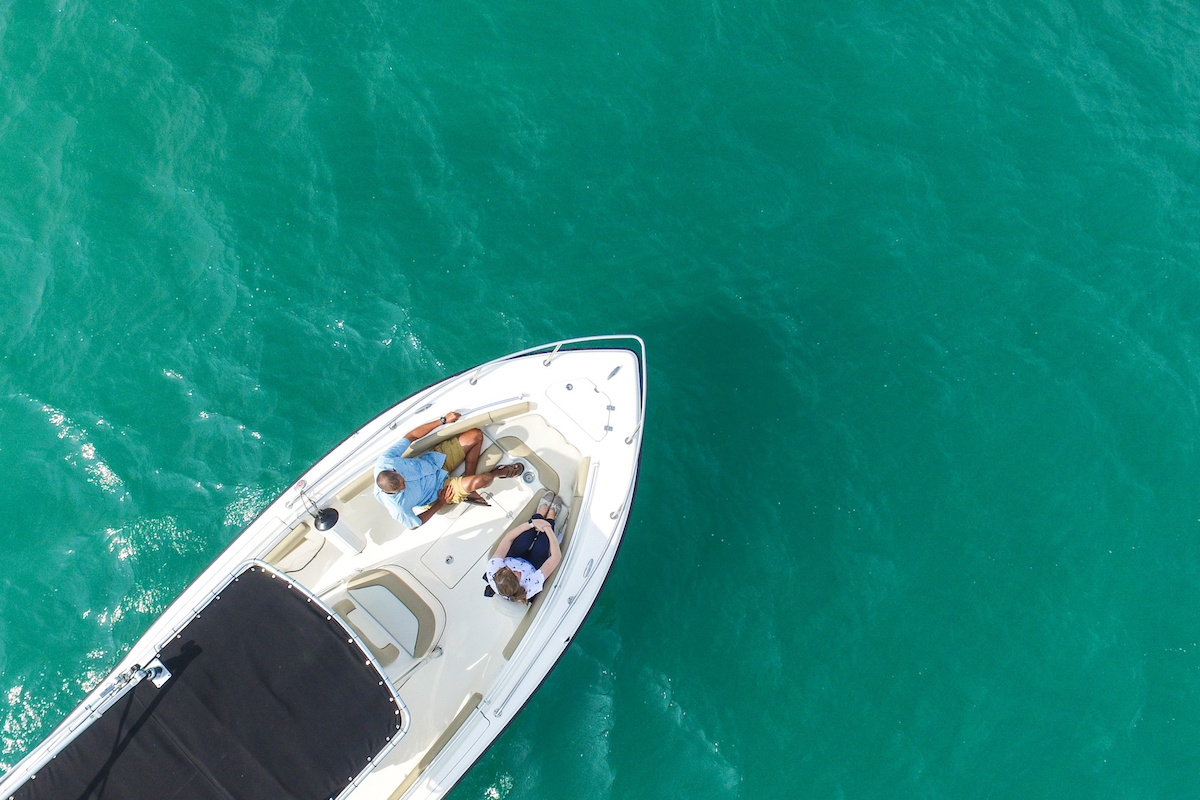
Buying a boat is always an exciting time, and for the best experience possible, it's always a good rule of thumb to work directly with a professional boat dealer or manufacturer (both of which have a wide selection of affordable entry-level models at reasonable prices); however, we understand that some boat buyers may opt to buy a used boat from a private seller in an attempt to save some money over the price of a new boat.
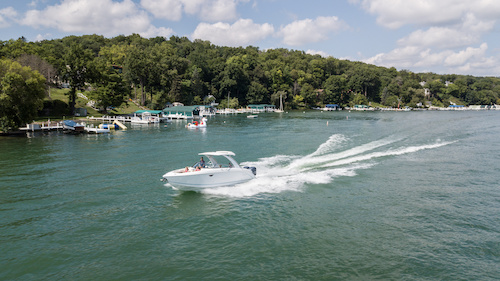
When you buy a pre-owned boat from a private party, you are taking on the usual business overhead incurred by a dealer—the shop time and parts the owner may have invested in the getting the boat ready for sale, and their cost to store and advertise the boat.
A private seller may also be more motivated to sell the boat, and thus willing to accept a lower-than-market price. Although, buying a boat from a private seller requires self-confidence and a little savvy because this is definitely a “buyer beware” situation. Once the deal is done you’ll have no warranty and little recourse if there is a problem.
That said, thousands of boats change hands between owners every year, usually without an issue. Here are some tips that can help make your deal a good one.
23 Most Affordable Entry-Level Boat Models
Buying a Used Boat Checklist
1. finding a used boat for sale.
There are dozens of ways a private party can list a boat for sale, from boat-specific websites to the bulletin board at your local bait shop. When you find a boat that interests you, try to set up a phone call rather than an email dialogue, which can be easily used by a scammer. Don’t even consider buying a boat unseen—if the boat is across the country at least have someone you trust look it over in person.
Ask some basic questions to pre-qualify your seller, such as:
- The location of the boat;
- If it’s ready to put in the water;
- Are service records available and the title in hand;
- And perhaps the most basic—why are you selling this boat?
If you feel good about the seller and still like the boat, set up an in-person viewing.
2. Inspecting the Boat Before You Buy
You’ll next want to inspect the boat, and the complexity of this step depends on the complexity of the boat; evaluating an aluminum fishing boat with a tiller-steer outboard is a lot easier than process of examining a 30-foot, multi-engine center console boat. And, the bigger and more-expensive the boat, the more you’ve got on the line.
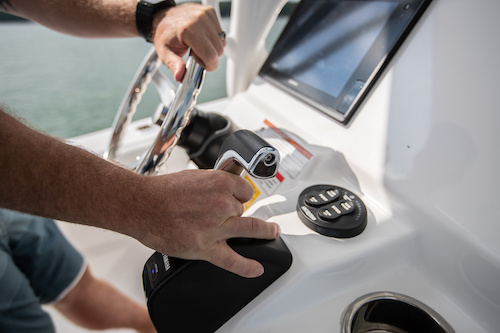
For smaller boats kept on a trailer, there’s some advantage to seeing the boat at the seller’s home or business—if the seller’s garage, for example, is clean and organized it’s likely the boat has been well maintained. If the place is a mess, it could be a red flag.
3. Conducting a Sea Trial
You’ll want to sea trial any boat. For smaller boat, meet at the launch ramp, so you can also get a look at the trailer.
Have the seller show you any features of the boat, and then splash it an go for a long enough ride to warm up the engine and check that all systems are working—the engine starts easily and sounds smooth; the trim functions; the lights, electronics, instruments and audio system are working; and pumps for live wells and bait wells do their thing.
How to Conduct a Sea Trial
4. Hiring a Marine Surveyor
For a bigger, more expensive boat it pays to hire an expert—for a few hundred dollars a professional marine surveyor will conduct a condition and valuation (C&V) survey and sea trial for you, and show you any issues they spot on the boat. The surveyor performs the same service as a house inspector you’d hire before making that purchase.
This is the best way avoid buying a boat with significant issues, such as blistering in the hull or a water-logged transom. Consider having a professional technician separately inspect the engine(s). Engine issues are the most-common problem encountered by used-boat buyers, and can be costly to remedy. Also inspect the trailer tires, wheel bearings and lights. Surveyors usually charge by the boat length, at $15 to $25 per foot. Issues that come up in these inspections can be addressed before closing the sale, or can be used as a point of negotiation. In some cases, a lender will require a professional survey to close the deal.
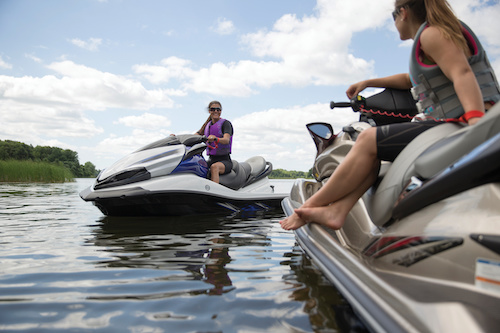
5. Check Titles and Liens
Most states require a title for boats over 16 feet in length.
- Check the title to make sure it’s valid, that there are no liens on the title, and that the HIN (Hull Identification Number) on the title matches that of the boat.
- You’ll find the HIN on the upper part of the starboard (left) side of the transom. In some states there may be a separate title for the trailer.
- If the boat is not required to have a title, ask to see a bill of sale from when the current owner purchased the boat, as proof that they are the true owner.
6. Draft a Purchase Agreement or Bill of Sale
Finally, draw up a boat purchase agreement or bill of sale. You may find a purchase agreement form on a state government website, or BoatUS offers blank forms, as does the U.S Coast Guard . The agreement should specifically list all items or accessories you expect to be included in the sale, such as electronics (include serial numbers), spare propellers, and even coolers or dock lines.
Is a Pre-Owned Boat Right for You?
Buying a boat from a private party takes some extra work—tasks a good dealer would do before putting the boat up for sale—but the effort can pay off with a lower purchase price.
New or Pre-Owned Boats: How to Decide What Type of Boat to Buy
You Might Also Like:
- The Ultimate Boat Buyer's Guide
- Why Should You Buy a Certified Boat?
- First Time Boat Owner's Checklist
- Best Boats for Beginners
- Find the Right Boat for Your Lifestyle
Join Our Newsletter!
Get community news, buying bargains, and how-to guides at your fingertips.

The Ultimate Guide on How to Buy a Used Boat
B uying a boat is a path toward fun in the sun and outdoor adventure with friends and family. Over 140 million people worldwide enjoy spending time on the water on all types of boats, and you can join their ranks by shopping for your favorite boat styles near you. The first step toward enjoying the benefits of boating starts with learning how to buy a used boat.
Used boats provide the same freedom and fun at a much lower price. You’ll enjoy a lower barrier to entry to get out on the water and meet up with friends on those sunny summer afternoons.
The good news is that you’ve found the perfect guide to take you through buying a used boat. Continue reading to start shopping for vessels you love today!
Set a Budget
Setting a budget is essential when shopping for used boats near you. Boats are expensive assets, and it’s easy to get carried away by more expensive options providing impressive amenities and luxuries.
Your budget should cover boat insurance, the cost of maintenance and repairs, and the delivery fee. These charges add up and can quickly take your favorite types of boats outside your budget. Create a firm price and stick with it when shopping for different types of boats.
Determine Your Needs
Different types of boats provide various benefits and experiences when out on the water. It’s critical to determine which type of boater you are. If you crave speed, a sailboat is going to be a disappointment.
Consider fishing boats to hit deeper water and try your luck for rare and delicious fish in the ocean. A sailboat is perfect for a leisurely experience with friends and family on the water. It’s also worthwhile to consider the bodies of water you’ll use your boat on.
Check the Canvas
The canvas on the boat is one of the first things to check when exploring your options. Most boats come equipped with a canvas package to provide shade and comfort for occupants. Don’t trust the previous owner or dealer when they claim the canvas is in “like new” condition.
Unfurl the canvas and check its condition to determine if it needs repairs or replacement. Check the snaps and look through the clear vinyl windows on the boat to ensure they’re in top-notch condition. It’s best to ensure you get fair value for your hard-earned money when buying a boat.
Look for Red Flags
There are several red flags when checking out your favorite boats for sale in your area. These red flags include signs of past damage and future problems that will cost you more money in maintenance. Ignoring these signs could result in significant expenses and a frustrating ownership experience for yourself and your family.
The first place to check when inspecting a boat you want to purchase is the bellows. The bellows look like an accordion, and they’re designed to protect the boat’s control cables and other sensitive parts. Damage to the bellows is a bad sign that you’ll need to spend more money to fix the boat before making it seaworthy.
It’s also wise to check the boat’s hull for cracks and other signs of damage. A cracked hull could result in significant water damage and worse if left unrepaired. A crack is a sign that the boat has been in a crash and a sign you should get uninsured boater coverage .
The engine and steering are other components to look closely at before buying a boat. Have the boat’s owner start the engine and let it run to listen for signs of damage or wear and tear on the moving parts. Smoke is another indicator that the engine needs service or repairs.
Check the steering wheel to ensure it’s responsive to the rudder. Driving a boat with unresponsive steering is dangerous for you, your passengers, and other boaters.
Get a Marine Survey
A marine survey is similar to having a mechanic inspect a vehicle you’re interested in buying. It’s an excellent way to enjoy peace of mind when learning how to buy a used boat. The mechanic will give you a clear breakdown of what the boat has been through and any maintenance issues to expect while owning the boat.
The surveyor will likely charge based on the size of the boat styles you’re considering. It’s a good rule of thumb to pay between $20 and $25 per foot for the boat you’re having inspected. The inspection includes an out-of-water check, survey report, and sea trial test.
It’s an additional cost that could save you thousands of dollars when learning how to buy a used boat. Eliminate risk and find the best vessel to provide the benefits of boating to your family.
Negotiate a Deal
Negotiating is a challenging aspect of buying a boat, but getting the best deal is essential. Use your knowledge of the boat’s condition and any necessary repairs to work toward a lower price. You can proceed confidently when you know the price of similar boat styles and conditions.
Knowing the market equips you with everything you’ll need for a straightforward negotiation process. Don’t lose hope if you find a boat you love that needs some TLC. Use that knowledge to get a lower price and the boat your heart desires.
Protect Your Investment
When learning how to buy a used boat, the last step is to protect your investment with boat insurance coverage. Insurance will help you repair your boat if you’re involved in an accident. It’s also wise to consider the warranty coverage on your new asset to save money on repairs and maintenance.
Now You Know How to Buy a Used Boat
Learning how to buy a used boat is an intensive process, but there are several steps to take for peace of mind when finding the perfect vessel for your family. Determine your ideal boating experience, and shop for the types of boats that fit that description.
Pay for a marine survey for peace of mind, and check troublesome areas for red flags before buying. Use your market knowledge to negotiate a fair price when buying a boat.
Making a significant purchase can be stressful without the best guidance. Check out our Finance blog content to help your money go further today!
This article is published by NYTech in collaboration with Syndication Cloud.


VIDEO
COMMENTS
The easiest way to narrow down the list of potential deals is by doing your own pre-survey inspection. Below are some of the major areas of boat inspection any buyer would want to become intimate with, as well as some common problems associated with each. Engine
So You Want to Buy a Used Sailboat: Inspecting the Boat Boat Buying, Sailing Steps to consider when boat shopping, inspecting a used boat, inquiring with a broker and reaching a decision to purchase a used sailboat In my last article, I discussed the thought process one might use to decide if now is the time to buy a used sailboat.
The first involves a thorough inspection of the boat by the prospective buyer, and the next step is to have a professional survey conducted after you have made an offer for the boat, but before you close the deal and take possession of the vessel. Your Inspection of the Boat.
Inspect the bottom of the mast and electrical wiring that comes out of it at the bottom. Also check where the mast goes through the deck to make sure it is waterproofed. Look at the electrical panel, open it if you can to see the condition of the wiring and connections. How does it look?
Inspecting a Used Sailboat firefighterdave 477 subscribers Subscribe 65 Share 2.9K views 1 year ago Things to look for when evaluating a small cabin cruiser sailboat; including the most common...
Inspect the used boat with a checklist Perform a sea trial Check the boat title and lien history Negotiate the price Organize a payment method with the seller Draft a bill of sale These instructions apply to a boat buyer purchasing any type of used vessel from sailboats to yachts and pontoons. 1. Find A Pre-Owned Boat For Sale
1) Hull You want to start your inspection with a quick walk around the boat for a general look. Check out the appearance of important parts of the hull such as the strakes, chines, and stem. Are there any cracks, peeling paint, and depressions? Tap the entire hull with the plastic handle of a large screwdriver or mallet.
A rig surveyor may be needed for sailboats where the individual goes up the mast, checks the condition of the shrouds and stays and possibly reviews the condition of the sails. Other types of surveys include the appraisal survey, which may be used for estate and divorce settlements or for valuation of a vessel that is donated to a charity.
The hardest thing about buying a used fiberglass sailboat is keeping your head straight. With a new boat you (in theory, at least) get what you pay for, but. The hardest thing about buying a used fiberglass sailboat is keeping your head straight. ... When inspecting boats, bring a flashlight for looking into various nooks and crannies. Take ...
Conducting inspections and knowing what to look for when buying a used boat are vital. Pre-Inspection Checklist Ask to see servicing and maintenance records. Knowing a boat has had regular servicing and maintenance is a very good start and learning about past repairs may give you the chance to ask worthwhile questions.
Advertisement Looking out for these problem areas can save you time and money. In this article we examine problems specific to older sailboats. Because many of these issues involve rot, corrosion, or manufacturers' defects and are therefore not covered by insurance, finding them early can avoid expensive headaches later. Rig and Mast
Buying a used sailboat can be an exciting and fulfilling endeavor for sailing enthusiasts. Whether you're a seasoned sailor or a novice, purchasing a pre-owned sailboat offers unique advantages. It's crucial to approach the process with careful research, planning, and inspection to ensure you make a wise investment.
Used Boat Inspection If you find some problems in external inspection, try to estimate how much it may cost to repair the damages. Have a rough calculation to add to the expenditure list. For example, painting a boat will cost you time, energy, and money. Oil testing
Well, whether you're buying new or used, be sure to inspect any boat BEFORE you buy it. You're ready to buy a boat. What's your next move? Well, whether you're buying new or used, be sure to ...
How To Inspect A Boat Before Buying: You need to inspect three major parts of a boat before buying it. You need to inspect the engine, the boat's hull, and the components that are in the boat. Here is a step by step guide to walk you through inspecting a boat and it's components before purchasing it to make sure you don't buy a dud!
Start by inspecting the important parts such as the engine, battery, and hull. Any issue like leaks, holes and other damages is a red flag. From there, examine the rest of the vessel. Finally, check the title for any hitches like outstanding loans. Table of Contents [ hide] Your Used Boat Checklist. 1.
Buying a used boat can save you a lot of money and bring you years of fun and enjoyment on the water. If you don't trust yourself to evaluate the condition of a used boat, consider hiring an accredited marine surveyor. Similar to a house inspector, a marine surveyor will perform a comprehensive structural integrity and systems inspection.
6. Have the boat hauled. If the boat is not on a trailer, arrange to have it hauled to inspect the bottom for obvious defects such as hull blisters, damaged running gear, excessive fouling, broken trim tabs, etc. 7. Look for decay or rot. This is a tough one because transom or stringer rot might not be obvious.
A sea trial is a crucial part of the used boat inspection process, as it allows you to evaluate the boat's performance and handling on the water. During the sea trial, pay attention to the boat's acceleration, steering, and maneuverability. Check for any unusual vibrations, noises, or smells that may indicate a problem. Hire a marine surveyor
Your inspection should begin with the exterior, as even an untrained eye can notice damage and neglect. The hull should be clean, free of barnacles and algae. Unless you are dealing with a smaller bass boat, cracks and dents are clear warning signs to walk away from the purchase.
Boat Inspection Checklist: For Buying A Boat By Mathew F Updated on July 8, 2023 This article serves as a comprehensive guide to boat inspections, providing a detailed checklist to ensure you buy a vessel that is safe and seaworthy. Boat inspections can be daunting, with so many components to check and potential issues to uncover.
Table of Contents Complete Checklist For Buying Used Boats: The first area you should concern yourself with is the actual condition of the boat. If the boat's condition is poor, the maintenance history and the fair market value of the boat might not matter. Here is what you'll want to look into when assessing the boat's condition: 1) The Hull
23 Most Affordable Entry-Level Boat Models Buying a Used Boat Checklist 1. Finding a Used Boat for Sale There are dozens of ways a private party can list a boat for sale, from boat-specific websites to the bulletin board at your local bait shop.
The first place to check when inspecting a boat you want to purchase is the bellows. The bellows look like an accordion, and they're designed to protect the boat's control cables and other ...